
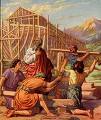
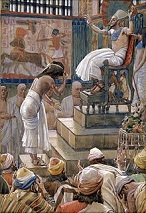


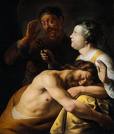












TLW's Bible Historyscope |
By T.L. Winslow (TLW), the Historyscoper™ |
© Copyright by T.L. Winslow. All Rights Reserved. |
Original Pub. Date: Mar. 8, 2016. Last Update: Sept. 24, 2024. |









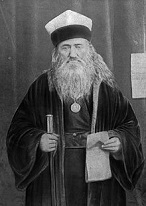

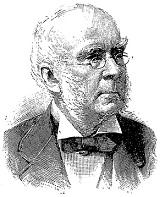


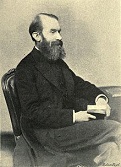
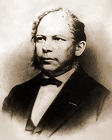
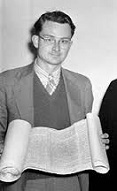
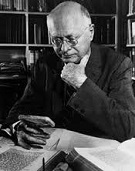
Westerners are not only known as history ignoramuses, but double dumbass history ignoramuses when it comes to Bible history. Since I'm the one-and-only Historyscoper (tm), let me quickly bring you up to speed before you dive into my Master Historyscope.
The Hebrew Bible canon consists of 24 books of the Masoretic Text. Is it pure history, part history, all fiction? Who wrote it, when, and why? This historyscope attempts to play both ends against the middle, just hold on, patience is a virtue. First, some modern scientific theories that you need to know.
In the late 7th cent. or 6th cent. B.C.E. according to modern "scientific" Bible scholars, the Pentateuch (Five Books of Moses) (Torah) incl. Genesis, Exodus, Leviticus, Numbers, and Deuteronomy begin to be composed by four different sources, which are collated into the final version in the 5th cent. B.C.E.; the first two are "J" (Jahwist/Yahwist), living in the southern Kingdom of Judah, and "E" (Elohist), living in the northern Kingdom of Israel; in the 6th cent. B.C.E. "P" (Priestly) writes the first chapter of Genesis, and "D" (Deuteronomist) writes Deuteronomy; there are two versions of the creation story in Genesis; E's version of creation (Gen. 1:1-2:3): "In the beginning (Bereshith) God created the heaven and the earth. And the earth was without form, and void; and darkness was upon the face of the deep. And the spirit of God moved upon the face of the waters. And God said, 'Let there be light'; and there was light..."; J's version of creation (Gen. 2:5-7): "At the time when Yahweh God made earth and heaven, there was as yet no wild bush on the earth nor had any wild plant yet spring up, for Yahweh God has not sent rain on the earth nor was there any man to till the soil. However, a flood was rising from the earth and watering all the surface of the soil. Yahweh God fashioned man (adam) of dust from the soil (adamah). Then he breathed into his nostrils the breath of life and thus man became a living being."
About 7,200,000 B.C.E. the Messinian Age (Salinity Crisis) begins (ends -5.3M), in which the Mediterranean becomes separated from the Atlantic and becomes shallow, losing 5K ft. of depth, with a retraction of the shores that washes out underground oil and gas with river streams in the Nile Delta, and forms a saltwater sea gorge invading the Nile as far S as Aswan; primates migrate from Africa to S Spain across dry land (Am. Museum of Nat. History); some Atlantic eels, which breed in the Sargasso Sea (S of Bermuda) become separated E of Gibraltar, making that their new breeding ground? - what an eely mess?
About 5,330,000 B.C.E. Gibraltar Dam keeping the Atlantic out of the Mediterranean breaks, causing the Zanclean Flood (Deluge), flooding the Mediterranean desert with 1 mi. of saltwater within 50 years, creating the 40-mi. x 9-24 mi. x 1K ft. deep Strait of Gibraltar, with entrance at the Pillars of Hercules incl. the Rock of Gibraltar (world's most famous rock?) on the S point of the Iberian Peninsula, and Mt. Abila (Abyla) (Sierra Bullones) (Monte Hacho) in Ceuta, N Africa, or Jebel Musa in Morocco, N Africa.
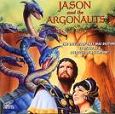



About 5600 B.C.E. according to geologists Walter Clarkson Pitman III (1931-) and William B.F. Ryan of Columbia U. in 1997, a catastrophic Great Flood creates the Black Sea (Pontus Euxinus) when the Mediterranean creates a giant 30-mi. by 1-to-4 mi. crack called the Dardanelles (Gr. Hellespontus) (Turk. Cannakkale bogazi) (between Asia Minor and the Gallipoli Peninsula of Europe), connecting the Aegean (Mediterranean) Sea with the Sea of Marmara (Propontis), and then flushes over the even narrower (20 mi. x 0.5-2.75 mi. x 400 ft. deep) crack called the Bosporus (Bosphorus) Straits (Bosporus Thracius) (Karadeniz Bogazi) (Gr. "Ox Ford", since the goddess Io turned into a heifer and swam it) (originally a spillway for freshwater flowing into the Aegean Sea), and floods the freshwater Euxine Lake (should be White Is Right Lake?) (the S end later called the Golden Horn, one of the largest natural harbors on Earth) with a force 400x that of Niagara Falls, the sound carrying for 60 mi. and turning it into a mixed 6K-7K ft. deep, 165K sq. mi. (750 mi. x 380 mi.) fresh-saltwater body characterized by brutal (mainly winter) storms and a lethal anoxic bottom layer full of hydrogen sulfide, with the freshwater flowing toward the Bosporus on the top, while the saltwater comes in underneath 40 ft. down above the anoxic sublayer in a swift current (made swifter for 10 mo. of each year by winds), causing it to become impassable, and the shores unlivable, and the Epic of Gilgamesh to later call it "the waters of death", Pliny the Elder to call it Pontus Axenus (Pontos Axeinos) (Inhospitable Sea), and the Turks to call it Karadeniz (Harbinger of Death); later some jokesters call it the Pontos Euxeinos (Hospitable Sea); the Greeks call the Dardanelles the Hellespontus because Helle alleged drowns there while fleeing with the Golden Fleece; Leander (Gr. "lion man") dies in the Hellespont during a nightly crossing from Abydos to visit his virgin-vowed babe Hero, a priestess of Aphrodite at Sestos, whose usual lamp in the tower is extinguished by a storm, and when his body washes ashore in front of her she throws herself in after him and drowns; lame Lord Byron swims it in 1810 C.E. to prove he's a lion man hero and not a girlie man?; the Black Sea becomes a challenge to sailors, engendering the 7-11 (July-Aug.-Sept.-Oct.-Nov.) story of Jason and the Argonauts (sent from Thessaly to fetch it from Colchis in modern-day W Georgia by his uncle King Pelias of Thessaly, he gets Hercules to join, but Herc's boyfriend Hylas is lured by nymphs on the coast of Mysia in Asia Minor, causing him to jump ship to look for him), until they figure out how to hop from island to island between storms, and drag a 40-ft. anchor to let the saltwater layer tug them along; the flood causes dispersion of farmers to Europe and Asia, incl. proto Indo-Europeans up the Dnieper River, Semites and Ubaids S to the Levant and Mesopotamia, Kartvelians to the Caucasus Mts., Linearbandkeramik (LBK) farmers up the Dnieper River over the Carpathians through Prague into the Rhineland N of the Alps (continually leapfrogging for reasons unknown?), Vincas farmers up the Danube River into the Hungarian Basin, Hamangians into Thrace, Danilo-Hvars through the Aegean and Ionian Seas into the Dinaric Alps on the E coast of the Adriatic, and Tocharians E to the Tarim Basin S of the Tien Shan Mts. and N of the Tibetan Plateau in Chinese Turkestan (later the route of the Silk Road).

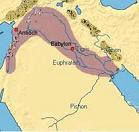


In 4004 B.C.E. at nightfall (6:00 p.m.) before Oct. 23 (Sun.) (autumnal equinox) is the date of the Creation, according to Protestant Bible fundamentalists, based on the work of Irish Anglican Archbishop James Ussher (Usher) (1581-1656), who in "The Annals of the World" (1650) dates the birth of Christ in 4 B.C.E. (so Darwinian evolution is the Fall of the House of Ussher?); end of the Sixth Day (land animals and man created); Adam (d. -3074) (Heb. "red", as in dirt or maybe blood, the sacred mojo of Jehovah?) is created from the dust of the Earth (Gen. 2:7); Noah's birth is 1,056 years ahead (-2992); (the original think outside the bun wasn't a good idea?) the Garden of Eden, the birthplace of the human race, is the source of four rivers, the Euphrates (Prath), Gihon, Pishon (which encircles the entire land of Havilah), and Tigris (Hidekel), indicating either that it is in the snow-covered mountains or that there is no snow but that it receives a constant source of rainfall, making it a lush garden where food and medicine grow on trees and all humans have to do is tend them and live practically forever, as long as they don't disobey God (i.e. sin), which he tests them by telling them that one special tree is not to be eaten from, the Tree of the Knowledge of Good and Bad (Evil), which is not necessarily special in itself but is just an easy-to-obey test, which doesn't stop them from doing it anyway, introducing Sin into the world, causing God to instantly judge them as worthy of death and have them expelled from Eden so they can be die eventually despite any and all technology they can come up with to feed, clothe, and shelter themselves in the cruel world, while being barred from directly talking with God anymore, leaving them to their new god, I hope you know my name, please allow me to introduce myself, Satan, Heaven's Top Model, originally the 2nd of God's sons (the Logos being the first), who was originally given the prestige job of "covering angel" for newly-created humans, the first material creatures created in God's image (hence all the complicated gray junk in our skulls), and are given God's blessing of living forever while multiplying and filling the Earth and subduing it through the seed of the original perfect sinless man Adam, who can talk directly with God if he wants to and doesn't need a Savior yet? Too bad, Satan gets tired of working in the department store and letting little humans sit on his knee, and grows envious of God, figures these inferior humans can be subverted to worship him instead, and goes to work with the Great Deception, appearing in the form of a naughty girl's toy and getting a little too friendly with "weaker vessel" Eve (the first cunnilingus?), after which "the Serpent beguiled me and I did eat" of the fruit of the forbidden Tree of Knowledge of Good and Evil and sin (disobey an order of God, who made sinning both so easy and so hard, depending on whether you love him); then, even worse, she leads her lawfully-married-under-God husband Adam to do it for fear of losing his helpmate (tailor-made just for him out of his rib) and ending up as a lonely people counting crows again? Too bad, this leaves God standing in the wind, as sin is the ultimate grief man can give their all-loving Creator, who, as an all-just judge, must reverse the Blessing and institute the Curse, kick them out of the Garden of Eden (where life is easy and food and medicine grow on trees, and animals are all tame and vegetarian), and bar them from the gates by an angel with a flaming sword (Gen. 3:24), after which the area turns into a sour grapes forbidden zone overgrown with vegetation? Adam and Eve had perfect DNA, and all of their descendants (born outside of Eden) suffer from degraded DNA? That means they were lily white? Once he's past that problem, the fallen angel Satan (opposer) (serpent) (Rev. 12:9), AKA Lucifer (Light-Bringer, appearing to be Light) (Isaiah 14:12-13) and Devil (liar, slanderer) (1 Peter 5:8) (the original Elvis?), who sinned first, before Eve and Adam, and who is himself doomed to die and knows it, decides he'd rather rule in hell than serve in heaven, and keeps his new groupies deceived that the world is still their oyster, death is natural, but that if they stick with him and do his walk they're going to become as gods and know right from wrong on their own outside of God's favor, therefore stayin' alive, stayin' alive forever, when actually they're his slaves, told what to think and do, and led down the er, garden path as they are under judgment of eternal death by their wronged Creator and Supreme Court? So what do they do? The wrong thing? Instead of repenting, telling Satan to stuff it and trying to get right with God, they continue to sin and let themselves be used, abused and losed by Sick Santa, spreading their sin to their children, and filling a fallen Earth with fallen people more and more openly worshiping Satan as their god after totally alienating themselves from the Real Thing Big J (Jehovah)? Never fear, God-And-Man-No-Religion-Modern-Love, the Sun's coming up, as Big J knows the End from the Beginning, and is already an infinite number of moves ahead of his opponent Jim the Bow Snake, and has already put a Redemption Plan (Gen. 3:15) in place to turn the Curse back into the Blessing, after man earns it, not by doing good works expecting to pay the fine and avoid the death sentence, but by being faithful to the Invisible God no matter what bull Satan can tempt him with, and paying the one and only ransom God will accept, namely, not all of Nature Talks To Me, but Jesus swinging in the breeze? But that's where you come in? As a day is as a thousand (or thousands) of our years with God (2 Peter 3:8, Psalms 90:4), it will end up taking 4K+ years to implement, as humans reproduce into the billions and all the variations on the board get played? Meanwhile, God makes the Earth livable, but with no free lunch, i.e., only at the expense of eternal toil, pain in childbirth, sickness and disease caused by the loss of perfection (Gen. 3:16-19)? You got X-ray eyes? Too bad, until the game is played out this is Satan's world now, and he keeps accusing God of being unable to maintain the loyalty of man without giving him everything for free, and even appears in his court (Job chap. 1) to make a motion to allow him to have a free hand to afflict him with curses to show God he's right that even a righteous man will blame and curse God instead of him? Yi yi yi, Little China Guy TLW isn't anywhere near being born yet, but when he is he finally figures out that his sources for GTT are untrustworthy, and worse, that that gut feeling that the truth is horrible, horrible keeps bugging him, because maybe it's all true, and nobody knows me, nobody knows my name not, and Bad S has really been from Day One eternally working to keep all of Adam's seed separated from and not right with God with a legion of deceptions, using the carrot and stick approach to trap them into worshiping idols and false gods (really Satan's demons behind phony masks, with whom it is a giant mistake to even attempt to communicate with), using any trick to win the million tax-free bucks in Survivor: Earth, incl. taking credit for luck and coincidence, posing as dead souls to trick their dupes into thinking they're communicating with the dead after they sell their living souls first, and low blows forever, doing what he did with Eve, perverting gift of fertility along with his command to be fruitful and multiply, don't worry, be happy, you're been given everything and it works, and warping it into addictive, self-destructive, super-sinful lust fulfillments, holding up a mirage of an Edenlike state of happiness, when the con is that Satan is a piker, and God decreed death as the ultimate wages for sin, and everybody from Adam and Eve down knows it whether they want to admit it or not, and being Chinese is no excuse? You're so pretty? Those are excellent words and your long tongue what? But Shake-It-Shake-It-What's-My-Line Wiley Coyote even tries to make that judgment into a lure to do it now while one can, for tomorrow you die and living too long is a drag, so party hearty and leave a good-looking corpse, and, like a chess game, the Devil works on each and every human mind 24/7 to bring him/her down from their original perfect relationship with the Creator, constantly trying to make them vulnerable, then finding their price, be it human sacrifice, sexual appetite, gluttony, astrology, magic and mediums, wealth and power, the Rolling Stones and Elvis, or above all, mass organized team-playing war (mass slaughter and rape, always pushing technology for more kill for the buck oh shut your mouth), ever seeking to make crime and sin a legal right and lifestyle; thus, history after Eden is a story of Good vs. Evil, White vs. Black, Christ vs. Antichrist, God vs. the Devil, and so it's to Beelzebub's advantage to twist history any way he can, and substitute his own, which makes two shiny pictures of himself, one in each of our eyes? But God is Good, and is always quite close at hand if you get Satan behind you, and being invisible and unable to communicate with sinful you directly because he's too holy (separate), he's already covered that base and directly inspired a tiny number of truly faithful down through the centuries with his Word, and insured that it has been transmitted and preserved, call it a miracle? So, listen to my heart beat, knowing what he has to cover up, the Genius Mister Sharky gets seriouser, says let's dance and fills up every program on the radio, twisting the Great Track of Time like a roller coaster, causing a strong deception that can fool even the wise and deceive even the very elect of God, because after all, ricochet, face the wall, Old Scratch and His Band are a higher form of life and keep concentrating despite our own chess players having to play tag team, ever coming and going, and therefore all of the Great Track of Time prior to the Fall, however scientific it appears, is actually sad Satanic fiction foisted on learned idiot-savants who are deceived into thinking they have a way to see backwards in time by looking at an endless coverup actively foisted on them by their former covering angel, who is actually covering his own tracks in maneuvering to become their total master and god, even though he knows that he and all his fellow fallen angels and human dupes will end up in the Galactic Computer's Bit Bucket when God calls the game and does a new Sysgen, with a lucky few saved for the New World, namely those supposed squares who took his word seriously and realized that all along it is checkmate in one move, God to Armageddon-1, if only we get humble, give up our seat and let him send in his you know what Son to play for us? Satan, I dedicate this Great Track of Time to you? Or is it all just a fairy tale and we came from da monkeys? Don't ask me I'm just doing my best to not have an opinion?
About 4,000 B.C.E. city-states begin to rise along the banks of the leisurely Euphrates River (Persian "ufratu" = good to cross over, Sumerian for fruitful) and swift Tigris River (Persian "tigra" = pointed, Sumerian "idigna" = swift river), and along the Nile River in Egypt; the Egyptians (Remetch, meaning "people") enjoy a lack of natural enemies, giving them the longest period of political stability in human history; the Nile is neat because it not only floods once a year and leaves a couple of miles of fertile silt on each bank, but it flows from S to N while the wind always blows from N to S because of the Mediterranean Sea, so that you can sail S and then turn around and float back N with the current.
About 4000 B.C.E. to 3000 B.C.E. iff the Bible's Adam and Eve story is true, giant Nephilim (Heb. "those causing others to fall or fail") inhabit the Earth until Noah's Flood (Gen. Ch. 6); "Now it came about, when men began to multiply on the face of the land, and daughters were born to them, that the sons of God saw that the daughters of men were beautiful; and they took wives for themselves, whomever they chose. Then the LORD said, 'My Spirit shall not strive with man forever, for he is indeed flesh; nevertheless his days shall be one hundred and twenty years.' The Nephilim were on the Earth in those days, and also afterward, when the sons of God came in to the daughters of men, and they bore children to them. Those were the mighty men who were of old, men of renown" - the origin of the Greek gods?
In 3874 B.C.E. Adam ("son of the red earth") (b. -4004) is 130 years old; Cain (Heb. "spear") slays Abel (Gen. 4:8), and utters the immortal soundbyte "Hashomer akhi anoki" (Am I my brother's keeper?); Adam and Eve's 3rd son Seth (Heb. "substitute") is born, continuing the line leading to Jesus Christ (Luke 3:23-38); sometime later Jubal, son of Lamech and Adah, and brother of Jabal (a descendent of Cain) becomes a musician and/or musical instrument inventor (Gen. 4:19-21).
In 3800 B.C.E. Iapetus' daughter Anchiale's son Cydnus' son Parthenius (Adam and Eve's 3rd son Seth?) founds the city of Tarsus in S Asia Minor.
In 3769 B.C.E. Adam (b. -4004) is 235 years old; Enosh ("mortal man, sick"), son of Seth (son of Adam) is born.
On Oct. 7, 3761 B.C.E. (Mon.) is the date of creation in the Jewish (Hebrew) Calendar, based on the work of Rabbi Hillel II in the 4th cent. C.E., and called 1 Tishri Anno Mundi 1; according to the Seder Olam of Rabbi Jose (Yose) Ben Halafta of the 2nd cent. C.E., Creation was on 25 Elul Anno Mundo 1 (about 1 year before 1 Tishri), and others place it at 25 Adar Anno Mundi 1 (6 mo. after 1 Tishri); either way, to get the Jewish year for any Gregorian year after 1 C.E., add 3760 unless it's autumn, in which case add 3761.
In 3679 B.C.E. Adam (b. -4004) is 325 years old; 90-y.-o. Enos' son Kenan (d. -3591) (Heb. "possession"), son of Enos (grandson of Seth) and his wife-sister Noam is born (Gen. 5:9-14).
-3609 Adam (b. -4004) is 395 years old; Kenan's son Mahalalel (Mahalaleel) (d. -2714) is born (Gen. 5:12-17).
-3544 Adam (b. -4004) is 460 years old; Mahalalel is 65 years old; his son (by Dinah?) Jared (Jered) (d. -2582) (Heb. "descend") (Gen. 5:15) is born.
In 3382 B.C.E. Adam (b. -4004) is a hefty 622 years old; Big-Eyed Goldberg, er, Righteous Enoch (d. -3017) (Heb. "dedicated") (d. -3039) ("seventh in line from Adam"), son of Jared and father of Methuselah is born, and his example of "walking with the true God" condemns sinner Adam (Gen. chs. 4-5, Jude 14).
In 3317 B.C.E. Adam (b. -4004) is 687 years old; Enoch (b. -3382) is 65 years old; birth of longevity champ (969 years) Methuselah (Metuschelach) (Heb. "man of the dart", "when he dies it will be sent", "man of Babylonian god Shelah") (d. -2392), son of Enoch, and father of Lamech, father of Noah (Gen. 5:21-7).
In 3130 B.C.E. Adam (b. -4004) is 874 years old; Enoch (b. -3382) is 252 years old; Methuselah (b. 3317) is 187 years old; birth of Methuselah's son Lamech (Gen. 5:25).
In 3074 B.C.E. Enoch (b. -3382) is 308 years old; death of Adam (b. -4004) at age 930 (Gen. 5:5).
In 3017 B.C.E. 365-y.-o. Enoch (b. -3382) is transferred by Jehovah to ? (Gen. 5:24, Jude 14).
About 3000 B.C.E. the licentious Baal, Ashtoreth, and Car (Moon godess) worshiping Semitic Phoenicians (Phenicians) (Kena'ani or Canaanites = "merchants") (Gr. "phoinix" = red-purple) settle the E Mediterranean coast, a long narrow (5 to 15. mi.) strip of land from the Orontes River or Eleutherus River in the N to Mt. Carmel in the S, bounded on the E by the Lebanon Mts.; they worship the Moon because it rules the tides, and they want to rule the seas?; the city-states of Arvad (Arwad) (Rouade), Gubal (Djebeil) (Byblos), Marathus, Ecdippa, Acco (Akko) (Acre), Simyra (Sumra) (Tell Kazel), Dor (Dora) (southernmost), Zarephath (Sarafind) (Sarepta), Tripolis (Tripoli), Berytus (Beirut) (modern pop. 2.25M/750K), and Sidon (Saida) (25 mi. S of Beirut) (first mentioned in the 15th cent. B.C.E. Tell el Amarna Letters), and Tyre (Sur) (Zor) ("rock") (from a double rock off the coast) ("daughter of Sidon") (50 mi. S of Beirut) are founded - white sidewall tire below the root?
In 2948 B.C.E. Adam would have been 1,056 years old if he hadn't done that no no in Eden; Methuselah (b. -3317) is 369 years old; birth of Noah (d. -1998) (Heb. "comfort", "rest") (Gen. 5:28-29), 10 generations from Adam; the Flood is 600 years ahead, and Abraham is 952 years (another 10 generations) ahead (-1996); the meaning of the names of Adam and his descendants all the way to Jesus make a coherent prophecy, starting with "The God-man is appointed, a mortal man of sorrow is born, the glory of God shall come down from heaven and teach men that by means of his death he shall bring rest and comfort to those who mourn." (Adam to Noah)
-2714 Mahalalel (b. -3609) dies at age 895.
-2582 Jared (b. -3544) dies at age 962.
About 2600 B.C.E. the Canaanite city of Jericho ("reah" = fragrant) ("Yareah" = Moon) is founded on the W bank of the Jordan River (modern-day pop. 20K), becoming known for its extensive walls with rectangular towers, and extensive cemetery with vertical shaft-tombs and underground burial chambers, with the nickname "City of Palms".
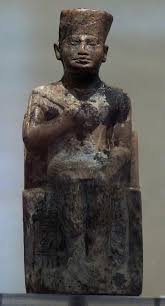

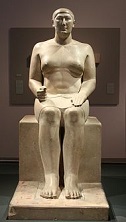
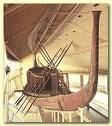
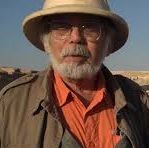

In 2551 B.C.E. Khufu (Cheops) (d. -2528) becomes the first king of the Fourth (4th) Egyptian Dynasty; his mother is Hetepheres (Hetapheres) I; Khufu builds the 450-ft.-high Great Pyramid of Khufu (Cheops) (Giza) at Al Jizah (Giza Plateau), 0.25 mi. W of the Nile River, becoming the tallest bldg. in the world until the 19th cent. C.E.; Pliny the Elder mentions it in his Natural History, saying that it is worshipped as a "divinity", and that "King Harmais was buried in it", it incl. a tablet explaining how Thoth, god of the night gambled with the Moon and won five days to add to the 360-day calendar outside the jurisdiction of Sun god Ra; the architect is man-breasted Hemon (Hemiunu), son of Snefru and cousin of Khufu; the work takes 100K workers 20 years, and uses 3M 2.5-15-ton stone blocks from Giza, the E bank of the Nile, and Aswan (600 mi. downstream) (only source of granite in Egypt), impoverishing the country and using up the entire male pop.; in 1954 C.E. the 125-ft. Solar Funeral Barque (Ship) of Khufu is discovered near the Great Pyramid; it was really built between -5K and -7K, as proved by the water weathering on the limestone? - John Anthony West (1932-); it was really built on an island, and originally had a gigantic statue of Anubis the watchdog?; the water weathering came from Noah's Flood? :); in 2007 C.E. Jean-Pierre Houdin (1951-) claims to have discovered how they built it, using an outer ramp for the first 140 ft. and a corkscrew-shaped inner ramp for the next 310 ft.; in 2010 the existence of dried mud brick tombs nearby are claimed to prove that the workers were not slaves - gaining the whole world and losing his soul?

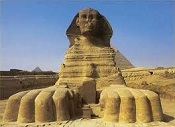
In 2520 B.C.E. Radjedef dies, and his brother Khephren (Khafre) (Khafre) (Chephren) (d. -2494) becomes king #3 of Egypt's Fourth Dynasty, going on to build the Great Sphinx of Giza and the Pyramid of Khafre (Second Pyramid of Giza).
In 2469 B.C.E. Methuselah (b. -3317) is 870 years old; Noah (b. -2948) is 501 years old; birth of Noah's youngest (eldest?) son Japheth (Heb. "enlargement") (Gen. 5:32).

In 2459 B.C.E. the traditional date of Noah's Great Flood; 489-y.-o. Noah (b. -2948) saves all air-breathing life on his Ark, incl. his four sons and their wives; after landing on Mt. Ararat in Turkey (highest mountain in the Middle East), the ramps come down and the Earth is repopulated; Ireland is populated by Magog, son of Japheth? - there must have been land bridges to all continents, right? Mt. Ararat is in the Caucasus Mts., so that's where White (Caucasian) is Right came from?
In 2446 B.C.E. Methuselah (b. -3317) is 871 years old; Noah (b. -2948) is 502 years old; birth of Noah's eldest son Shem (d. -1847) (Heb. "name") (Gen. 7:11).
In 2,350 B.C.E. another traditional date of Noah's Flood - Moo oink cluck gobble? Go ahead, let it snow?
When you guys go to the mall you'll have the network?

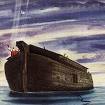
In 2,348 B.C.E. Methuselah (b. -3317) dies at age 969 (Gen. 5:27); 600-y.-o. Noah (b. -2948) finishes Noah's Ark, 300 cubits long x 50 cubits wide by 30 cubits high (438 ft. x 73 ft. x 44 ft.) (Gen. 6:15-16), which has 1.4M cubic ft. of cargo space and 96K sq. ft. of floor space on 3 floors (same as the Titanic) and holds at least the bare minimum of 43 kinds of mammals, 74 kinds of birds, and 10 kinds of reptiles necessary to restock the Earth; the waters of the Great Flood of Noah (Noah's Flood) (Genesis Flood) (Deluge) begin to fall in Nov. (Gen. 7:11); allegedly a protective water canopy hovering over Earth falls, at first drowning everything that breathes air, then part of it freezes, leaving a permanently raised ocean level with a new continental configuration (avg. ocean depth 2.5 mi., avg. land elev. 0.5 mi.) (incl. the 277-mi.-long 18-mi.-wide 6,093-ft.-deep Grand Canyon, the world's largest gorge?); since then we get too much direct radiation, causing the life span to plummet (and also conveniently causing all the hereditary skin colors?); whether the Great Flood happened or not, glaciers end up occupying 5.8M sq. mi. of the world's land surface, about 10%, an area the size of South Am.; if the Earth were to be flattened out, water would cover it to a depth of 2 mi.; if the Antarctic ice were melted, the ocean level would rise 240 ft., submerging one-quarter of the world's land mass; computer simulations by Nat. Center for Atmospheric Research in Boulder, Colo. in 2010 show how a land bridge could be created by a strong E wind at the junction of an ancient river and a submerged coastal lagoon along the Mediterranean Sea. The human Y-chromosome genetic clock backs-up the Bible's dating of Noah's Ark?
In 2346 B.C.E. Noah (b. -2948) is 602 years old; Shem (b. -2446) is 100 years old; Arpachshad (d. -1909), son of Shem is born, and lives 438 years (Gen. 10:22-24; 11:10-13; 1 Chron. 1:17-27); meanwhile Noah and his three sons and their wives get to work reproducing like rabbits, founding 70 main families, which spread out from Mount Ararat between the Black and Caspian Seas; "From these the nations were spread about in the Earth" (Gen. 10:32); Noah's son Japheth (Heb. "he expands") founds the 14 Indo-European families (Aryan speech): Ham (Heb. "heat") founds the 30 Afro-Asiatic families (Hamitic speech) through his four sons Cush (Ethiopians), Canaan (Canaanites), Mizraim (Egyptians), and Uncle Nasty, er, Phut (Put) (Libyans); Egypt is called the "land of Ham", and their deity Ammon is really Ham-on (Rye?); Shem (Heb. "fame") founds the 26 Asiatic families (Semitic speech); Japheth Branch: Gomer (Cimmerians N of Black Sea), Ashkenaz (SE of Black Sea), Riphath (Paphlagonians), Togarmah (Armenians), Magog, Madai (Medes S of Caspian Sea), Javan (Ionians), Elishah (near Greece), Tarshish (SW Europe and Spain), Kittim (Cyprus), Dodanim (Rodanim) (Rhodes and adjacent islands), Tubal (Tibareni in Asia Minor), Meshech (Phyrians in Asia Minor), Tiras (Tyrrhenians in the Aegean); Ham Branch: Cush (Ethiopians in E Africa and Arabia), Seba (E Africa), Havilah (SW Arabia), Sabtah (S Arabia), Raamah (SW Arabia), Sheba (SW Arabia), Dedan (Arabia), Sabteca (S Arabia/Ethiopia), Mizraim (Egyptians), Ludim (N Africa), Anamim (Egypt), Lehabim (Libyans), Naphtuhim (N Egypt), Pathrusim (Upper Egypt), Casluhim, Philistines (Palestine) (Heb. "Plishtim" = invaders), Caphtorim (Cretans), Put (N Africa), Canaan (W of Jordan River), Sidon (Canaan's son) (Sidonians or Phoenicians), Heth (Canaan's son) (Hittites), Jebusite (Jerusalem), Amorite (Palestine), Girgashite (W of Jordan River), Hivite (Central Palestine), Arkite (W of Lebanon Mts.), Sinite, Arvadite (Syrian coast islands), Zemarite (N of Phoenician Coast), Hamathite (N of Palestine); Shem Branch: Elam (SE of Mesopotamia), Asshur (Assyrians), Arpachshad, Shelah, Eber (Arabia, Mesopotamia), Peleg, Joktan (Arabians), Almodad, Sheleph, Hazarmaveth, Jerah, Hadoram, Uzal, Diklah, Obal, Abimael, Sheba, Ophir, Havilah, Jobab, Lud (Lydians of Asia Minor), Aram (Aramaeans and Syrians), Uz, Hul (near Armenia), Gether, Mash (Syro-Arabian Desert or N Mesopotamia).
In 2311 B.C.E. Noah (b. -2948) is 637 years old; Judah's 3rd son Shelah is born (Gen. 38:2-14).
About 2300 B.C.E. the Millennium Fever mother city of Jerusalem (Salem) ("peace") (Arabic "al-Quds" = the holy) (Yiddish "Yerushalayem" = teaching of peace) 35 mi. from the E shore of the Mediterranean Sea is founded by the Canaanite (Hittite?) (Hurrian?) (Amorite?) Jebusites (Shem and Eber, ancestors of Abraham?) on the ridge of the Judean Mts. between the N edge of the Dead Sea and the Mediterranean Sea, on the hard limestone Ophel (Heb. "fortified hill") above the Gihon (Heb. "to gush forth") Spring, which emerges from the Kidron (Heb. "dark, mourn") Valley to the E; the city was originally surrounded by thick green forests of almond, olive and pine trees.
In 2281 B.C.E. Noah (b. -2948) is 667 years old; 30-y.-o. Shelah's son Eber (Heber) (d. -1839) (Heb. "opposite side", "passage") is born, refusing to help build the Tower of Babel, keeping his language from being confused, and retaining the pure lingua humana of Hebrew, named after him (Gen. 10:21, Luke 3:35).
In 2247 B.C.E. Noah (b. -2948) is 701 years old; Shelah is 64 years old; 34-y.-o. Eber has son Peleg, during whose time "the Earth was divided" (Gen. 10:25).
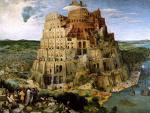

In 2217 B.C.E. Noah (b. -2948) is 731 years old; Shelah is 94 years old; Eber is 64 years old; Peleg is 30 years old; Peleg's son Reu (Ragau) is born. Construction begins on the Tower of Babel (Gen. 11:4), an attempt to disobey Jehovah's order to populate the entire Earth and instead build New York, New York, it's my kind of town, which Big J foils by confounding the workers' languages, rewiring their language circuits so that what they have here is a failure to communicate, and they do a Cool Hand Luke and ditch their own U.N. Bldg. (no translators), and go their own ways, forever at war while spreading all over the Earth? Was Babylon the original source of magic, divination, and astrology, and was the Tower of Babel built on the Dark Isle (al-Djezair) between the Tigris and Euphrates, containing eight tiers in an attempt to attain to immortality, becoming the source of the Eightfold Path of Buddha, the figure-8 twined serpents on the Caduceus (Staff of Hermes, AKA Mercury, AKA Thoth, AKA Prince of Tricksters, Joker, Jester, Fool), the I-Ching, Tarot Cards, the Game of Kings (Chess) and the Knights' Tour, the marriage of the Red King and White Queen, the secret of the peacock's tail, the sideways-8 figure for infinity, and the alchemical quest for the Philosopher's Stone, a cake made from a reddish-black powder, which is mixed with Aqua Philosophia, "heavy water" gathered from dew when the Sun is between the Bull and the Ram (when the water falling from the Moon is heaviest), creating the Elixir of Life (al-Iksir), which gives immortality if made correctly, but death if made incorrectly?
In 2185 B.C.E. Noah (b. -2948) is 763 years old: Shelah is 126 years old; Eber is 96 years old; Peleg is 62 years old: 32-y.-o. Reu's son Serug (great-grandfather of Abraham) is born.
In 2155 B.C.E. Noah (b. -2948) is 793 years old; Shelah is 156 years old; Eber is 126 years old; Peleg is 92 years old; Reu is 62 years old: Serug is 30 years old; Serug's son Nahor (grandfather of Abraham) is born.
In 2126 B.C.E. Noah (b. -2948) is 822 years old; Shelah is 185 years old; Eber is 155 years old; Peleg is 121 years old; Reu is 91 years old: Serug is 59 years old; Nahor is 29 years old; Nahor's son Terah (Terach) (father of Abraham) is born (Gen. ch. 11); his daughter (Abraham's half-sister) is Sarah; other sons incl. Haran and Nahor.
In 2100 B.C.E. Abraham (Abram) is allegedly born in Ur in S Iraq, or Sanliurfa (Urfa) (Edessa) in SE Turkey to Terah (Heb. "wild goat"); the age of the Biblical Patriarchs begins (ends -1400).
In 2095 B.C.E. is the alleged date of the birth of Abraham (Abram) in Ur of the Chaldees(modern-day Tell el-Muqayyar near Nasiriyah) in S Iraq, or Sanliurfa (Urfa) (Edessa) in SE Turkey to Terah (Heb. "wild goat"); the age of the Biblical Patriarchs begins (ends -1400).
In 1996 B.C.E. Abraham (Abram) (d. -1822) (Heb. "Father of a Multitude") (Gen. 11:26) is born in the Moon god Sin-worshiping Chaldean city of Ur in the land of Shinar in N Mesopotamia near the modern-day junction of the Tigris and Euphrates Rivers, 150 mi. SE of Babel (Babylon); the son (not the firstborn) of 130-y.-o. Terah (b. -2126), who is also the father of his wife Sarah (Sarai) by a 2nd wife; born 952 years after Noah in the 10th generation through Shem (352 years after the Flood); "The father of all those having faith while in uncircumcision" (Romans 4:11); may have learned about Jehovah from Shem; David is 14 generations ahead (-1085), and the Babylonian Captivity (-587/-585) is 28 generations ahead.
In 1986 B.C.E. Sarah (Heb. "princess") (Sarai) is born to Terah, father of Abraham (Abram), becoming his half-sister, wife, and mother of Isaac.
About 1956 B.C.E. Abraham moves from Ur of the Chaldees 600 mi. NW to the city of Harran in Paddan Aram in Upper Mesopotamia because Jehovah promises to make him a great nation (Gen. 15:7), and he travels with his half sister-wife Sarah (b. -1986) and his dad Terah (b. -2126) (Gen. 11:31), along with his childless adopted nephew Lot and his wife Pilah of Salt.
In 1986 B.C.E. Abraham's wife Sarah (Sarai) is born to Terah, father of Abraham (Abram) )
In 1910 B.C.E. Ishmael (d. -1774) (Heb. "God hears") is born to 86-y.-o. Abraham (b. -1996) and his Egyptian maidservant-concubine Hagar (Gen. 16:3-16), becoming father of the Ishmaelites (Arabs); "He will be a wild ass of a man, his hand against every man and every man's hand against him; and he shall dwell over against all his kinsmen" (Gen. 16:12); Ishmael's son Kedar (Gen. 25:13) is the ancestor of the Bedouins, known for their black tents ("I am black but comely... as the tents of Kedar" - Song of Solomon 1:5); Hagar is the first woman to be circumcised, by Sarah to make her less sexually attractive.
In 1897 B.C.E. Jehovah makes his circumcision covenant with 99-y.-o. Abram (1996 to -1822), thanking him for the offering of tasty foreskins as a substitute for sacrificing the entire boy, and changing his name to Abraham (Heb. "Father is Exalted") (Gen. ch. 17), making him the major promise that "a father of a crowd of nations I will make you" (Gen. 17:5-27, Rom. 4:11). After some kind of sexual hanky panky goes down that pisses-off Jehovah (homosexuality?), Sodom and Gomorrah (part of the five cities of the plain incl. Admah, Zeboiim, and Zoar) are destroyed, and Abraham's nephew Lot and his two daughters barely escape, losing Lot's wife to pillarosis voyeurosa - Gen. Ch. 19. A famine causes Abraham and Sarah to go to the Philistine city of Gerar, only to have the king take 89-y.-o. Sarah (b. -1986) into his harem, but Jehovah gets her sprung (Gen. 18:16-21:7).
In 1896 B.C.E. Isaac (d. -1717) (Heb. "laughter") is born to 100-y.-o. Abraham (b. -1996) and his 90-y.-o. wife Sarah (b. -1986) (Gen. 21), becoming the first infant Jew to be circumcised - I'm not crying I'm laughing?
In 1891 B.C.E. 5-y.-o. Isaac (b. -1896) is weaned, and 19-y.-o. Ishmael (b. -1910) is sent away with his mother Hagar after he pokes fun at the little weenie, beginning 400 years of affliction upon Abraham's offspring (Gen. 21:8-21, 15:13, ch. 25; Gal. 4:29); they flee S and settle in the wilderness, where Ishmael marries an Egyptian woman, fathering 12 desert nomad tribes, the Ishmaelites, who occupy C and N Arabia; whether the Bible is true or a fairy tale, by the 6th cent. C.E. the Muslims, who regard themselves as descendents of Ishmael, start the Ishmael Conspiracy, reversing the Hebrew Bible and claiming that Hagar was Abraham's #1 wife, not Sarah, and that Ishmael was his favorite son, not Isaac, and that Abraham chose Ishmael, not Isaac to be sacrified, and not on Mt. Moriah in Palestine, but on Mt. Ararat near Mecca; others, such as Hal Lindsey (1929-) claim that Jacob's twin brother Esau mixed with the Ishmaelites to create the Arabs, and that Armageddon will be caused by what amounts to a family dispute - what about the restraining order?
In 1878 B.C.E. Abraham's 40-y.-o. son Isaac marries Abrahm's grandniece Rebekah (Rebecca) (Heb. "connection", "snare") from Mesopotamia (Gen. 24:1-67, 25:20); Abraham marries Keturah, and in the next 35 years fathers six more sons, adding the Midianites, Medianites (Heb. "strife") (Arab. "perserverance"), and other tribes to the Israelites, Ishmaelites, and Edomites (Gen. 25:1-2, 1 Chron. 1:28, 32-34).
In 1871 B.C.E. Abraham takes his 25-y.-o. son Isaac (b. -1896) from Beer-sheba N to Mount Moriah (N of Salem) and offers him as a burnt sacrifice to Jehovah, believing that "God was able to raise him up even from the dead", but luckily Big J lets him substitute a ram at the last minute, and Big J is so pleased with the total package that he reinforces his covenant with a sworn oath (Gen. 22:1-18, Heb. 6:13-18; 11:17-19).
In 1836 B.C.E. Abraham (b. -1996) is 160 years old; birth of 60-y.-o. Isaac's (b. -1896) twin sons "wild man" Esau and "blameless" Jacob (Israel) (d. -1690) after struggling in their mother Rebekah's womb, causing Jehovah to tell her that two nat. groups would be separated from her inward parts and that the older will serve the younger (Gen. 25:22-26).
In 1821 B.C.E. Abraham (b. -1996) dies at age 175 (Gen. 25:7) after making his son Isaac his sole heir (Gen. 25:5-6); he is buried by his sons Isaac and Ishmael in the cave of Machpelah in Hebron where he had earlier buried his wife Sarah (Gen. 23:1-20, 25:7-10); his grandson (son of Isaac) Jacob is 15 years old, and somewhen from now he gets his hairy brother Esau to sell him his birthright as firstborn for a "swallow of the red" (lentil stew), because "Esau despised his birthright" (Gen. 25:29-34); Esau later gets the nickname Edom (Red) (Gen. 25:25-30); the Cave of the Patriarchs in Hebron, where Abraham and Sara are buried becomes a holy site for Jews and Muslims.
About 1800 B.C.E. the city of Nineveh ("exceeding great city") on the E bank of the Tigris River opposite modern-day Mosul, Iraq is first mentioned as a center of worship of Ishtar; it falls in -612. About 1800 B.C.E. the Akkadian epic Atra-Hasis ("exceedingly wise") is written on three clay tables, containing an account of the Creation and a great deluge; it mentions a god with planning capacity called Alla (Ilaweila), who led a rebellion against chief god Enlil (Elil) and was slaughtered and his flesh and blood used to create humanity; a copy is found dated to Hammurabi's great-grandson Ammi-Saduqa (-1646 to -1626), and another is discovered in the 7th cent. B.C.E. Library of Ashurbanipal; some claim he might be the Muslim god Allah since the Akkadians originally lived in Arabia.
In the 18th cent. B.C.E. the Akkadian epic Atra-Hasis ("exceedingly wise") was written on three clay tables, containing an account of the Creation and a great deluge; it mentions a god with planning capacity called Alla (Ilaweila), who led a rebellion against chief god Enlil (Elil) and was slaughtered and his flesh and blood used to create humanity; a copy has been found, dated to Hammurabi's great-grandson Ammi-Saduqa (-1646 to -1626), and another was discovered in the 7th cent. B.C.E. Library of Ashurbanipal; some claim he might be the Muslim god Allah since the Akkadians originally lived in Arabia, but if it was that easy Islam wouldn't be such a survivor, sorry.
In 1759 B.C.E. Isaac's 77-y.-o. son Jacob (b. -1836) flees Beer-sheba to Haran, the land of his forebears, and 62 mi. down the path he stops at Luz in the Judean hills, using a stone for his pillow, then dreams of Jacob's Ladder, upon which angels descend and ascend, and at the top of which is Jehovah, who confirms the divine covenant made with Abraham and Isaac (Gen. 28:11-13, 30, 31), uttering the immortal soundbyte: "By means of you and your seed all the families of the earth will certainly bless themselves", and how his seed will become like the dust particles of the Earth in number (Gen. 28:13-15), this wows him so much that he renames the place to Bethel (Beth El) (House of God), and he sets up and annoints a stone pillar, and promises to give him tithes (one-tenth) (Gen. 28:16-22); he spends 20 years in Haran.
In 1752 B.C.E. 84-y.-o. Jacob (b. -1836) marries his first cousins Leah (Heb. "weary") and Rachel (Heb. "ewe") (his favorite) (Gen. 29); actually, he worked seven years to pay father Laban for Rachel, but daddy reneges at the last minute and gives him the older hag Leah, but then throws Rachel in for another seven years of work, and kicks in fertile maidservants Bilhah and Zilpah; during the next seven years Jacob is blessed with many children (Gen. 29:30-30:34), incl. four sons from Leah, 1: Reuben ("behold, a son"), 2: Simeon ("listening intently"), 3: Levi ("joined") and 4: Judah ("praise"); two sons from barren Rachel's substitute slave girl Bilhah, 5: Dan ("God is my judge") and 6: Naphtali ("my struggle"); and two sons from barren Leah's substitute slave girl Zilpah, 7: Gad ("soldier", "luck"), 8: Asher ("felicitous"); Leah then goes fertile and bears 9: Issachar ("laughter"), 10: Zebulon ("give honor to"), and daughter Dinah ("justified"); Rachel follows suit and bears 11: Joseph ("Jehovah increases"), "son of Jacob's old age", followed sometime after the 7-year period by 12: Benjamin ("son of the right hand"); sometime after Rachel, wife of Joseph (Israel) (d. -1738) bears her 2nd son Benjamin and dies during childbirth (Gen. 35:16-20), and eldest son Reuben hooks up with daddy's concubine Bilhah (mother of Dan and Naphtali), causing him to lose the firstborn's birthright (Gen. 35: 21-26, 49:3-4, Deut. 27:20, 1 Chron. 5:1), 17-y.-o. Joseph is seized by his jealous brothers at Dothan 62 mi. N of Hebron and, at the suggestion of Reuben, pitched into a dry well (Gen. 37:2-24), then, at the insistence of Judah, is sold into slavery in Egypt to some passing Ishmaelites (ancestors of Muhammad?) for 20 pieces of silver (Gen. 37:28; 42:21); the bad boys bad boys whatchya gonna do lie to daddy that he had been killed by a wild animal (Gen. 37:31-33), and they all start suffering from a bad conscience; Judah then parts ways with his brothers and tents near Hirah the Adullamite, marries the daughter of Canaanite Shua, and has sons Er, Onan, and Shelah (the latter born at Achzib) (Gen. 38:1-5); Judah then selects Tamar to marry his firstborn Er, but Jehovah kills him for being bad, and then Judah orders second son Onan to do his duty and perform brother-in-law marrage, but the latter on his wedding night "wasted his semen on the earth so as not to give offspring to his brother", causing Jehovah to kill him, and Tamar returns to her daddy's house until youngest son Shelah grows up, but later Joseph fears he might also be a coitus interruptus executus case and reneges (Gen. 38:61-4); but the story doesn't end there; after Judah becomes a widower, Tamar disguises herself as a ho at the entrance of Enaim on the road to Timnah, and he buys her services, and when he finds out that the virgin bride Tamar is suddenly preggers, he goes nonlinear and demands that she be burned, until she tells him the gospel truth that he is the daddy, causing him to about face and exclaim, "She is more righteous than I am, for the reason that I did not give her to Shelah my son" (Gen. 38:12-23); 6 mo. later she bears twin sons Perez ("perineal rupture") and Zerah, who fight to get out first, with Perez winning, but rupturing you know what (Gen. 38:24-30); Perez becomes the more famous of the two (Ruth 4:12), and later has sons Hezron and Hamul (Gen. 46:8-12), Hezron being in the direct line through Boaz to David and Jesus (Ruth 4:18-22; 1 Chron. 2:4-15; Mt. 1:3; Luke 3:3); Hezron has three sons, the key one (not the eldest) being Ram (Aram) (Arni) ("high") (1 Chron. 2:4-5; 9-25); when Hezron dies, his widow Abijah bears Ashur, father of Tekoah (1 Chron. 2:24) (when he was little they called him Ass?); Ram has son Amminadab ("my people are noble") (1 Chron. 2:10); Amminadab has son Nahshon ("serpent") (Num. 1:7; 7:11-2), who heads Judah's army of 74.6K that leads Israel's line of march; Nahshon bears son Salmon (Salma), who marries Rahab of Jericho (1 Chron. 2:11; Num. 2:3; Ruth 4:20-22; Mt. 1:4-5; Luke 3:32); Salmon bears son Boaz ("in strength", "swiftness") (Ruth 2:1), who in the 14th cent. B.C. (300-year Period of the Judges) marries the childless Moabite widow Ruth, together having son Obed ("servant") (Ruth 4:13-22; 1 Chron. 2:12; Mt. 1:5; Luke 3:32); Obed has son Jesse ("Jehovah makes forget") (Ruth 4:17-22; Mt. 1:5-6; Luke 3:31-2); Jesse, a sheep raiser living in Bethlehem has eight sons, ending with red-headed kinnor-playing David (-1085 to -1015) (Heb. "beloved"), whom Judge Samuel picks as the 2nd Jewish king (1 Sam. 16:1-13); too bad, there is no answer as to just where they fall on the Great Track of Time, so it's hard to not place it all in fairy tale land?
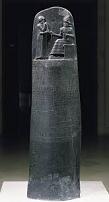
About 1750 B.C.E. the 282 Laws (Code) of Hammurabi are promulgated ( incl. an eye for an eye and a tooth for a tooth and lopping off the hand of a son who strikes his father, regulating social and contractual relationships incl. slaves and sex), and carved onto a large index finger-shaped basalt stele, which is not rediscovered until 1901 C.E. Too bad, in the meantime the Bible appeared, claiming to be a unique revelation from God, even though it clearly plagiarized from Hammurabi's Code, adding to the growing movement to junk it for the alternate Creation story of the Darwinian Evolutionists and Cosmologists. The fact that the Quran blindly accepts the Bible Creation Story and even adds its own details throws it in a bad light with it, helping many Muslims to modernize and civiliza Islam and/or apostasize completely, although never enough to stop the rise of fundamentalist jihadist orgs. since the high birthrate generates legions of backward illiterates who accept the Quran at face value just by having selected passages read to them in a holy tone, after which the Internet allows the jihadists to spread agitprop worldwide to all who feel a religious calling to kill to save the sinking ship.
In 1748 B.C.E. Abraham (b. -1996) is 248 years old; Jacob (later Israel) (b. -1836) is 88 years old; Jacob's 4th son (by his wife Leah) Judah (Heb. "lauded") (root of the royal line of King David) is born in Paddan-aram in Haran (Gen. 29:35; 1 Chron. 2:1).


In 1745 B.C.E. (Tammuz 1) Joseph (d. -1636) (Heb. "remover", "increaser") (Gen. ch. 30) is born to 91-y.-o. Jacob (Israel) (b. -1836) (11th of 12 sons), becoming known for his Coat of Many Colors; he ends up receiving the right of the firstborn (Deut. 21:17) (a double portion of the inheritance), rising to grand vizier, and fathering two tribes, Ephraim and Manasseh (W of the Jordan River to the Mediterranean, incl. the Plain of Sharon), which become the most prominent tribes; in modern times the Latter-Day Saints claim to be of the tribe of Ephraim.
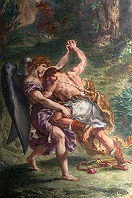
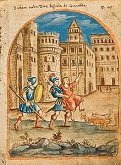
In 1739 B.C.E. 97-y.-o. Jacob (b. -1836) returns to Canaan from Haran with his family (incl. 9-y.-o. Judah), wrestles with an angel all night at the rest stop of Peniel (Penuel) ("face of God") near Succoth E of the Jordan River and S of the torrent valley of Jabbok, during which the angel "touches his thigh", causing a permanent limp, and after the angel wins he confirms Jacob as a prince of men and (surprise?) Jehovah renames him Israel ("Contender with God") (Gen. 31, 32) (some gay action going on and covered up?); the family resides at Succoth, then Shechem, where his daughter (by first wife Leah) Dinah (Heb. "judged, vindicated") is raped by the son of Hamor, causing her brothers Simeon and Levi to avenge her by killing all the males of Shechem, followed by plunder of the city, in which Judah takes part (Gen. 33:17-18, 34:1-2,25-29).
In 1706 B.C.E. Jacob (Israel) leaves Beer-sheba with his whole family and goes to Egypt after Jehovah promies to "make of you a great nation" (Gen. ch. 46).
In 1705 B.C.E. 40-y.-o. Joseph (b. -1745) is made grand vizier (PM) of Egypt (Gen. ch. 41).
About 1700 B.C.E. the Jebusites fortify Jerusalem with stone walls.
About 1700 B.C.E. the Sumerian Simmons Tablet, is written, describing a Biblical-type flood and saying the ark is circular and made of reeds; found by British RAF member Leonard Simmons during WWII
In 1690 B.C.E. Jacob (Israel) (b. -1836) dies in his 147th year (age 146) (Gen. 47:28).
In 1636 B.C.E. Joseph (b. -1745) dies at age 110 (Gen. 50:26) after reconciling with his family and persuading the Hebrews to settle in Goshen in the Nile Delta in NE Egypt, the most lush area, where they begin to outnumber and outprosper the Egyptians, making them jealous (Ex. Ch. 1) - the original Florida and Palm Springs?

About 1600 B.C.E. a revolt against the foreign-invader Hyksos (which incl. the original Jews?) spreads throughout Egypt, which begins its growth into a world power; the Kingdom of Kush (Cush) (Nubia), located at the confluence of the Blue Nile, White Nile, and Atbara Rivers in modern-day Sudan is conquered by the Egyptians, who govern it with a viceroy until 1070 B.C.E., when the New Kingdom disintegrates and it gains its independence, with capital at Napata on the W bank of the Nile River near modern-day Karima, Sudan (250 mi. N of Khartoum). About 1600 B.C.E. the oldest surgical treatise on trauma to survive to modern times, the Edwin Smith Papyrus is written during the Egyptian Second Intermediate Period (by first known physician Imhotep?), describing 48 cases of injuries, fractures, wounds, dislocations, and tumors, with treatment and prognosis, incl. closing wounds with sutures, using honey and moldy bread as antiseptics, stopping bleeding with raw meat, and immobilization for head and spinal cord injuries; magic is left as a last resort; it also contains detailed anatomical observations but shows no understanding of organ functions; the earliest known reference to cancers or ulcers of the breast; discovered in Luxor in 1862 C.E. by Am. antiquities dealer Edwin Smith (1822-1906). The 32 cm Nebra Disk in Germany, 15 mi. from the Goseck Circle contains the oldest known realistic representation of the heavens, with a crescent Moon, full Moon, and a cluster of seven stars representing the Seven Sisters (Pleiades).

In 1591 B.C.E. Job's trial takes place (Book of Job 1:8, 42:16) in the Land of Uz, really Edom (Teman) SE of the Dead Sea; Job is really King Jobab ben Zerah of Edom, who rules from Bozrah ("sheepfold") (modern-day Bouseira, Jordan), homeland of Jacob's twin brother Esau; Job's Edomite friends are Eliphaz (Heb. "El is pure gold") of Teman, a descendant of Teman, son of Esau's eldest son Eliphaz, Bildad, descendant of Shuah, son of Abraham and Keturah, and Zophar (Heb. "rising early/chirping") from Naamah in Canaan.
In 1575 B.C.E. Aaron (d. -1452), son of Amram (Heb. "friend of the most high") and Jochebed (Heb. "Jehovah is glory") of the Jewish tribe of Levi (his great-grandfather) is born in Egypt (Ex. 6:13-30); his elder sister is Miriam, and his younger brother by three years is Moses (Ex. 2:1-4; 7:7); Aaron marries Elisheba, daughter of Amminadab, and has sons Nadab, Abihu, Eleazar, and Ithamar (Ex. 6:23), and lives to age 123 (Num. 33:39).
In 1571 B.C.E. Israel's first Messiah, nat. leader, mediator of the Law covenant, prophet, judge, commander, writer-historian, "Man of the True God" (Ezra 3:2), the original "Go Down Kid", Mo Mo Moses (d. -1451) (Egyptian "is born", "son of", "drawn out" ,"saved out of water") (Ex. 7:7; 1 Ki. 6:1) is born in Goshen, Egypt; son of Amram (of the Jewish tribe of Levi) and Jochebed (sister of Kohah) (Ex. 2:2); grandson of Kohath; great-grandson of Levi; husband of Zipporah; father of Germhom and Eliezer; "By far the meekest of all the men who were upon the surface of the Earth" (Num. 12:3); a "divinely beautiful" infant, he is hidden by his mother for 3 mo. to spare him from a genocidal decree of Pharaoh, and floated in a papyrus ark (basket) down the Nile, where Pharaoh's daughter finds and raises him, with his real mother as nurse, while the tyke is "instructed in all the wisdom of the Egyptians", becoming "powerful in his words and deeds" (Ex. 2:1-10; Acts 7:20-22).
About 1550 B.C.E. the ancient city of Jericho is abandoned. according to the Bible (Joshua Ch. 6), the Battle of Jericho sees the Israelite army of Gen. Joshua blow down the walls with trumpets; it is excavated in 1868, 1907-9, 1930-6, 1952-8, 1997-2000, and 2009-, revealing eyeliner and scarabs from Egypt - no evidence of any trumpets?
In 1542 B.C.E. Jewish gen. Joshua (Jehoshua) (Yehoshua) (Hoshea) (d. -1432) (Heb. "Jehovah is salvation") is born in Egypt, the son of Nun of the tribe of Ephraim.
In 1531 B.C.E. 40-y.-o. Moses (b. -1571) flees to Midian after killing an Egyptian and burying him in the sand (Ex. 2:11-15; Acts 7:23-29), spending 40 years there, saving the seven daughters of Jethro at a well and marrying one of them, Zipporah, who bears him sons Gershom and Eliezer (Ex. 2:16-22; 18:2-4).
In 1521 B.C.E. is the alt. date of the birth of Moses (Eerdman's Dict. of the Bible).
In 1496 B.C.E. thru 1861 C.E. (3,357 years) there are 3,310 years of war and only 227 years of peace (one in 13)?
In 1492 B.C.E. 80-y.-o. Moses (b. -1571) has a religious experience with a thorn bush on Mount Horeb in the Sinai Peninsula (Ex. 3:1-15), and becomes the Messiah, Jehovah's official rep., performing the first human miracles (Ex. 4:1-9), going up against Pharaoh, with his brother Aaron (prophet to Pharaoh, Ex. 7.1) doing the talking and wielding his rod, and bringing on the Ten Plagues of Egypt to convince Pharaoh to let the Jews go (Ex. Chs. 7-12); Aaron goes to become the first high priest of the Israelites.




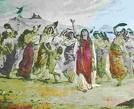
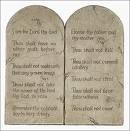
In 1491 B.C.E. is the traditional date of the First Passover, the Biblical Exodus, and the Red Sea Crossing Caper (Ex. Chs. 12-15), led by Moses; on Nisan 14 the first Passover is held (Ex. 12:1-13), then on Nisan 15 Israel departs from Egypt starting at Memphis, being joined by others from Goshen to the N, eventually growing to 2M-3M, and passing over the El Haj trade route to Succoth, reaching Etham N of the Red Sea; then, to solve some sibling rivalry between the top dogs (er, gods) of the two competing religions, the Jews are ordered by Jehovah to "turn back and encamp before Pihahiroth ("mouth of the gorges") between Migdol and the sea in view of Baal-zephon... by the sea" to the S (Heb. "Yam Suph" = "Red Sea" = Gulf of Aqaba?) (Nueba Beach at the end of Nueba Peninsula at the end of 2K-ft.-high Wadi Watir Canyon?) (Ex. 13:20-14:3), which causes Pharaoh and the Egyptians to think they are lost and harden their hearts and pursue them in 600+ chariots (Ex. 14:7); Jehovah then commands Moses to lift up his rod and stretch his hand out over the sea, parting the waters so the Hebrew nation can walk on the dry seabed (Ex. 14:16); after Jehovah makes the wheels of their chariots come off to slow them down (Ex. 14:25), Moses stretches out his hand over the sea again, causing it to close on the Egyptians and kill them all (Ex. 14:26-28); "But the children of Israel walked upon dry land in the midst of the sea; the waters were a wall unto them on their right hand and on their left. Thus the Lord saved Israel that day out of the hand of the Egyptians, and Israel saw the Egyptians dead upon the sea shore" (Ex. 14:29-30); joyful Moses and the men celebrate by singing the hit Hebrew song "The Horse and Its Rider Hath He Thrown in the Sea" (Ex. 15:1), while Aaron's sister Miriam leads the women with tambourines (Ex. 15:20-21); after providing them with food, quail, and manna and instituting a Sabbath Law (Ex. Chs. 15-16), they finally make it to the Sinai wilderness in the 3rd month after the Exodus (Ex. 19:1-2); Moses goes to the top of Mt. Sinai (Horeb) in Midian for 40 days, and returns with two stone (blue sapphire?) tablets "written on by God's finger" containing the Ten Commandments (Words) (Decalogue) (Ex. 31:18, Deut. 4:13), but breaks them after seeing a group of backsliders singing in front of a golden calf made by his brother Aaron from gold jewelry donated by the backsliders, and he and the tribe of Levi kill all 3K of them (sparing Aaron), asking Jehovah to give the Jews another chance and let Moses make his own copy of the Ten Commandments, which he permits after passing by Moses but only allowing him to see his "back (parts) (side)" (Ex. 33:18-23, 34:1-6; Acts 7:38), causing Moses' face to emit rays so intense that the Jews can't bear to look at him (Ex. 34:29-35; 2 Cor. 3:7-13) (ass-kissing and brown-nosing jokes here?); meanwhile Moses begins compiling the five books of the Torah (Hebrew Bible) (Pentateuch), incl. Genesis (Bereshit) ("In the beginning"), containing the immortal soundbyte: "Let there be light" (Lat. "fiat lux") (Gr. "genetheto phos") (Gen. 1:3), Exodus (Shemot) ("The names"), Leviticus (Vayikra) ("And He called"), and Deuteronomy (Devarim) ("Words/things"), containing the immortal soundbyte (Shema) (Deut. 6:4): "Here, O Israel, the Lord our God, the Lord is One", to which the people reply: "All that Jehovah has spoken we are willing to do and be obedient" (Ex. 24:3-7, Heb. 9:19), and sprinkles the Book of the Covenant with blood and reads it to the people on the plains of Moab, founding the Jewish Religion (Judaism), with Moses' Ten Commandments giving Jews a way to beat the curse of Adam and gain eternal life if one never disobeys them, which it turns out all do, esp. when all 613 Commandments (Mitzvot) are taken into consideration, making it necessary for them to be perfected by Christianity - from now on, people can't break God's law, only break themselves on it? The Red Sea Crossing happened no later than -1400 because the Egyptian Eighteenth Dynasty is the only one that used both 4-spoke and 6-spoke chariot wheels, corresponding to coral formations on the floor of the Gulf of Aqaba at both ends of an undersea ridge that makes the gulf passable by foot if the water were removed?; computer simulations by Nat. Center for Atmospheric Research in Boulder, Colo. in 2010 show how a land bridge could be created by a strong E wind at the junction of an ancient river and a submerged coastal lagoon along the Mediterranean Sea.
In 1490 B.C.E. the Jewish Tabernacle (the first DOS Box in Windows?) is built, and the Aaronic priesthood is consecrated (Ex. 40:7, Lev. Ch. 8); Moses sends out an advance party of 12 spies for a 40-day preview of the borders of the Promised Land; upon returning, only 40-y.-o. Caleb (b. -1530) (Heb. "dog") and Joshua (Jehoshua) (b. -1542) (Heb. "Jehovah is salvation") (son of Nun) recommend settling there, the others freaking at the walled cities and scary people and cautioning against it (Num. chs. 13-14), causing the spooked Israelites to balk at proceeding there immediately, pissing-off Jehovah, who kills the 10 bad spies and ordains that none of the Israelites over age 20 (except the Levites, who do no military duty) will live to enter it except Caleb and Joshua.
In 1467 B.C.E. Gen. Joshua leads the confederation of Hebrew tribes known as the Israelites to decisively conquer the Canaanites ("Canaan" = land of purple) as described in the Book of Joshua (Jehoshua); the Promised Land is divided among the 12 tribes of Israel, with the 13th tribe of Levites getting no land, but in return getting to eat the food used in sacrifices? (Joshua 1-14); the Biblical Age of Jewish Judges begins; Joshua allegedly steals, er, conquers the 18th cent. B.C.E. city of Hebron, after which seven years later the city of Zoan in the E Nile Delta is founded (Num. 13:23); it really happened really much later (1126 B.C.E.?); too bad, the Jews fail to completely wipe out the Canaanites' idol worship from the Promised Land like Jehovah commanded, pissing him off and causing him to utter the soundbyte: "I led you up from Egypt and brought you to the land of which I swore to your fathers; and I said, 'I will never break My covenant with you. And you shall make no covenant with the inhabitants of this land; you shall tear down their altars.' But you have not obeyed My voice. Why have you done this? Therefore I also said, 'I will not drive them out before you; but they shall be thorns in your side, and their gods shall be a snare to you'" (Judges 2:1-3); it really never happened, and was made-up 600 years later for purposes of nat. propaganda as a coverup of the truth that the Jews never lived in Egypt and started out in Canaan themselves?
On Apr. 16, 1457 B.C.E. Thutmoses III (the Napoleon of Egypt, who never loses a battle) defeats the rebellious Caananites, led by the king of Kadesh at the Battle of Megiddo, the crossroads of the Middle East.
In 1452 B.C.E. Moses' elder brother and Jewish high priest Aaron (b. -1575) dies at age 123; Moses still has full vigor and alertness (Deut. 34:7).
In 1451 B.C.E. Moses (b. -1571) dies on Mt. Nebo in Moab at age 120 after writing the Books of Moses incl. the Book of Genesis (Gr. "origin"), Book of Exodus, Book of Leviticus (Gr. "relating to the Levites"), Book of Numbers, Book of Deuteronomy, and Book of Job (Deut. 34: 5,7); Israel (Isis + Ra + El?) enters the Promised Land of Canaan under new leader Joshua (Jehoshua) (Yehoshua) (Hoshea) (b. -1542), son of Nun of the tribe of Ephraim (Ex. 17:19, Josh. 4:19), and conquers it in six years after making a wilderness census (Gen. ch. 46) and sending two spies from Shittim, who stay at the house of Rahab the City Wall Ho, who flip-flops to their side and hides them from the king of Jericho on her roof, letting them down by a rope through a window (Joshua ch. 2); Balaam ("he who swallows") of Pethor, son of Beor turns traitor and informs King Balak how to get the Israelites to curse themselves by enticing them with hos and unclean food sacrified to idols, and makes a prophecy about ships from Kittim (Cyprus? Italy? Macedonia?) afflicting Assyria, but eventually perishing (Num. 24:24).
In 1432 B.C.E. Joshua (b. -1542) dies at age 110 (Josh. 24:29); the Israelites settle down for the next three cents. undisturbed.
In 1410 B.C.E. after the Israelites slip back into pagan worship, Jehovah sends the Syrians under Cushan-Rishathaim (Chousarsathaim) ("man of the twofold crime from Cush") to oppress Israel for eight years, until he sends Caleb's younger brother Othniel (d. -1362) (Heb. "Lion of God") to save them, becoming the first Jewish judge (Judges 3:8-10), keeping the peace for 40 years; the Age of the Biblical Patriarchs ends, and the Biblical Age of Jewish Judges begins - no Judge Judy?
In 1402 B.C.E. Judge Othniel of Israel is victorious over Syria; the land "had no disturbance" for the next 40 years.
In 1391 B.C.E. is a possible date for the birth of Moses (d. -1271).
In 1362 B.C.E. after Israeli judge #1 Othniel (Heb. "Lion of God") dies, the Israelites fall back into idolatry, and king Eglon of Moab, along with the Ammonites and Amalekites capture Jericho for 18 years; he goes on to keep the peace for 40 years.
In 1347 B.C.E. King Tut receives the desperate Amarna Letters from Canaan, begging for assistance against the pesky Apiru (Hapiru) (Habiru) ("stateless", "dusty, dirty") Asiatics threatening to take over the land; the origin of the word "Hebrew"?
In 1344 B.C.E. Israeli judge #2 Ehud ben-Gera (son of Gera, of the tribe of Benjamin) is victorious over king Eglon, killing with a 2-edged cubit-long dagger, then killing 10K Moabites, after which Benjamin enjoys rest for 80 years (Judges ch. 3); meanwhile the Philistines oppress SW Israel (Judges 5:6).
In 1324 B.C.E. Canaanite king Jabin of Hazor begins oppressing Israel for the next 20 years (Judges 5:6-11).
In 1304 B.C.E. judge #3 Shamgar saves Israel from the Philistines, and judge #4 Deborah (Heb. "bee") (only female judge) and judge #5 Gen. Barak of Israel are victorious over the Canaanite armies of Sisera; Israel has no further disturbances for 40 years (Judges chs. 4-5).


In 1294 B.C.E. Rameses I dies, and his son Seti I (Menmaatre) (d. -1290) becomes king #2 of the Egyptian 19th Dynasty, conducting two campaigns in Syria to stop the advance of the Hittites and reestablish the empire of Thutmose III in Palestine and Syria; he builds the Temple of Osiris in Abydos to restore worship of Egypt's traditional gods, with a depiction of Isis' constellation Orion; he also decorates the walls of the Great Hypostyle Hall in Karnak, which is completed by his son Rameses II.

In 1290 B.C.E. Seti I dies, and his long-lived son Rameses (Ramesses) (Ramses) II (the Great) (-1320 to -1224) becomes king #3 of the Egyptian 19th Dynasty; he marries glam babe Nefertari, and builds her the most beautiful queen's tomb in Egypt, the Small Temple of Nefertari at Aswan, along with the Great Temple of Nefertari, containing four statues of himself; with her and his other wives Asetnofret et al. he fathers over 100 children; he puts his face on the sphinx in the sanctuary of Ptah at Memphis; he builds up his N capital of Per-rameses in Avaris, the former Hyksos capital.
In 1257 B.C.E. Israeli judge #6 Gideon (d. -1217) (Heb. "slasher", "warrior") of the tribe of Manasseh and the town of Ophrah in Israel W of the Jordan River tears down his family altar of Baal (Judges ch. 6), has miraculous experiences such as keeping his fleece dry in a wet room, and, after sending 22K of 32K in his army home to show it's really Jehovah's army, then selecting the 300 of them that lap water like dogs (Judges ch. 7), through a ruse he routs the Midianites, after which Israel has no further disburbances during the remaining 40 years of his life, and he fathers 70 sons by many wives while refusing to be made king, although he does mess up by accepting the gold bling bling captured from the Midianites, with which he makes an ephod to Jehovah, which causes people to have "immoral intercourse" (Judges 8:22-27).
In 1250 B.C.E. the Bronze Age Collapse begins (ends -1100), caused by severe drought and cold in the Fertile Crescent, driving peoples S, incl. the Sea People (from the Aegean?), who bring the opium poppy, cumin, and the sycamore tree.
-1233 - Done Momming? I'll Show Ya? The Egyptian Eggplant Trick Year?
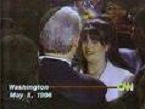
In 1233 B.C.E. at the climax of the year's largest religious festival in Thebes, 70-y.-o. Pharaoh (since -1279) Rameses (Ramesses) (Ramses) II (the Great) (-1303 to -1213) stands on the pyramid and lifts his short white robe to reveal to 300K adoring Egyptians an erect thebesing penis, causing them to cheer after seeing that their pharaoh's staff is mighty and that Egypt will prosper; he dies after fathering 100+ (1K+?) children, causing everybody in Egypt to end up looking like him?; according to Norman Mailer, nothing like this happens again until the days of U.S. Pres. Bill Clinton - a lost invention of Egyptian Viagra, or the eggplant trick of John Barth's "Sot Weed Factor"?
In 1217 B.C.E. Judge Gideon dies, and his son (by a slave concubine from Shechem) Abimelech (Abimelek) (Avimelech) (Heb. "Father of a king") appoints himself Israeli judge #7 and kills all of Gideon's 70 sons except Jotham, who hides; Abimelech rules Israel for three years (Judges 8:28-9:5).
In 1214 B.C.E. Tola (Heb. "worm") of the tribe of Issachar becomes Israeli judge #8, judging Israel for the next 23 years.


In 1213 B.C.E. nicotine-loving Rameses II the Great at age 96, and in late July his 14th (13th?) old fart son (by 2nd wife Isetnofret) Merneptah (Merenptah) (d. -1203) becomes king #4 of the Egyptian 19th Dynasty (until May 2, 1203), marrying his sister Isetnofret (Isisnofret) (Isitnofret) II as well as Takhat, going on to battle the Sea People, Libyans, and Israelites, moving the capital ffrom Pi-Ramesses to Memphis, where he constructs his royal palace next to the Temple of Ptah; ordering the Merneptah Stele (Stela) erected (in -1208?), the last lines of which read: "Canaan is plundered with every hardship. Ashkelon is taken, Gezer captured, Yanoam reduced to nothing. The people of Israel (Isrir) are laid waste, their seed is no more"; the earliest known non-Biblical reference to Israel, and the only known mention of Israel in Egyptian monuments; Rameses II's mummy is interred at Biban al-Muluk, then put in a secret shaft at Deir-el-Bahri ("the northern monastery"), where it is found in 1881 C.E.
About 1200 B.C.E. the Tablet of the Curse, found near Mount Ebal is the oldest known Hebrew text mentioning the name of God.
In 1191 B.C.E. the Semitic Kingdom of Ammon (descended from Ben-Ammi, son of Lot and his younger daughter) begins oppressing Israel for the next 18 years; Jair of the tribe of Gilead becomes Israeli judge #9, judging Israel for the next 22 years.
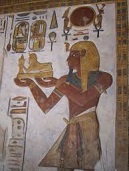
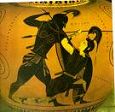


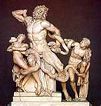

On June 11, 1184 B.C.E. the impregnable walled city of Troy (Ilium) in Asia Minor near the Hellespont (Dardanelles) is destroyed by fire in the last year of the 10-year Trojan War after the first special ops commando raid in history, made possible by the original 1-trick pony Trojan Horse (the original Kobayashi Maru Maneuver?), which Trojan priest Laocoon (Laocoön) tries in vain to expose by tapping with a spear, causing the goddess Athena to send sea serpents to strangle him and his sons Agesander, Athenodoros, and Polyclitus, which the Trojans interpret as proof that the horse is sacred; the doings in the 10th year are later celebrated by Homer's Iliad; the U.S. 10th Special Forces Group (Green Berets) later features a silver Trojan Horse on their badge; a band of survivors led by Aeneas (son of Aphrodite or Venus and Anchises, a cousin of King Priam) escape and search for a new home, ending up in Rome (Latium), where King Latinus (son of Inachus, son of Dardanus, son of Saturn) allows them to stay, and reneges on a promise to King Turnus of the Rutuli, marrying his daughter Lavinia to Aeneas instead, causing Turnus to turn-turn-turn declare war on Aeneas, which he loses, getting killed, after which Aeneas' Troy-born son (via 1st wife Creusa, who dies before reaching Latium) Ascanius founds Alba Longa SE of Rome on Lake Albanus in the Alban Hills (ends 7th cent. B.C.E.), and becomes its first king, establishing the line that leads to Romulus and Remus; Homer's Odyssey contains one of the earliest historical references to Crete, claiming that it's populated by Achaeans, Cydonians, Pelasgians, Dorians, and Eteocretans (pre-Hellenic natives), and has 90 independent cities, with #1 being Knossos. Setakht dies, and his son Rameses (Ramses) III (Rhampsinitus) (d. -1153) becomes king #2 of the Egyptian 20th Dynasty, and the last great pharaoh of the New Kingdom; the rest of the Rameses line are whimps, often elderly, and with short, er, reigns?; references to Punt drop out after his reign, indicating the introduction of camel caravans in Arabia that end the maritime trade with Punt.
In 1173 B.C.E. Israeli judge #10 Jephthah (Jephtha) of Gilead (tribe of Manasseh or Gad) is victorious over Ammon 300 years from the start of the Israelite conquest of Canaan (Judges 11:26-33); too bad, after vowing to make a holocaust (burn offering) of the next person he meets, he burns his own virgin daughter (Judges 11:35-40).
In 1170 B.C.E. Israeli judge #15 (last) Samuel (Heb. "Name of God") is born in Shiloh (Heb. "tranquil, secure") (20 mi. N of Jerusalem) (first resting place of the Tabernacle) of father Elkanah and mother Hannah; of the tribe of Ephraim (1 Sam. 1:20).
In 1150 B.C.E. the Canaanite stronhold of Dan is conquered by the Hebrew tribe of Dan.
About 1150 B.C.E. the Greek Dark Ages (Geometric or Homeric Age) begin (end -800 to -750) as the Hellenic Dorians invade and settle mainland Greece and Sparta, and begin calling it Hellas (Gr. "Land of the Hellenes"); the Aeolians (originally from Thessaly, one of the four major Greek Tribes along with the Dorians, Ionians, and Achaeans, claiming descent from King Aeolus of Thessaly, son of Helen, ancestor of the Hellenes, and father of Sisyphus) settle on the W coast of Asia Minor between the Dardanelles and the Hermus River, and on the island of Lesbos; by modern times the Aeolian dialect is considered the oldest form of Hellenic speech; the Thessalians (first and best Greek horsemen) claim that Poseidon made their fertile plain habitable by creating an outlet for the Peneius River for the first monarchs Deucalion (Deukalion) and his wife Pyrrha (daughter of Epimetheus and Pandora); Greek historian Diodorus of Sicily (Diodorus Siculus) (-90 to -21), later claims that the first Thessalian colonists came from Egypt, which connects with their myth that Poseidon created the horse; about this time Mycenaean civilization ends, and Greek history grows dark until the first Olympics in -776, causing David Michael Rohl (1950-) et al. to propose shifting all dates forward by 200-350 years - meet the new stars of High School Musical III?
In 1128 B.C.E. Abdon of Ephraim, son of Hillel the Pirathonite becomes judge #12 of Israel, judging for the next eight years (Judges 12:15).
In 1125 B.C.E. Judge #11 Samson (d. -1105) (Heb. "Sun") of the tribe of Dan judges Israel for the next 20 years until Delilah (Heb. "seductive") cuts his rays, er, hair.
In 1115 B.C.E. the Ark of the Covenant is captured by the Philistines at Shiloh (1 Sam. 3:3, 4:3-12, 6:1, Josh. 18:1), recaptured, and moved to Beth Shemesh, then to Kiriath-Jearim for 70 years (1 Sam. 6:11-14, 7:1-2); Eli's high priesthood ends (1 Sam. 4:18), but Samuel continues as priest-prophet-judge (1 Sam. 6-7); Saul's eldest son Jonathan is born (1 Sam. 13:1-2, 1 Chron. 8:33).
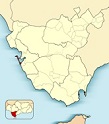
In 1104 B.C.E. the island city of Cadiz (Cádiz) in SW Spain is founded as Gadir (Agadir) ("wall", "compound") by the Phoenicians, becoming the oldest W Euro city to survive to modern times, trading with the city-state of Tartessos near the mouth of the Guadalquivir River until it is flooded out; a temple to the Phoenician god Melqart is built on the S end, later conflated by the Greeks and Romans with Hercules as Hercules Gaditanus and the Tyrian Hercules, becoming known for its oracle and wealth; later the Greeks claim that the city was founded by Hercules after his Tenth Labor, the slaying of 3-headed Geryon; the Herculeum (Temple of Melqart) is still standing in the 1st cent. C.E., giving rise to the myth of the Pillars of Hercules?; same as the Biblical city of Tarshish?
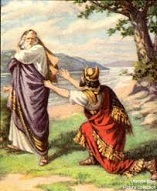
In 1095 B.C.E. after being anointed by Judge Samuel, Saul (d. -1055) (Heb. "asked of God"), son of Kish becomes the first king of a united Israel 356 years from the start of the Israelite conquest of Canaan ("land of purple"); he rules 40 years, nearly annihilating the warlike nomadic Amelekite tribe of SW Palestine (1 Sam. 10:24, 2 Sam. 5:4, 1 Ki. 6:1, Deut. 2:7, Acts 13:21).
In 1085 B.C.E. future Israeli king David (d. -1015) (Heb. "beloved") is born in Bethlehem (1 Sam. 16:1, 2 Sam. 5:4), 14 generations after Abraham; the Babylonian Captivity is 14 generations ahead.
In 1075 B.C.E. after Saul screws up in Jehovah's eyes, Judge Samuel anoints David as king designate of Israel (1 Sam. 16:13), pissing-off Saul, who seeks to have him killed, causing David to become a fugitive; somewhere along the way David meets up with Abigail (Heb. "fountain of joy"), wife of wealthy Carmel chief Nabal, who treats David shabby, causing her to rush out to pacify him with food and supplies as he is on his way to kill Nabal; after Nabal dies, David marries her (1 Sam. ch. 25).

In 1055 B.C.E. Israeli King Saul dies after ruling 40 years (1 Sam. 31:7); Bethlehem-born former shepherd David (Elhanan) (-1085 to -1015) is anointed as king #2 of Judah at Hebron (until -1015) (-1010 to -970?) (2 Sam. 2:4).
In 1050 B.C.E. the Philistines, known for their iron weapons decisively defeat the Israelites, causing the latter to unite.
In 1048 David is anointed king over all Israel (2 Sam. 5:3-5).
In 1047 B.C.E. David takes Jerusalem by sending his soldiers through the King David Water Shaft leading into the city from the Gihon Spring, making it his capital (2 Sam. 5:6,7) and reigning until 970 B.C.E., gaining control of the site of the future temple from the Jebusite Araunah; the Ark of the Covenant is brought into Jerusalem (2 Sam. 6:2-15, 1 Chron. 13:1-11, 15:13, Num. 4:15).
In 1035 B.C.E.Israeli king #2 Solomon (d. -975) (-990 to -930?) is born in Jerusalem, the son of David and Bathsheba (wife of Uriah the Hittite); even though he's not his eldest son, David promises Bathsheba that he will be his successor - the original Bill Clinton and Monica Lewinsky affair in the White House?
In 1030 B.C.E. the Hebrew tribes first settle in the land of Israel? - God I'd like to hear that story?
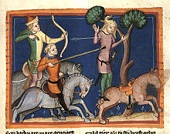
In 1015 B.C.E. after his handsome favorite 3rd son (by Maachah) Absalom (Heb. "father of peace") kills his half-brother Amnon to avenge the rape of his sister Tamar (Heb. "palm tree") (2 Sam. 13:1-33) (not the daughter-in-law of Jacob's son Judah, who marries Er, Onan, and Judah, tricking the latter into hooking up with her, producing twins Perez and Zerah, see Gen. 38:6-30), is pardoned by David, then "stole the hearts of the men of Israel" and rebels, and is kicking butt until he gets his long flowing hair caught in the branches of an oak tree, hanging there helplessly until David's man Joab finish him off, causing David to utter the immortal soundbyte: "O Absalom, Absalom, my son Absalom" (2 Sam. chaps. 3, 13-19, 18:33), kinnor-playing king David (b. -1085) dies after giving a memorable address to the people (1 Chron. ch. 29), with the soundbytes "Thine, O Lord, is the greatness, and the power, and the glory, and the victory, and the majesty; for all that is in the heavens and in the Earth is thine; thine is the kingdom, O Lord, and thou art exalted as head above all" (1 Chron. 29:22-23) and "For we are strangers before thee, and sojourners, as all our fathers were; our days on the Earth are like a shadow, and there is none abiding" (1 Chron. 29:15); too bad, there now comes a 45-year gap between Bishop Ussher's chronology and everybody else's, so David's son Solomon has to go through the 1000 B.C.E. Glass Darkly and come out the other side to become king?
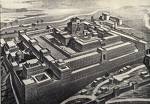

On May 9, 1012 B.C.E. a solar eclipse is observed in the Egyptian city of Ugarit during the reign of Amenhotep IV, shifting all of Egyptian chronology forward of 300 years, according to the New Chronology of English Egyptologist David Michael Rohl (1950-). In 1012 B.C.E. Solomon begins the construction of the Temple of Solomon, AKA the Temple of Jerusalem (1 Ki. 6:1), with the help of king Hiram I of Tyre, who furnishes Solomon's ships with chains of brass; the head workman is allegedly Hiram Abiff (son of a widow of the tribe of Naphtali), in charge of 3.3K grand overseers and 150K workmen, who is murdered by three ruffians who try to get the secret Master Mason password out of him, as later claimed by the Freemasons, who stage an allegorical play about him in their Third Degree (Master Mason) rites - the prototype of McDonald's cow meat restaurants of the 20th cent. C.E.?
In 1005 B.C.E. Samson dies in a blaze of glory, taking mucho Philistines with him; he is succeeded by Eli (Heb. "Jehovah is the Most High") as judge #14 of Israel, becoming the trainer of young Judge Samuel.
About 1000 B.C.E. the soft limestone tablet Gezer Calendar is erected 30 mi. NW of Jerusalem on the site of the Biblical city of Gezer, outlining their lunar agricultural year; a school boy's exercise?; discovered in 1908 C.E. About 1000 B.C.E. a pottery shard in Khirbet Qeiyafa (the Qeiyafa Ostracon) is left, excavated in 2008 near the Elah Valley in Israel 18 mi. W of Jerusalem on the border of Judah and Philistia, containing the earliest known example of Hebrew writing, making the writing of the Bible possible from this cent. on. About 1000 B.C.E. the Anthedon Port (AKA Tida Port) is the earliest known seaport in Gaza; discovered in 1997, and bulldozed by Hamas in 2013.

In 970 B.C.E. (972?) (967?) David is succeeded as king of Israel by his son (by Bathsheba the Bathing Babe) Solomon (-1035 to -975) (-990 to -930) (Sol-Om-On = Sun-Moon-Venus?) (Heb. "shalom" = peace), whom David anointed before he died in order to stop his eldest son (by Haggith) Adonijah (Heb. "Jehovah is my lord") from inheriting the throne; he rules for you guessed it 40 years, and bases his Red Sea navy at Ezion-Geber (Heb. "giant's backbone") on the Gulf of Aqaba (a part of Edom conquered by his daddy which the Israelites stopped at during their 40-year wanderings); he becomes known for his wisdom (3K proverbs, 1,005 songs in his bestselling writings Song of Songs (Song of Solomon) (Canticles), Book of Proverbs, and Ecclesiastes), plus his great riches, incl. 12K horses with horsemen, 1.4K chariots, 700 wives, 300 concubines, and fabled gold mines - the richest and smartest man who ever lived was a Jew?
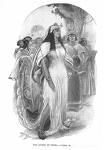

I can't tell you how happy I am you're here? About 967 B.C.E. Jewish King Solomon builds the Temple of Solomon (First Temple of Jehovah) on Mount Moriah ("foundation") AKA Mount Zion in Jerusalem; about this time Solomon, who is known for his active gonads and love of women, and has 700 wives and 300 concubines (1 Ki. 11:3) (but there's always room for more) is visited by the Queen of Sheba (Sheba, Queen of the South) (S Arabia?) (Yemen?) (Ethiopia?) (1 Ki. ch. 10) for 6 mo., who at first makes him promise not to touch her, but as she's a black sugarpants babe and he's got a wicked sweet tooth he tricks her into touching one of his vases, then uses the power (kings only) pickup line, "Now that you have touched something of mine, I will touch something of yours", and jumps her bones (and marries her?), then she returns to her country (Axum?) (Sacred Hill of Yeha?) pregnant with his son Ebna la-Hakim ("son of the wise"), whom she renames Menelik I ("son of the wise"), who goes on to found the Ethiopian Dynasty, as recorded in the (authentic or total moose hockey?) Ethiopian Book of Kings (Kebra Nagast) (Kebia August); he later returns to visit his daddy Solomon (the original Guess Who's Coming to Dinner?), who shows pleasure at his hybrid vigor and gives him the Ark of the Covenant (Tabot) (only a replica?), which he takes back to Ethiopia, where it survives to modern times in a sealed temple where only priests can look at it because it protects the nation; Menelik is buried on Mt. Kilimanjaro; the Ark is secretly transported back to Israel in 1991 C.E.? During Solomon's reign the first Jews arrive in India in Solomon's merchant fleet, and some settle in Cochin in S India, later being joined by Jews from Spain et al.; meanwhile a group of 14 shipwrecked Jews settle on the Konkan coast of W Maharashtra, calling themselves Bene Israel.
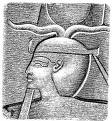
In 943 B.C.E. Psusennes II dies, and Shoshenq (Sheshonq) (Sheshonk) I (d. -922) becomes king #1 of the Libyan (Berber Meshwesh tribe) Twenty-Second (XXII) (22nd) (Libyan Bubastite) Dynasty in Egypt, which lasts more than two cents. (until -715); he rules from the city of Bubastis (Per-Bast) ("House of Bastet") (Tell-Basta) in the Nile Delta, and goes on to wage a successful campaign against the kingdoms of Canaan, Philistia, Syria, Judah, Israel, and the Negev, conquering Megiddo, Byblos et al. (not Jerusalem?); the Shishak of the Bible? (1 Kings 14:25, 2 Chron. 12:1-12)
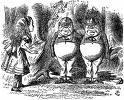
The original Tweedledum and Tweedledee? In 930 B.C.E. Solomon (b. -990) dies after pissing-off Jehovah by letting his pagan wives lure him into their dirty business (but out of respect to his daddy David he waits until Solomon dies to lower the boom), and he is succeeded by his 41-y.-o. son (by an Ammonite mother) Rehoboam (Roboam) (-970 to -914) (Heb. "who enlarges the people"), who is crowned in Shechem, and reigns for 17 years as the last king of the united monarchy, and the first ruler of the S 2-tribe kingdom of Judah-Benjamin (plus Levites and individual switchovers); shortly after his coronation the 10 tribes of N Israel revolt from his heavy-handed tax machine and make Jeroboam (Heb. "he increases the people", "he pleads the people's cause") their king after recalling him from Egypt, and the kingdom splits into the rival kingdoms of 10-tribe Israel (N) (capital Shechem then Tirzah) and 2-tribe Judah (S) (capital Jerusalem) (1 Kings 11-12, 2 Chron. 10:1); end of the Hebrew Camelot Days; Rehoboam then supposedly listens to his Ammonite mother Naamah and abandons the true faith of Jehovah for sex worship, pissing Big J off again, resulting in an Egyptian invasion in his 5th year (1 Ki. 14:22-24 2 Chron. 12-1).

In 926 B.C.E. Solomon's Temple of Jehovah in Jerusalem is plundered by the Egyptians in the 5th year of Judean king Rehoboam by his protector Pharaoh Shishak (Sheshonq I?), who allegedly carries the Ark of the Covenant to Tanis, as mentioned in the first Steven Spielberg Indiana Jones flick Raiders of the Lost Ark (1981); he takes all the treasures of the Jewish Temple and the king's house, incl. the gold shields of Solomon, which Rehoboam replaces with copper ones (1 Ki. 14:25-28, 2 Chron. 12:1-12).
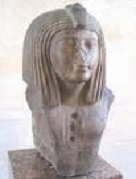
In 922 B.C.E.Tanis is buried in a month-long sandstorm; Shishak I dies, buried along with the Ark of the Covenant :), and his son (by Karomat A) Osorkon I (d. -887) becomes king #2 of the Egyptian 22nd Dynasty, going on to build many teamples.
In 913 B.C.E. Rehoboam (b. -970) dies at age 58, and his son (one of 28) Abijah (Abijam) (d. -911) (Heb. "my dad is Jehovah") becomes king #2 of Judah (1 Ki. 14:31, 15:1-8); he is the son of Rehoboam's favorite concubine (of 60 concubines and 18 wives) Maacah (Micaiah) (2 Chron. 13), the granddaughter of David's favorite (3rd) son Absalom, and a descendant of King David on both his father's and mother's side, and hence "leaned upon Jehovah" (2 Chron. 13:13-20), proving it by marrying 14 wives and fathering 22 sons and 16 daughters;
In 912 B.C.E. Abijah's army of 400K defeats Jeroboam's army of 800K, killing 500K of them and breaking Jeroboam's military power; the sacred golden calf city of Bethel is captured (2 Chron. chs. 12-13).
In 911 B.C.E. Abijah dies, leaving 38 children by 14 wives, and his son Asa (d. -870) becomes king #3 of Judah (2 Chron. 13:21, 14:1, 1 Ki. 15:9-10).
In 910 B.C.E. Jeroboam I dies, and his son Nadab (d. -901) (Heb. "generous, noble") becomes king #2 of the northern 10-tribe kingdom of Israel, continuing his father's golden calf worship - preferring McDonald's to Mister Steak?
In 909 B.C.E. in year 3 of King Asa of Judah (1 Kings 15:28) while sieging the former Levite city of Gibbethon (in Philistine hands), Nadab is assassinated by Baasha (d. -886) (Heb. "Baal hears"), the son of Ahijah of the tribe of Issachar, who then exterminates Jeroboam's house and takes the throne of Israel for himself, becoming king #3 of the 10-tribe kingdom of Israel, founding Israel's second dynasty and ruling for 24 years (1 Ki. 14:10, 20, 15:25-31).
In 886 B.C.E. Baasha dies and is buried in his capital city Tirzah, and his son Elah (d. -885) (Heb. "big tree") becomes the king #4 of the 10-tribe kingdom of Israel, ruling in Tirzah for parts of two years (1 Ki. 16:8).
In 885 B.C.E. in the 27th year of Asa of Judah (1 Ki. 16:15-18), Judean king Elah's chief of half the chariots Zimri (Zambri) rebels, waits until the army is on maneuvers at Gibbethon and Elah is drunk, then kills him and the whole house of Baasha, allegedly fulfilling a prophecy (1 Ki. 16:1-14); he then proclaims himself king #5 of the 10-tribe kingdom of Israel, but rules for only seven days when the army proclaims army chief Omri king and returns to siege him at Tirzah, causing him to burn the king's house down over himself (1 Ki. 16:3-20) and die; later el taunts Jehu from a window with the killer soundbyte, "Did it go all right with Zimri the killer of his lord?" (1 Ki. 9:30-31); Omri (d. -873), of who knows what tribe becomes king #6 of the northern 10-tribe kingdom of godforsaken Israel, ruling for 12 years and founding its third dynasty, which is so powerful that the Assyrians start calling Israel "the land/house of Omri", even after his house falls; Tibni, the son of Ginath presents himself as the rightful (7th) king, dividing the people and causing a 4-year civil war.
In 880 B.C.E. Tibni dies, leaving Omri the sole (and now 8th) king of the 10-tribe kingdom of Israel for eight years (1 Ki. 16:21-23, 29), where he continues doing sex, drugs and rock & roll ("kept doing what was bad in the eyes of Jehovah and came to do worse than all who were prior to him") (1 Ki. 16:25-26), although that doesn't stop him from "mightiness" (1 Ki. 16:27); about 840 B.C.E. the Moabite Stone says (lines 4-8) that he brings Moab into subjection, which Ahab continues after him (2 Ki. 3:4); he moves the capital from Tirzah to the more defensible new city of Samaria, which he purchases along with the whole mountain from its owner Shemer (1 Ki. 16:23-24); he surrenders some cities to the king of Syria (1 Ki. 20:34), and is the first Israelite king to pray tribute to Assyria; it contains a reference to the House of David?

In 874 B.C.E. Omri dies, and his son Ahab (d. -853) (Heb. "father's brother") becomes king #9 of the 10-tribe kingdom of Israel, ruling in Samaria for 22 years (1 Ki. 16:28-29, 22:40, 51); he marries 15-y.-o. Jezebel (Heb. "Where is Baal?") (1 Ki. 16:31) of Tyre, great-aunt of Carthage founder Dido and daughter of Itto-Baal (Ethbaal) (Ithobalus) (former priest of Ashtoreth AKA Astarte AKA Asherah), and king of Sidon by regicide), who leads him down from family-style golden arches calf worship to total sex-drugs-and-rock-n-roll (Tom Cruise and Nicole Kidman style?) Baal worship, supporting 450 prophets of Baal from the royal table and ordering all of Jehovah's prophets slain (100 are saved by Ahab's house mgr. Obadiah by hiding them in a cave) (1 Ki. 18:3-13, 19:10); Ahab rebuilds Jericho to strengthen control over Moab, and fortifies Samaria, building a "house of ivory" (1 Ki. 22:39, Amos 3:15, 6:4); after Syrian king Ben-hadad demands Gilead (on the E bank of the Jordan River) and Ahab refuses, uttering the soundbyte "It is not the man who puts on the armor who should boast... but the one who takes it off", Ben-hadad leads a 32-king coalition on Ahab, but is defeated (1 Ki. chs. 20-21); too bad, Ahab doesn't follow Jehovah's orders and kill Ben-Hadad, but extends him the hand of peace, pissing off Jehovah's prophet Elijah, who begins an epic power struggle with him and his "harlot" wife Jezebel and their prophets of Baal (1 Kings chs. 17-19), beginning with three years of drought.
In 870 B.C.E. Asa dies, and his 35-y.-o. son (by Azubah the daughter of Shilhi) (co-regent since -873) "Jumpin'" Jehoshaphat (Yehoshafat) (Jehosaphat) (Josaphat) (d. -849) (Heb. "Jehovah is judge") becomes king #4 of Judah, ruling for 25 years (1 Kings 22:41-2, 2 Chron. 20:31), proving to be one of the "good" kings, his reigned marked by peace and even tribute from Philistines and Arabs; too bad that he enters into a marriage alliance with idolatrous Israel, marrying his firstborn son Jehoram to king Ahab's wicked daughter Athaliah (1 Ki. 22:44, 2 Chron. 18:1).
In 853 B.C.E. Shalmaneser III enters the plains of Syria and is met by a Syrian coalition army led by Iruhuleni of Hama and Ben-Hadad II of Damascus, supported by 12 kings, incl. those of Phoenicia and Israel (King Asa contributes a chariot force); Assyria claims a V at the Battle of Karkar (Qarqar) on the Orontes River, although it is really indecisive; King Ahab of Israel induces King Jehoshaphat of Judah to join him in the retaking of Ramoth-gilead from the Syrians, and is killed by a Syrian archer; when his body is brought to Samaria for burial, Jehovah's curse (1 Ki. 21:1-23, 2 Ki. 9:26) on him for the murder of his Jezreelite neighbor Naboth comes true, because when "they began to wash off the war chariot by the pool of Samaria... the dogs went licking up his blood" (1 Ki. 22:1-38); Ahab's son Ahaziah (d. -852) (Heb. "Jehovah has taken hold") becomes king #10 of the 10-tribe kingdom of Israel for two years, continuing to practice Baal worship (1 Ki. 22:51-3); Moab quickly revolts (2 Ki. 1:1, 3:4-5), but before he can take charge Ahaziah has a house accident, falling through a grating in his roof chamber, leaving him bedridden (2 Ki. 1:2); his brother Jehoram (d. -841) becomes co-regent; Israel forms a shipbuilding alliance with King Jehoshaphat of Judah at Ezion-Geber on the Gulf of Aqaba, but it fails (2 Chron. 20:35-7, 1 Ki. 22:48-9).
In 852 B.C.E. the ailing Ahaziah has a sorcerer's battle with Jehovah's prophet Elijah (who gives him a death notice from Big J himself) and loses (1 Ki. ch. 2-17), dying sonless, leaving his brother Jehoram (Joram) (d. -841) (Heb. "Jehovah is exalted") (brother-in-law of the other Jehoram in Judah because the latter is married to his sister Athaliah) as the 11th king of the 10-tribe soap opera kingdom of northern Israel; he reigns 12 years (2 Ki. 1:17-18, 3:1, 9:22), reversing his daddy's Baal thang, removing the sacred pillar erected by the red priest Lucille (just kidding, it was the Babalu priest Desi), but still falling short, continuing to do "what was bad in Jehovah's eyes", clinging to Jeroboam's golden calf worship (1 Ki. 12:26-29, 16:33; 2 Ki. 3:2-3); Joel writes his book during his reign?; Elijah is taken up to ? in a windstorm (and years later writes a letter to Judean king Jehoram, 2 Chron. 21:1, 12-15), and his assistant (for the past six years) Elisha succeeds him as Jehovah's prophet in Israel, performing many miracles in his 60-year ministry after asking Jehovah for "two parts in Elijah's spirit" (2 Ki. 2:9) so he can be his firstborn spiritual son, entitled to two parts of his father's inheritance. Meanwhile, in South Soapoperaland, Jehoshaphat's firstborn son Jehoram becomes co-ruler with his father of the kingdom of Judah.
In 850 B.C.E. Mesha, son of Kemoshmelek, king of Moab E of the Dead Sea erects the Moabite Stone, crowing about his successful revolt against the Hebrews and their whimpy god Jehovah (Yahweh), becoming the earliest known reference to this god outside the Bible (see 2 Ki. 3:27 for the Israelite version); rediscovered in 1868 C.E. Syrian king Ben-Hadad erects a monument in the city of Dan proclaiming his big V over the towns of N Israel.
In 849 B.C.E. Jehoshaphat dies, and his 32-y.-o. firstborn son Jehoram (d. -842) (Heb. "Jehovah is High") becomes king #5 of Judah, reigning eight years (2 Ki. 1:17, 8:16, 21:2-20); thus both Judah and Israel are ruled by brothers-in-law named Jehoram; due to his wife Athaliah's bad influence, Jehoram of Judah departs from his dad's righteous ways, murders his six brothers, causes Edom and Libnah to rebel (2 Ki. 8:20-22), and is plagued by Arabs and Philistines who invade and overrun Judah and take his wives and sons captive - a foretaste of the days of Muhammad? Shalmaneser III campaigns against Syria.
In 842 B.C.E. King Ben-Hadad II of Damascus dies after he sends Hazael to inquire of prophet Elisha if he will recover from his sickness, and the latter predicts that he will die and that Hazael will rule in his place; the next day Hazael suffocates the king under a wet "netted cloth" and becomes king of Damascus (2 Ki. 8:15). After receiving a prophetic mandate, Jehu, son of Nimshi and CIC of the army is anointed king in Ramoth-gilead in order to destroy the house of Ahab in retaliation for the acts of wicked Jezebel, and leads a bloody military revolt to seize the throne of Israel; after meeting Jehoram of Israel at Jezreel and telling him that there can be no peace in Israel while the "whoredoms and sorceries" of Jezebel continue, he shoots an arrow through the fleeing king's heart, then kills King Ahaziah of Judah (grandson of Ahab and el), then returns to Jezreel to kill Jezebel herself; she tries to pussy-whip him by dressing up and flashing him from a window, but her own attendants throw her out and she is trampled to death by horses, then eaten by dogs, leaving only the skull, feet, and palms (2 Ki. 9:32-37); Jehu (d. -814) (Heb. "Jehovah is he") becomes king #10 of Israel (2 Ki. chs. 9-10); as a "son of a murderer" (2 Ki. 6:32) Jehoram's body is pitched into the field of Naboth, the man his daddy Ahab had murdered in order to get a vineyard (2 Ki. 9:14-26); Jehu wipes out the dynasty of Omri, and obliterates Baal worship in Israel; his dynasty lasts five generations, so Jehovah must have really liked it? Not to be left out of the TV sweeps, Jehoram of Judah, plagued by Jehovah with a sickness in his intestines for two years, tosses his matzohs when "his intestines came out", and he dies and is buried in Jerusalem, "but not in the burial places of the kings"; next year his son Ahaziah (Jehoahaz) (d. -841) (Heb. "Jehovah has taken hold"), who escaped the invasions becomes king #6 of Judah, reigning only 1-2 years (1 Ki. 22:51-3; 2 Ki. 1:17-18, 3:1-3, 10:12-14; 2 Chron. 21:7, 6-20; 22:1; 1 Chron. 3:10-11), and having a new son Jehoash with his wife Zibiah from Beersheba (2 Ki. 12:1; 1 Chron. 3:11).


In 841 B.C.E. Ahaziah is killed by Jehu (2 Ki. 9:14-28), and his enraged mother Athaliah (d. -835) (Heb. "Jehovah is great, exalted") kills all the others of the royal line except Ahaziah's infant son Jehoash, who is hidden by the high priest Jehoiada and his wife Jehosheba (Jehoash's aunt) in the Temple; Athaliah takes the throne by force, becoming king #7 (only female) of Judah, reigning for six years, taking the opportunity to rob the Temple of its holy things and offer them up to her god Baal, which as you must know by now, makes Jehovah mighty angry. Shalmaneser III campaigns against Syria; he attacks Damascus, crushing the army of Hazael; he receives gold and silver tribute from Judean king Jehu, son of Omri, and erects the Black Obelisk of Shalmaneser III.
In 835 B.C.E. Ahaziah's youngest son Jehoash having been hidden in the Temple until he reaches the ripe old age of 7, high priest Jehoiada (Heb. "Jehovah knows") and his wife Jehosheba gain the help of five chieftains and 500 men, then stage a palace coup (2 Ki. 11:4-12, 21; 2 Chron. 23:1-11), kill Athaliah at the entry of the horse gate, tear down her house of Baal and murder her Baal priest Mattan (2 Ki. 11:13-20, 2 Chron. 23:12-21); they crown Jehoash (Joash) (d. -796) (Heb. "Jehovah is strong, "Jehovah has bestowed") as king #8 of Joltin' Judah; he reigns 40 years, at first being placed under the wing of Jehoiada, marrying two wives, one of which, Jehoaddan, saves the faltering line of David leading to Messiah; but upon the death of Jehoida he goes bad, opts for idolatry and phallic sacred poles, and finally kills the prophet Zechariah, thus sealing his Biblical fate (2 Chron. 24:20-22).
In 830 B.C.E. Damascus king Hazael destroys the Philistine city of Gath, home of Goliath; rediscovered in 2015.
In 796 B.C.E. Jehoash pays tribute to Adad-Nirari III; Jehoash is murdered by two of his servants, is buried in the city of David with his forefathers, and his 25-y.-o. son Amaziah (Amatzyah) (Amasias) (d. -781) (Heb. "Jehovah is mighty") becomes king #9 of Judah for 29 years (until -768) (2 Ki. 12:19-21, 14:1-2; 2 Chron. 24:25-27), starting by executing his father's murderers but sparing their children, then becoming the first king of Judah to hire a mercenary army of 100K Israelite soldiers to help him reconquer Edom (which rebelled during the reign of his great-grandfather Jehoram) until a prophet commands him to send them back, after which Jehovah grants him a decisive V (2 Chron. 25:14-16); too bad, he begins to worship idols taken from the Edomites.
In 793 B.C.E. Jehoash's son Jeroboam II (d. -753) becomes coregent of Israel (until -782).
In 792 B.C.E. King Amaziah of Judah challenges Israeli king Jehu's grandson Jehoash to battle (2 Kings 14:9), and rushes into a disastrous battle at Beth-shemesh (Beit Shemesh) on the border with Dan, getting taken POW while Jerusalem incl. the Temple is looted and hostages carried off to Samaria, bringing on a conspiracy to kill him. In 792 B.C.E. Hebrew prophet Elisha (Heb. "My Jehovah is salvation") dies in the reign of Israeli king Jehoash's grandson Zechariah after a 60-year ministry and 16 miracles (2 Ki. ch. 2-13), incl. making the waters of the Jordan divide (2:14), curing the bad water supply of Jericho (2:19-22), getting bears to attack juvenile delinquents (2:23-4), supplying water to armies (3:16-26), supplying edible oil to a widow (4:1-7), causing a barren Shunammite woman to conceive (4:8-17), raising a child from the dead (4:18-37), making a poisonous stew edible (4:38-41), feeding 100 men with 20 loaves (4:42-4), helping cure Naaman of leprosy (5:1-14) then causing Gehazi to get Naaman's leprosy (5:24-7), making an axe head float (6:5-7), causing a servant to see angelic chariots (6:15-17), striking the Syrian army with blindness (6:18), then restoring their sight (6:19-23), and raising a man from the dead (13:20-1).
In 791 B.C.E. 16-y.-o. Uzziah (Azariah) (Uzziah) (Ozias) (Heb. "Jehovah is my strength") (-807 to -740) becomes co-regent of Judah with his father Amaziah.
In 782 B.C.E. Jehoash dies, and Jeroboam II (d. -753) becomes king #15 of the 10-tribe kingdom of Israel; Assyria, the second world power of the Bible begins to dominate Israel (2 Ki. 15:19); prophet Jonah (Ionas) (Heb. "dove", "peace") from Gath-Heber N of Nazareth flourishes during his reign.
In 781 B.C.E. Jewish minor prophet Amos of Tekoa (10 mi. S. of Jerusalem) is "taken from following the flock" by Jehovah (Amos 7:15) and sent to the northern kingdom of Israel at the time of Jeroboam II of Israel and Uzziah of Judah; two years later a great earthquake occurs in Judah (Zech. 14:5); later (unknown) he is thrown out of Israel by Baal priest Amaziah, and returns to Tekoa, where about -750 he writes the Book of Amos.
In 768 B.C.E. Amaziah is assassinated in his hiding place in Lachish, and buried in the royal sepulcher in Jerusalem, and his 40-y.-o. son Uzziah (Azariah) (Uzziah) (Ozias) (Heb. "Jehovah is my strength") (-807 to -740) becomes king #10 of Judah for 28 more years (until -740) (2 Chron. ch. 26).
On June 15, 763 B.C.E. (Jewish month of Sivan) the Total Eclipse of Bur Sagale (Assyria) occurs while Bur Sagale is gov. of Guzana, becoming the earliest solar eclipse mentioned in historical sources (an Assyrian text) that has been successfully identified; modern historians use this date from the Assyrian Eponym (Limmu) Lists to synchronize the histories of Assyria and Judah and Israel.
In 753 B.C.E. Jeroboam II dies, and his son Zechariah (d. -752) (Heb. "Remembered by Jehovah") becomes king #16 of Israel for 6 mo. (until -752), when his army capt. Shallum (d. -743) (Heb. "retribution") "conspired against Zechariah, and smote him before the people, and slew him, and reigned in his stead" (2 Kings 15:10), ending the dynasty of Jehu after four generations, becoming king #17 of Israel for 1 mo. until pissed-off fellow army capt. Menachem (Menahem) Ben Gadi (d. -738) (Heb. "comforter, consoler") marches from Tirzah 6 mi. E to Samaria, sieges it, and murders Shallum and becomes king #18 of Israel for 10 years (2 Kings 15:14-22), becoming known for drunkenness and debauchery, brutually suppressing a revolt at Tiphsah and destroying the city and killing the pop. after ripping open the wombs of pregnant women, "departing not from the sins of Jeroboam".
In 750 B.C.E. King Azariah (Uzziah) of Judah is struck with leprosy; his son Jotham (Yotam) (d. -735) (Heb. "Jehovah is honest") (son of mother Jerusha) becomes coregent in Judah; the Israelites recapture the city of Dan - was it steely?
In 742 B.C.E. Israeli king Menahem pays tribute to Tiglath-Pileser III.
About 742 B.C.E. Hosea of Israel writes The Book of Hosea, becoming the first of the 12 minor prophets, harping about the apostasy of the people, who turn away from Jehovah to worship the calves of Jeroboam (1 Ki. 12:26-30, Hosea 8:4-6) and Baal.
In 740 B.C.E. leprous king Uzziah (Azariah) dies, and his 25-y.-o. son Jotham (Yotam) (d. -731) (Heb. "Jehovah is honest") (son of Jerusha the daughter of Zadok), who had been administering the affairs of the king's house and judging the people becomes king #11 of Judah (until -735), beginning construction of the Wall of Ophel; in this year prophet Isaiah (Heb. "Yeshayahu" = salvation of Jehovah), son of Amoz has a vision giving him a commission to preach to the people of Judah and Jerusalem, but warning him that the nation will come to ruin, and only a "tenth", a "holy seed" would be left (Is. 6:1-13); in 2019 Israeli archeologist Eliat Mazar discovers a clay bulla at the base of the S wall of the Temple Mount in Jerusalem bearing Isaiah's name, and another clay bulla in 2015 10 ft. away bearing the seal of King Hezekiah.
In 738 B.C.E. Menachem dies, and his son Pekahiah (d. -737) (Heb. "Jehovah has opened his eyes") becomes king #19 of Israel (2nd and last from the house of Gadi), continuing the sins of Jeroboam (idolatrous calf worship) that Jehovah doesn't like for two years; Assyrian king Tiglath-Pileser II invades Israel and forces it to pay tribute.
In 737 B.C.E. Pekahiah is murdered by his general (adjutant) Pekah (d. -732) (Heb. "open-eyed") (son of Remaliah) and 50 men of Gilead, and Pekah becomes the 20th and penultimate king of the 10-tribe kingdom of Israel (2 Ki. 15:25-27), going on to reign for 20 years while continuing the idolatrous calf worship (2 Ki. 15:28); Pekah allies with Aram (Dammascus) king Rezin to attack Assyria, trying to coerce King Ahaz of Judah to join, causing him to appeal to Assyrian king Tiglath-Pileser III - two decades of frightful fashion and big hair?
In 735 B.C.E. Jotham is deposed by a pro-Assyrian faction in favor of his 20-y.-o. (25-y.-o.) son Ahaz (d. -715) (Jehoahaz) (Heb. "Jehovah has grabbed hold") becomes king #12 (co-regent until -732?) of Judah, becoming known for misrule and apostasy (2 Chron. chs. 27, 28).
In 734 B.C.E. after King Ahaz of Judah calls on Assyria for help in its war with Israel and Damascus, Assyrian king Tiglath-Pileser III captures Damascus and executes King Reza before deporting the pop. to Kir and annexing the Aramean Kingdom (founded -1000) (2 Kings 16:9), dividing it into six provinces centered around Damascus; Assyria imposes an embargo on the export of timber from Tyre and Sidon to Philistia and Egypt; Palestine and trans-Jordania are crushed; the prince of Ascalon is killed, and the men of Gaza and the other of the so-called Five Strong Cities of Philistia flee to Egypt "like a bird"; Tiglath-Pileser III conquers The Galilee, and the land of Naphtali on the E side incl. Ijon, Hazor, Kedesh, Gilead, Abel Beth Maacah (Abel Maim), and Janoah, deporting most of the pop. to Assyria, then attacks Israel, annexing all teritory N of Jezreel (half of Israel); the Jews are exiled from Perea (E of the Jordan River); the kings of Edom and Judah pay tribute.
In 732 B.C.E. after pissing him off by attempting to coerce King Ahaz of Judah to take action against Assyria in league with King Rezin of Damascus, Israeli King Pekah is murdered by pro-Assyrian party head Hoshea (Heb. "salvation") (son of Elah), who becomes king #21 (last) of the 10-tribe kingdom of Israel based in Samaria (until -721) after paying Assyrian king Tiglath-Pileser III (Pul) 10 talents of gold and 1K talents of silver as tribute; an 8-year interregnum begins (2 Ki. chs. 14-15, 2 Chron. ch. 26)?; too bad, when Tiglath-Pileser III dies in -727, Hoshea conspires with Egypt to rebel, causing his successor Shalmaneser V to invade; Isaiah writes the Book of Isaiah about this time, dissing King Ahaz for allying with Assyria despite it making his kingdom safe and peaceful.
In 728 B.C.E. Ahaz appoints his son Hezekiah (d. -686) (Heb. "Jehovah strengthens") coregent of Judah, who seeks unification with the kingless northern kingdom of Israel, inviting them to an ecumenical Passover (2 Chron. 30:1).

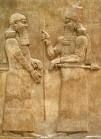
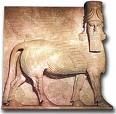
In 722 B.C.E. in the 6th year of Hezekiah of Judah (2 Ki. 18:10), after a 3-year siege Samaria is conquered (2 Ki. ch. 17) by the Assyrians under king (since -727) Shalmaneser V, who is assassinated, allowing his successor Sargon II (Sharru-Kin) (-763 to -705) ("legitimate king", "god made firm the king") to claim credit after the Assyrian army withdraws to secure his succession, Israel revolts again, and he returns to finish them off in -720.
In 720 B.C.E. Assyrian king Sargon II reconquers Samaria after another revolt; the 27,290 members of the Lost Ten Tribes of Israel, incl. King Hoshea are carried away like foam upon the water to Harran; the depopulated land is slowly settled by Aramaic-speaking Assyrians, and the Samaritan Religion is born; Jerusalem is strengthened with a great influx of refugees; after the time of Nehemiah, the Hebrew language dies out, and Aramaic, the language of the Aramean internat. land traders becomes the universal language of the civilized Western world by the time of Darius I the Great; of the original Twelve Tribes, only the depleted 2-tribe (Judah and Benjamin) S kingdom of Judah is left (along with some Levites, the landless priest-class 13th tribe), and Judah only has seven more kings to go before their royal line is kaput (Manasseh, Amon, Josiah, Jehoahaz, Jehoiakim, Jehoiachin, Zedekiah); later speculators trace the lost tribes to the British Isles, North Am., South Am., India (the Manashe Tribe in Manipur and Mizoram in E India), Abyssinia, Afghanistan, China, Japan, Africa, and Uzbekistan and Tajikistan; the proof that the Tribe of Dan migrated W is their naming of the Danube, Dnieper, and Denmark?; in the 18th cent. the Anglo-Israelite Theory, that they are the ancestors of the Anglo-Saxon peoples makes it easier for Jews to immigrate; did they go to Japan, as indicated by similar ceremonies?; some Scots claim that they are the lost tribes, and that the Stone of Scone (pr. SKOON) is really the Beth-El (Jacob's Pillow) in Genesis; the Book of Mormon claims that they migrate to North Am., quoting Bible prophet Isaiah (Heb. "Jehovah is salvation"); "From the isles of the sea, from those parts beyond the sea into which they were carried captive" (Is. 24:24) (maybe to the British Isles?).
In 712 B.C.E. a revolt against Assyria instigated by Egypt, led by King Iamanni of Ashdod followed by Judah, Edom, and Moab and Pi'ru of Musu is crushed; Pharaoh Shabaka gives asylum to Ashdod king Iamanni.
In 705 B.C.E. Hezekiah of Judah quits paying tribute to Assyria, and starts fortifying Jerusalem (2 Ki. 18:7, 20:12, 2 Chron. 32:5).
In 701 B.C.E. a revolt by Sidon-Tyre, Escalon, Judah and Ekron supported by Egyptian Pharaoh Shebtiku causes the Assyrians to attack; Sennacherib defeats the Egyptians at the Battle of Eltekeh in S Palestine, then invades and conquers Phoenicia-Palestine to reinstate his ally Padi of Ekron; king Eluli of Tyre flees to Cyprus, and Sennacherib appoints Baal (Baalu) I (d. -660) as king of Tyre (until -660), then sieges and conquers the Israelite city of Lachish between Mt. Hebron and the maritime plain of Philistia (Johsua 10:3-5, 12:11), causing Sennacherib to order reliefs installed in his royal palace in Nineveh, showing an Israelite chariot, with the soundbyte "Sennacherib, king of the world, king of Assyria sat upon a throne and passed in review the booty from Lachish"; King Lule of Sidon flees to Cyprus; King Sidka of Ascalon is captured and sent to Assyria; about this time he defeats Arab tribal queen Iati'e (Yatie).
In 700 B.C.E. the Assyrians under Sennacherib invade Judah, destroy many cities and siege Jerusalem after the Egyptians under future pharaoh Taharqa at Hezekiah's request stall their advance; the Assyrian gen. appeals to Jerusalem's pop. over King Hezekiah's head (Is. 36:4), and the Jewish officials plead with him not to speak in Hebrew, the language of (the) hoi poloi, but in Aramaic, the language of diplomacy understood by themselves (2 Ki. 18:26); the Assyrians claim a plague, and the Bible claims that it is Jehovah's angel slaying 185K of the cream of their warriors overnight (2 Ki. chs. 18-19, 32), but the Assyrians are turned back, yet only after making Hezekiah a vassal ("like a bird in a cage"), who has to pay a large tribute?
About 700 B.C.E. tiny silver scrolls inscribed with portions of the Bible Book of Numbers are buried in Ketef Hinnom SW of Jerusalem; discovered in 1979, becoming the oldest known texts of the Bible.
In 696 B.C.E. Hezekiah's son Manasseh (Heb. "One Making Forgetful") (d. -642) becomes coregent of Judah, reigning 54 years and becoming king #14 of Judah after David (2 Ki. 21), going bad and doing "worse than the nations that Jehovah had annihilated from before the sons of Israel" (2 Chron. 33:2-9); he is said by Jewish tradition to have ordered the prophet Isaiah sawed apart; he is captured by the Assyrians and taken captive to Babylon, but repents and returns to Jerusalem; Micah (Heb. "Who is like Yahweh?") of Morsheth writes The Book of Micah during his reign.
In 677 B.C.E. Assyrian king (since -681) Esarhaddon (d. -669) invades Israel to pacifiy Arab tribes around the Dead Sea, chasing them to the Brook of Egypt (Nile River?).

In 668 B.C.E. Esarhaddon's son Ashurbanipal (Ashur-Ban-Apli) (-692 to -627) (Sardanapalios, Sardanapalus, Asenaphar, Asenappab) becomes king of Assyria, and begins collecting the great Library of Ashurbanipal containing 22K+ cuneiform clay tablets, incl. a copy of the ancient Epic of Gilgamesh, which has the Babylonian accounts of the Creation and Flood excavated beginning in 1845 C.E.); some cuneiform is so tiny (6 lines per in.) that it must be read through a magnifying glass; he installs his brother Shamash-Shuma-Ukin (d. -648) as king of Babylon, who has the Shamash-Shuma-Ukin Chronicle inscribed on a small tablet.
In 642 B.C.E. Judean king (since -696) Manassah dies, and "Wicked King" Amon (d. -640) (Heb. "master builder or workman") becomes yet another bad king of Judah (2 Ki. 21:19); cents. later a Hellenistic Jew writes The Prayer of Manasses (Manassah), in which he confesses his sins and begs Jehovah for forgiveness.
In 640 B.C.E. Amon is murdered by his own servants, then the "people of the land" (Heb. "'am ha-'a'rets") put them to death, and place Amon's 8-y.-o. son (by Jedidah the daughter of Adaiah) (2 Ki. 22:1) Josiah (Josias) (d. -609) (Heb. "may Jehovah give", "Jehovah heals") on the throne of Judah, burying Amon in the garden of Uzza (2 Ki. 21:19-26, 22:1-2, Chron. 33:20-25); Josiah is the son of Jedidah the daughter of Adaiah (2 Ki. 22:1); his wives are Hamutal and Zebidah (2 Ki. 23:31-6); of his four sons, only the firstborn Johanan does not rule as king of Judah after him; of the seven Judean kings after Hezekiah, he is the only one who takes steps to rid the land of false worship after Zephaniah (Tzepfanayah) (Sophonias) (Heb. "Jehovah has concealed") writes The Book of Zephaniah (Sophonias) during his reign, warning about the coming "day of the Lord" when he will punish Jerusalem for going after other gods, causing Josiah to tear down the high places and the Asherah poles and reinstate the worship and feasts of the One True God Jehovah; in 2019 an agate stone and lump of burnt clay used as seals are discovered in the old City of David, mentioning Nathan-Melech, Josiah's servant?
In 639 B.C.E. Assyria destroys Susa, and devastates the land of Elam; the Assyrian Annals (state records) abruptly end this year; "With the year 639, the sources for Assyrian history cease... No explanation can be given for this curious blackout. With appalling suddenness, the Empire disintegrated." (The Interpreter's Dict. of the Bible)
In 634 B.C.E. Josiah's wife Zebidah gives birth to his 2nd son Jehoiakim (Heb. "Jehovah raises up") (2 Ki. 22:1, 23:36).
In 628 B.C.E. King Josiah of Judah begins a 6-year campaign against idolatry, which extends even into the former lands of the 10-tribe kingdom of Israel (2 Chron. 34:3-8).

In 625 B.C.E. Chaldean king Nabopolassar (Naboplashar) (Nabu-Apla-Usur) (d. -605) becomes king of the Babylonians, founding the Neo-Babylonian Empire (ends -539); the term Chaldea (formerly only the region in S Babylonia bordering on the "Nether Sea" or Persian Gulf) becomes synonymous with all of Babylonia.
In 623 B.C.E. in the 18th year of King Josiah of Judah, during the repair of the Temple, the Book of Deuteronomy (Heb. "the book of Jehovah's law by the hand of Moses") is "found" by Jewish priest Hilkiah (Heb. "my portion is Jehovah"), causing the king to rip his garments and then assemble all of the people to read it to them; he then arranges for the biggest Passover (Nisan 14) since the days of the prophet Samuel, which features 30K animals and 3K cattle slaughtered and BBQed (2 Ki. 23:21-23; 2 Chron. 35:1-19).
In 622 B.C.E. after the Jewish Temple is repaired, King Josiah of Judah orders the Ark of the Covenant returned from safekeeping; prophet Jeremiah says that the Ark will not be missed because "Jerusalem itself will be called the throne of Jehovah" (Jer. 3:16-17); in John's Revelation "the Ark of the Covenant was seen in his temple sanctuary" in heaven (Rev. 11:19) - so Indiana Jones fans must be out of luck?
Cum Nineveh cum Tyre?
In 612 B.C.E. the Assyrian capital of Nineveh (pop. 100K) is sieged, sacked, and destroyed by the Babylonians under Nabopolassar, the Medes under Cyaxares, and the Scythians (Nah. 3:7), turning it into "ruin-hills and heaps of debris" (Babylonian Chronicle 21901 of the British Museum); the ruins aren't rediscovered until 1849 C.E.; the great library of Ashurbanipal is destroyed (22K cuneiform tablets found in modern times); the Assyrian Empire is threatened with collapse as the Medes and Babylonians divide it; Sin-Shar-Ishkun dies, and Ashur-Uballit II (d. -609) becomes the last king of the Assyrians, taking what is left of his army and fleeing 225 mi. W to Haran; Nippur falls to the Babylonians after a prolonged siege; Nahum writes The Book of Nahum about the time of Nineveh's fall?

In 610 B.C.E Psamtik I dies, and his son (by Mehtenweskhet) Necho (Nekau) (Neku) (Nechoh) (Nikuu) II Wahem-Ib-Re ("Carrying out the heart of Ra") (-658 to -595) becomes king #2 of the Egyptian 26th Dynasty (until -595).
In spring 609 B.C.E. Necho II leads a large army of mercenaries along the Via Maris coastal route ino Syria to help Ashur-Uballit II in Harran fight Babylonian conqueror Nabopolassar, but on the way he is intercepted by King Josiah of Judah at Megiddo, where Josiah is shot by an Egyptian archer in his war chariot (2 Chron. 35:20-25, 2 Ki. 23:29-30), and brought back to Jerusalem to die, after which Necho II sends messengers with the soundbyte: "What quarrel is there between you and me, O king of Judah? It is not you I am attacking at this time, but the house with which I am at war. God has told me to hurry; so stop opposing God, who is with me, or he will destroy you" (2 Chron. 35:21); after Nabopolassar captures Kumukh, cutting him off, Necho II goes on to capture Kadesh in Syria on the Orontes River, sending his battle clothes to Branchidae of Miletus, who dedicates them to Apollo; meanwhile Ashur-Uballit II flees Harran SW to Syria, hooking-up with Necho II and returning over the Euphrates (becoming the first pharaoh to cross it since Thutmose III) to siege Harran, but fail to capture it and retreat back to N Syria, after which Ashur-Uballit II vanishes from history, and Assyria is kaput, swallowed by the Babylonians, who annex Megiddo but leave it waste to get even for centuries of maltreatment; by popular acclaim Josiah's 4th and youngest son, 23-y.-o Jehoahaz (Joahaz) (b. -632) (Heb. "Jehovah has taken hold") (AKA Shallum) becomes king of Judah for 3 mo. (2 Ki. 23:29-31, 2 Chron. 36:2) and rules badly until Necho II imprisons him at Riblah and removes him in favor of his 25-y.-o. brother Eliakim, changing his name to Jehoiakim (-634 to -598) (Heb. "Jehovah raises up") (2 Ki. 23:34-6, 1 Chron. 3:15); his 11-year rule is marked by injustice and oppression, and raids from marauder bands; Jehoahaz is later taken to Egypt, where he dies in captivity (2 Ki. 23:31-4, Jer. 22:10-12); the Book of Hakkuk, warning of the coming wrath of God using the Chaldeans (Babylonians) to execute his judgment on Judah for their sins is written during his reign?
In 607 B.C.E. Babylonian king Nabopolassar and his son, crown prince Nebuchadnezzar assemble independent armies; within a month the father goes back to Babylon, and his son successfully wars in mountainous territory, returning with much spoil. The year (Ab 7-11, 5th Jewish month) in which the Babylonians conquer Big J's Holy City of Jerusalem after a 3-year siege and take the Jews into captivity, according to the Jehovah's Witnesses (everybody else thinks this happened in -587, but they are all wrong because the JWs are right?); this makes their freeing by Cyrus II the Great 70 years later conform to the JW Bible chronology based on the key year 1914 C.E. when 2520 years (7 x 360 years) (seven years of years) are added, although it disagrees with all secular historians, and pushes all prior Bible dates back 20 years - still, it would be funny if? About this time Jewish prophet Obadiah (Abdias) ("worshipper/servant of Jehovah") writes the Book of Obadiah (Abdias), and "the weeping Jewish prophet" Jeremiah ("Jehovah exalts") writes the Book of Lamentations.
In 606 B.C.E. (587 B.C.E. according to the Jehovah's Witnesses) after being taken into taken into captivity at Jerusalem by Nebuchadnezzar II of Babylon in the 3rd year of Jehoiakim, noble Jewish youth Daniel (Heb. "Jehovah is my judge") becomes the king's minister.
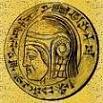

In 605 B.C.E. Babylonian crown prince Nebuchadnezzar II (d. -562) (Nabuchodonosor) (Nabu-Kudurri-Usur) defeats the Egyptians under Necho II (his rival for control of Syria and Palestine) at the Battle of Carchemish (Karkemish) on the W Bank of the Euphrates River 400 mi. N of Jerusalem (Jer. 46:1-2) (35 mi. SE of Gaziantep in S Turkey on the Syrian border), and overtakes and annihilates the fleeing Egyptian army at Hama; both sides take heavy casualties, and Nabopolassar is KIA; Egyptian power in Asia is destroyed (2 Chron. 35:20); "For the mighty man has stumbled against the mighty, and they are fallen both of them together (Jer. 46:12); on the first day of Elul (Aug.-Sept.) his son Nebuchadnezzar II is crowned king of Babylon and becomes undisputed ruler of W Asia (until -562); Judean king Josiah takes on Necho on his way to Carchemish in violation of God's orders, and is wounded by archers and brought back to Jerusalem, where he dies, and Jeremiah utters laments for him, which "are written in the Laments" (2 Chron 35:20-27); Josiah is succeeded by 23-y.-o. Jehoahaz, who reigns 3 mo. until Necho deposes him and lays a tribute of 100 talents of silver and one talent of gold on the land, then makes his 25-y.-o. brother Eliakim king of Judah, changing his name to Jehoiakim (Heb. "He whom Yahweh has set up"), taking his brother Jehoahaz hostage back to Egypt; "He reigned eleven years in Jerusalem, and did what was evil in the sight of the Lord his God" (2 Chron. 36:1-8). About this time "the weeping Jewish prophet" Jeremiah ("Jehovah exalts") begins composing the Book of Jeremiah, a prophecy directed against Israel, Judah and all the nations dictated it to his secy. Baruch (Jer. Ch. 36).
Speaking of ass-wipe? In 600 B.C.E. the Plates of Brass, containing the five books of Moses and "a record of the Jews from the beginning... down to the commencement of the reign of Zedekiah" are brought from Jerusalem to America by the people of Lehi (a descendant of Joseph) in a ship, and find the new land called Bountiful to have "the cow and the ox, and the ass and the horse, and the goat and the wild goat" (1 Nephi 18:25); but first Lehi's sons (by Sariah) Laman, Lemuel, Sam, and Nephi "take the daughters of Ishmael to wife", then Nephi's brothers rebel against him, and Nephi ends up building the ship and becoming the first Columbus, beginning an official chronicle called the Large Plates and Small Plates, which are destroyed in 385 C.E. - all according to the Mormons - wake me up when September ends?
In 598 B.C.E. wicked king Jehoiakim, who had withheld the laborers' wages after building a new palace, and who had ordered the prophet Urijah captured in Egypt, then brought back and killed, rebels in his 3rd year of vassalage to Nebuchadnezzar II, causing the latter to begin sieging Jerusalem.
On Mar. 16, 597 B.C.E. after receiving Jeremiah's prophesied doom, the burial of a he-ass (Jer. 22:13-19), Judean king Jehoiakim loses Jehovah's protection, allowing the Babylonians under Nebuchadnezzar II sieging Jerusalem to capture it on the 2nd day of the Jewish month of Adar, and begin deporting the Jews, along with Jehoiakim (bound in fetters) (2 Chron. 36:6), and the future prophet Ezekiel to Babylon (2 Ki. 24:11-16, Jer: 22:24-27, 24:1, 27:19-20, 29:1-2), taking "part of the vessels of the house of the Lord... and put them in his palace in Babylon" (2 Chron. 36:7); Jehoiachin's 8-y.-o. son (by mother Nehushta) Jehoiachin (Jeconiah) (Coniah) (Heb. "Jehovah firmly establishes") succeeds him as king of Judah, but his reign lasts only 3 mo. 10 days. after "he did what was evil in the sight of the Lord, and in the spring Nebuchadnezzar sent and brought him to Babylon with the precious vessels of the house of Jehovah" (2 Chron. 36:9-10); Nebuchadnezzar then makes 21-y.-o. Mattaniah the new king of Judah under the name Zedekiah (Heb. "Jehovah is righteousness"), and he reigns 11 years in Jerusalem as a puppet; (guess what?) "He did what was evil in the sight of the Lord his God, and did not humble himself before Jeremiah the prophet... he also rebelled against Nebuchadnezzar, who had made him swear by God... all the leading priests and the people likewise were exceedingly unfaithful, following all the abominations of the nations, and they polluted the house of the Lord which he had hallowed in Jerusalem" (2 Chron. 36:12-14), causing "the wrath of the Lord to rise against his people, till there was no remedy" (2 Chron. 36:16), resulting in him eventually ordering the king of the Chaldeans to wipe out his own temple in Jerusalem (Jewish First Temple) to punish them for 70 years (2 Chron. 17-21).

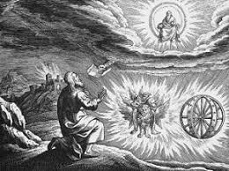

On July 13, 592 B.C.E. Bible prophet Ezekiel is allegedly called by Jehovah in Babylon to warn the pesky Jews to repent before it's too late, which they don't, causing him to lower the boom in -587/-586; he writes the Book of Ezekiel, ch. 1 of which describes a Heavenly Chariot/Throne (Merkabah) (1:16), which sends true believers into tizzies ever after, incl. those who think it's really spaceships: "The appearance of the wheels and their work was like unto the colour of a beryl: and they four had one likeness: and their appearance and their work was as it were a wheel in the middle of a wheel." In 1974 C.E. NASA engineer Josef F. Blumrich (1913-2002) pub. the book The Spaceships of Ezekiel, claiming it was a real spaceship. On Apr. 10, 574 B.C.E. Ezekiel's last oracle of six is recorded, about Ezekiel's Wheel, a wheel within a wheel, according to Ernst Kutsch - a UFO?
In 591 B.C.E. Pstamtik II of Egypt invades Palestine "to foment a general Levantine revolt against the Babylonians" incl. by King Zedekiah of Judah.
On Jan. 27 (Tebeth 10), 589 B.C.E. the Babylonians under Nebuchadnezzar II begin their Final Siege of Jerusalem, releasing Hebrew slaves on Sept. 29 (Tishri 1) at the beginning of the Hebrew Sabbatical year.
In Oct. 588 B.C.E. after King Zedekiah allies with Egyptian Pharaoh Apries, who sends an army to protect Jerusalem, Nebuchadnezzar II lifts the siege of Jerusalem until he defeats them next Apr. in Phoenicia.
On Apr. 29 (Nisan 7), 587 B.C.E. after defeating the Egyptians Nebuchadnezzar II heads for Jerusalem, breaching the wall on July 29 (Tammuz 9) and capturing Zedekiah, who is brought to Big Neb blindfolded (2 Ki. 25:2-8), then retires to Riblah "in the land of Hamath", leaving the siege to his chief bodyguard Nebuzaradan ("Nebo has given offspring") (2 Ki. 25:8-12), who comes to Jerusalem 1 mo. later (Aug. 25) (Ab 7); on Aug. 28 (10 Ab) the Babylonians enter Jerusalem, wreck the wall, and loot the Temple of Jehovah (Solomon) (2 Ki. 25:8-20, Jer. 39:8-10, 43:5-6, 2 Chron.); the Ark of the Covenant is not there (captured by Pharaoh Shishak, or given by Solomon to the Queen of Sheba's son Menelik?); they capture and blind King Zedekiah, slaughter "all the nobles of Judah" (Jer. 39:1-8), and take the remainder of the pathetic Jews into the Babylonian Captivity, allowing some of the lowliest ones to remain; on the 10th day of Ab Nebuzaradan inspects and then burns the temple (on the same day that the rebuilt temple is burned in 70 C.E.) (the Jews commemorate the 7th day of Ab with a fast, and also celebrate the 9th day of Ab, or Tishbah b'Ab); Nebuzaradan releases the prophet Jeremiah from the nasty old cistern where he had been thrown by royal princes Gemariah, Jucal (Jehucal) et al., gives him supplies, and appoints Gedaliah as gov. over those remaining (2 Ki. 25:22, Jer. 39:11-14, 40:1-7, 41:10); the kingdom of Judah ceases to exist, becoming a province of Babylonia, and never again does a king rule in Jerusalem; in 2005 Israeli archaeologist Eilat Mazar et al. find a .04-in. clay seal on the site of the palace which reads "Belonging to Yehuchal son of Shelemiyahu son of Shovi"; another seal contains the name Gemariah, son of Shaphan, the 1st royal minister, Yehuchal being 2nd.
On Apr. 10, 574 B.C.E. Ezekiel's last oracle is recorded, about Ezekiel's Wheel, a wheel within a wheel, according to Ernst Kutsch - a UFO?
About 560 B.C.E. the earliest Hebrew scrolls of the Bible (Gr. "ta biblia" = little library) are written, backdated as far as 1,500 B.C.E.?; "40 independent authors, representing 20 occupations, living in 10 countries during a 1,500-year span, working in three languages, with a cast of 2,930 characters in 1,551 places... This massive volume covers every conceivable subject, expressed in all literary forms - prose, poetry, romance, mystery, biography, science and history" (Terry Hall); the Jewish identity is formed around this little library of books - the hardest years, the darkest years, the wildest years, the hottest years? The two Books of Kings cover Jewish history from Solomon (970 B.C.E.) through this year.


In 556 B.C.E. Cambyses I dies, and his son Cyrus II the Great (d. -529) becomes king of Persia, and builds his capital of Pasargadae near modern-day Shiraz in SC Iran (50 mi. N of Persepolis). In 556 B.C.E. Neriglissar dies, and his son Labashi-Marduk becomes king of Babylon, but reigns only 3 mo. before being killed by his friends, who elevate grass-eating Nabonidus (Nabu-Na'id) (d. -539) in his place next year.
Hey hey, we're the Monkees, er, Medes?In 549 B.C.E. Median king Astyages loses the army and then Ecbatana, and is deposed and killed by his grandson Cyrus II the Great (d. -529), who becomes emperor of Persia and Media, founding the Achaemenid (Achaemenian) (First Persian) Dynasty (ends -330); he goes on to conquer Sogdiana in C Asia between the Jaxartes (Syr Darya) and Oxus (Amu Darya) Rivers.
On Oct. 6, 539 B.C.E. (Oct. 29?) after strange Handwriting on the Wall, "Mene, Mene, Tekel, Upharsin (Parsin)" (Eenie Meenie You'll Tackle a Persian?) (Eenie Meenie Miney Moe, Listen Balshazzar, Out You Go?) allegedly appears on the wall of his court during a "great feast for a thousand lords" where he "drank wine in front of the thousand", overconfident Babylonian co-king (with Nabonidus) Balshazzar (Belshazzar) ignores the "numbered, numbered, weighed and divided" interpretation of captive Jewish prophet Daniel that Jehovah has decided to have the Medes and Persians axe him, and yada yada yada (Daniel, Ch. 5); after diverting the Euphrates so it no longer can act as a big moat, Gobyrus and his warriors find the giant double-leaved main doors in the 300-ft.-high wall open, and enter party-pooped Babylon in the wee hours unopposed, then Cyrus II the Great's Medes and Persians (assisted by the Scythians) conquer it and level it by fire, incl. the Hanging Gardens (only burnt crumbs remain on the plate?); Nabonidus is captured and sent into exile; Balshazzar is killed at the Battle of Opis on the Tigris; Phoenicia is (bloodlessly?) absorbed into the Persian-Median Empire as the 5th satrapy, with admin. center at Tripolis, and vassal kings in Sidon, Tyre, Arvad, and Byblos; N Arabia is absorbed (until -331); the Persians rule Babylonia until -331; never again will Mesopotamia be an independent political entity?

In 538 B.C.E. as one of his first acts after conquering Babylon last year, monotheist Zoroastrian Persian king Cyrus ("Sun", "throne") II the Great (-600 to -529) issues a decree (2 Chron. ch. 36) granting his exiled fellow monotheist subjects the Jews the right to return to Israel, contributing treasure to help rebuild the Temple of Jerusalem (Solomon); the Bible book of Isaiah Chap. 44 and Isaiah Chap. 45, allegedly written 200 years earlier predicts the capture of Babylon by Cyrus, the draining of the Euphrates (44:27), the gates being left open (45:1-2), and even calls him by name (45:1) and describes him as the Anointed (Messiah); 42K-50K (42,360?) Jews from the tribes of Judah and Benjamin return (the Aliyah of Zerubavel), settling in the Persian province of Yehud (Judea), but the majority stay (cooler summers?); the Karaites (Heb. "mikra" = scripture) migrate to the Crimea (Black Sea), where they later adopt Turkish customs and language but remain Jews, reject the rabbinical oral Torah, and never throw a Bible manuscript away (see 1859 C.E.); Jewish leader Mordecai is among the leaders of the returning Hebrews, but not necessarily the same Mordecai who is the cousin of Esther in Isfahan (Ezra 2:1-2, 2:5-7).
In 520 B.C.E. the building of the Jewish Second Temple in Jerusalem begins in earnest under Jewish prophets Haggai and Zechariah, working with Jerusalem gov. Zerubbabel and high priest Yeshua (Joshua) (yes, Jesus); local opponents petition Darius I the Great to have the work stopped (Ezra ch. 5-6), but Darius responds with a decree calling on his imperial officials to support the work based on Cyrus' earlier royal decree, which can never be revoked.
In 516 B.C.E. construction of the Jewish Second Temple is completed during the reign of Persian Achaemenid king #3 (-522 to -486) Darius I the Great (-550 to -486), 70 years after the destruction of the First Temple; Aramaic, the language of the Aramean internat. land traders becomes the universal language of the civilized Western world by the time of Darius I the Great.
In the 5th cent. B.C.E. Jewish minor prophet Joel allegedly lives in or near Jerusalem after the Babylonian Captivity, writing The Book of Joel, which talks about a plague of locusts and how when the Jews get right with Jehovah he will give them plentifiul harvests and establish Jerusalem as a holy city.
In 468 B.C.E. Persian king Artaxerxes I authorizes
In Mar. 455 B.C.E. Artaxerxes I in his 10th year "sent forth the word to rebuild Jerusalem" (Dan. 9:20-27; Neh. 2:1-8), and authorizes the Jews to make their 2nd return to Jerusalem under high priest Ezra the Scribe, who gives a speech exhorting the people to follow the Torah Law and not intermarry with strange religions, and later writes the Book of Ezra and First and Second Chronicles; this is a key year if you believe in Millennial Bible Chronology; the Jehovah's Witnesses consider this to be the 20th year of Artaxerxes I; the walls of Jerusalem are commissioned to be rebuilt, and the prophecy of the 70 weeks of years in Daniel 9:24-25 begins fulfillment, leading up to the baptism of Jesus in 29 C.E. (69 weeks of years = 483 years) (Luke 3:1-2;21-22, Dan. 9:1-4, Jer. 29:10), followed by his death in 33 C.E. (Mark 10:45) - and three more years for the Jews to accept him before they let gentiles in?
About 443 B.C.E. Nehemiah (Heb. "Jehovah comforts") "founded a library and collected books about the kings and prophets, and the writings of David, and letters of kings about votive offerings" (Neh. 2:13-5), writing the Book of Nehemiah, which by -400 is combined with the Book of Ezra.
About 440 B.C.E. Malachi (Heb. "my messenger"), the last book of the Hebrew scriptures is written; Jehovah speaks no more for 400+ years, but when Jeezey comes along, his fulfillment of all them oldy moldy prophecies makes for quite a splash among the gentiles, if not the Jews?
In 331 B.C.E. according to Jewish historian Josephus in his Antiquities 11.317-45, Alexander III the Great visits Jerusalem, and the Jewish elders freak him by reading to him from the Book of Daniel (Ch. 2) the prophesy about the statue with a head made of gold, chest and arms made of silver, belly of brass, legs of iron, and feet of iron mixed with clay, explaining that the head is Babylon, the breast and arms Medo-Persia, the brass belly and thighs Greece, and the iron legs Rome, before or after which he has a dream about the Jewish god being right and sacrifies to him, sparing the city from sacking although putting it under his control; they really read to him from Ch. 8, talking about the shaggy goat with one large horn between its eyes, which is replaced by four horns that have lesser power?; meanwhile after cooperating with Alexander (who thinks Jerusalem is a no-value town run by stargazers?), the Samaritans build their Samaritan Temple to Jehovah on Mount Gerizim.
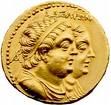
About 275 B.C.E. the Septuagint (Lat. "seventy"), a Greek trans. of the Hebrew scriptures sponsored by Egyptian king (-283 to -246) Ptolemy II Philadelphus (-309 to -246) (benefactor of the Alexandrian Library-Museum) is begun by guess how many Hellenistic Jews in Alexandria (finished by -50).
In the 3rd cent. B.C.E. the Hebrew scriptures begin to be trans. into Aramaic, becoming known as the Targumim.
In the 3rd cent. B.C.E. the Apocryphal Book of Tobit (Tobias), Wisdom of Solomon, Book of Baruch, Four Books of Maccabees are probably written, along with Ecclesiasticus (Sirach) by Ben Sira, son of Joshua (Joshua) (Yeshua) (Jesus) ben Sirach, which becomes the earliest witness to a canon of the Jewish books of the Prophets.
That's why I say, hey man, nice shot? On Dec. 25, 168 B.C.E. (winter solstice) violence begins in Jerusalem when the Syrians dedicate the Temple of Jehovah to the worship of Zeus Olympius by order of Antiochus VI Epiphanes, with an altar to Zeus set up on the high altar of Jehovah, causing the Jews to go nonlinear and revolt, stuffing their Hellenization program up their butts, causing Antiochus IV Ephiphanes to respond with ruthless suppression, overrunning Jerusalem and building the Acra Fortress, whose ruins are identified in 2015 C.E.
About 136 B.C.E. the apocryphal (deuterocanonical) History of Susanna (Heb. "lily"), AKA "Susanna and the Elders", AKA "The Judgment of Daniel", an addition to the Bible book of Daniel is written, becoming one of the first detective stories, where two Jewish elders attempt to frame her on adultery because she won't hook up with them, and Daniel defends her in court, getting them to contradict each other about what kind of tree the adultery was committed under, getting her let off; it gets incl. by the Roman Catholic and Eastern Orthodox Churches in the Book of Daniel as Ch. 13 along with The Song of the Three Holy Children (Young Men), The Prayer of Azariah (Abednego) (in the furnace), and The History of Bel and the Dragon (where Daniel proves that the priests of Bel or Baal sneak into his temple and eat his sacrifces, and later kills a snake by feeding it pitch, hair, and fat, featuring an appearance by Jewish prophet Habbakuk, who brings him some stew in the lion's den) in the Greek Septuagint and Roman Catholic Latin Vulgate (all written in this cent.?), but they are all later omitted from Protestant Bibles.


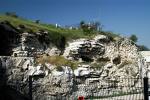
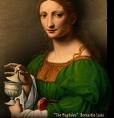
33 On Apr. 3 (Fri.) (3:00 p.m.) there is a lunar eclipse; astronomers Colin J. Humphreys and W.G. Waddington claim that Jesus Christ was crucified on this day - could it be, no? Liar, Lunatic or Lord? The entire future of the Western and half of the Eastern world is changed by what allegedly happens to one man in a backwater of the Roman Empire about this time? This job's a dead end; you can do better girlfriend? Jesus Christ starts the year E of the Jordan River (John 10:40-42), preaching in Perea and other cities on a slow walk toward Jerusalem, recruiting his first 12 Disciples (Apostles) (Mt. 4:18-22, Mk. 1:16-20, Lk. 5-11) by the Sea of Galilee, starting with fisherman (St.) Andrew the Apostle (First-Called) (5-62) and his brother fisherman Simon Peter the Apostle (firt pope), dubbing them "fishers of men" (Matt. 4:18-22) (Mark 1:16-20) (Luke 5:1-11) (John 1:35-42), (St.) James the Great(er), son of Zebedee, John of Patmos the Apostle (Evangelist) (Elder) (6-100), "the Beloved Disciple" (youngest) (brother of James), Philip (-80) (John 1:43), Bartholomew, Matthew, the tax collector (Mt. 9:9-13, Mk. 2:13-17, Lk. 5:27-28), Doubting Thomas (Didymus) (Lat. "twin") (-72), James the Less(er)/Younger/Little, son of Alphaeus, Simon the Zealot (Canaanite) (Cananaean), Judas (Jude) Thaddaeus (Lebbaeus), son of James (Lk. 6:16) (Acts 1:13), and Judas Iscariot, stopping in Bethany to raise Lazarus from the dead (John 11:1-46), then after skirting Jerusalem he goes through Samaria, back through Perea, where he foretells his death and resurrection for a 3rd time (Matt. 20:17-19, Mk. 10:32-34, Luke 18:31-34), passes through Jericho, healing two blind men, then visits Zacchaeus (Matt. 20:29-34, Mt. 10:46-52, Luke 18:35-19:28); six days before Passover he arrives in Bethany (John 11:55-12:1), has a feast at the house of Simon the Leper, is annointed by Mary of Bethany (Matt. 26:6-13, Mt. 14:3-9, John 12:2-11), then on Nisan 9 (Palm Sunday) finally makes his Triumphal Entry into Jerusalem (Matt. 21:1-11, 14-17; Mk. 11:1-11, Luke 19:29-44, John 12:12-19), cursing a barren fig tree on Nisan 10 (Matt. 21:18-19, Mk. 11:12-17, Luke 19:45-46); on Nisan 11 the barren fig tree is found withered (Matt. 21:19-22, Mk. 11:20-25), and he has fun in the Temple of Jerusalem, overturning the moneychanger's tables, then retreating to the Mount of Olives; on Nisan 12 the Jewish leaders plot his death, and cut a deal with traitor disciple Judas (Yehuda) Iscariot, the one who keeps the money bag; on Nisan 14 (Thur.) (Mt. 26:17-30) (Mk. 14:12-26) (Lk. 22:7-39) (John 13:1-17:26) (Ex. 12:18) Jesus and his disciples celebrate the Last Supper, held in the Cenacle (Upper Room), where Jesus predicts his betrayal by you know who Judas Iscariot and that you know who Peter will deny knowing him 3x before the cock crows (sunrise), instituting the Eucharist; it was not a Passover meal but a run-of-the-meal Jewish meal?; on Nisan 15 (Fri.) (First Passover) after praying in the Garden of Gethsemane (Aramaic "olive oil press") at the foot of the Mount of Olives, where "his sweat was as it were great drops of blood falling down to the ground" (Luke 22:43-4), Jesus of Nazareth (Christ) (b. -7 to -2?) (clean shaven or bearded?) (single or married?) (does he or doesn't he?) (swings both ways or what?) is betrayed with a kiss by his disciple Judas Iscariot for 30 pieces of silver (the kiss is to tell him apart from disciple James the Lesser, brother of Matthew, who allegedly looks a lot like Jesus but isn't as good a kisser?), and taken to the Jewish high priests, who can't stand his blasphemous jive honky mouth and spit on him and slap the faker, then hand him over the Romans, talking Pontius Pilate into having him flagrantly scourged with flagrums (flagri) (2-3 thongs with bell-shaped thingies to cause pain?); then noting that Tiberius extended the law of laesa majestas (injured majesty) to include mere libelous words against the emperor under the definition of sedition, Pontius Pilate legally orders his execution (John 19:12-16), and after Simon of Cyrene (a Greek city in the Roman province of Cyrenaica, with a pop. of 100K Judean Jews, meaning he wasn't necessary black?) helps him carry his cross (Mk. 15:21), Jesus is crucified on a cross (hung on a stake?) at Cavalry Hill (Golgotha) (Lat. "calvariae locus" = Gr. "kranion topos" = Aramaic "Golgotha" = "place of the skull") outside Jerusalem on Passover, Nisan 14 (Fri.), where he gives up the ghost about 3 p.m. as the sky grows dark?; last words (KJV): "It is finished" (Gr. "Tetelestoi") (John 19:30) (same words said by the high priest after the Passover lambs are sacrificed); "My God, my God, why hast thou forsaken me?" (Matt. 27:46, Mark 15:34); "Father, into thy hands I commend my spirit" (Luke 23:46); wealthy Jew (metals trade, dealing with Cornwall in Britain?) and secret Christian (member of the Sanhedrin) Joseph of Arimathea (owner of the Garden of Gethsemane?) requests his body from Pilate and places it in his own newly-dug tomb (Matt. 27:57-60), although by Roman law crucified criminals can't be buried but are to be left hanging for the birds and beasts to feast on; too bad (too good?), early on the morning of Nisan 16 (Sun.) his tomb is found empty, and his true believers begin seeing things, claiming to see him appear and disappear, not only to them, to everybody, since he immediately proceeds to give the absolute proof that he's the Son of God and that his conviction by human courts was overturned by the Supreme Court of Heaven to silence all skeptics by making his second triumphal entry into Jerusalem in front of multitudes, where he walks up to Pilate and kisses him on the pucker, er, he skips that and leaves the 3-D holographic Burial Shroud of Christ, which becomes hard to prove exists for the next millennium or more, but wows scientists in the 20th cent.?; meanwhile after Jesus II kind of sneaks around and only visits his own for awhile (if only he had gone back to Big J, imagine the high priest's face, er, maybe it's all a test for them stiff-necked Jews, who would have just sent him back to the Cross again and again and again, shut your mouth?), he gives his disciples the Great Commission (Mt. 28:18-20), then decides a wife and kids ain't worth it and retires from the flesh biz without having to be bitch-slapped and crooseefied again, and disappears into the sky on the 40th day of his new life (Ziv or Iyyar 25) at the Mount of Olives (Olivet) near Bethany (2 mi. ESE of Jerusalem) (home of his friend Lazarus and his sisters Martha and Mary) (Acts 1:9-12); meanwhile, wasting no time, the first crop of 120 Christians (Gk. "little Christs") and Jewish proselytes (from around the Roman empire?) gather in Jerusalem on Pentecost (Festival of Harvest) (Festival of Weeks) (Day of the First Ripe Fruits), 50 days after the Passover (Sivan 6), where they receive the "Holy Spirit", speak in tongues and launch the World Religion of Christi[ns]anity (Acts 1:13-15), the belief that he rose from da dead and only his shed blood is truly lifesaving, plus plus plus take a bath and sign right here and you're saved, don't ask for a corpse or a skeleton he flew the coop and is looking back at ya from Heaven (thank god, I'm so sick of New York?); meanwhile true-moneygrubbing-Jew traitor apostle Judas Iscariot buys the Aceldama (Akeldama) (Aramaic "hagel dema" = field of blood) (Matt. 27:7) S of Jerusalem with his 30 pieces of silver (which he returns?), then does a swan dive, "falling headlong, burst open in the middle and all his bowels gushed out" - Acts 1:18); seven qualified men are appointed as food distributors for the Christian Jewish congregation, the only non-Jew being Nicolaus of Antioch (Acts 6:1-6); the 11 remaining original apostles go out and preach the good news, and all are martyred (Stephen is stoned, Matthew is slain in Ethiopia, Mark is dragged through the streets until dead, Luke is hanged, Peter and Simeon are crucified, Andrew the First-Called (5-62) is crucified, Philip is crucified and stoned, James is beheaded, Barholomew is flayed alive, Thomas is pierced with lances, James the Less is thrown from the Temple of Jerusalem and beaten to death, Jude is shot to death with arrows, Matthias is stoned to death, Paul is beheaded) except John, who ends up in W Asia Minor and outlives the rest, reaching 100?; Peter goes to Gaul (Chartres), Britain (Cornhill), and Rome?; Matthew goes to Ethiopia and resides with an official converted by Philip?; Philip acompanies Lazarus, Mary Magdalene, Joseph of Arimathea et al. on a preaching mission to Gaul, with Lazarus and Mary remaining in Marseille, after which Philip sends Joseph of Arimathea with 12 disciples to Christianize Britain, founding a monastery at Glastonbury, and bringing the Holy Grail with him?; Matthias (one of the Seventy) goes to Armenia?; Jude Thaddaeus goes to Edessa and cures King Abigar with the Shroud (Mandylion)?; Simon and Jude go to Mesopotamia?; Andrew goes to Byzantium?; red-haired Mary Magdalene (of Magdala), Christ's wife, carrying his child and meant to run her hubby church is overthrown in a coup led by woman-hating, er, Peter, and flees to France with her red-haired daughter Sarah, carrying the sang real, the royal blood of Christ, and spawning the legend of the San Greal, or Holy Grail (Sang Real, or Royal Blood)? ("Witness the greatest coverup in history" - Dan Brown?) - ready or not, there I go?; Jehovah prepares to quit sticking with the home team despite his long-time partiality, divorce his wife the Chosen People, take away their driver's licenses, make the mean nasty Romans destroy his former temple and priesthood, and get them dispersed out of their former land of milk and honey, where they will be forced to fend for themselves in a sea of goyim, but not right away, giving them 40 years to repent for what they did to his only begotten Son? The Jewish Temple will then no longer be needed, as the body of each believer is a temple, and the only sacrifice needed is the blood of the Lamb, s orry rabbi, kicks are for Trids?; yes, as a just God he must give them the customary 40, but funny how the first Gospels spring up after the Temple is destroyed, forever giving skeptics a platform to claim that Jeezy was all made-up afterwards when all the possible witnesses is kaput, and all the mean persecuting Jews iz taken care of, like magic, er, that would make it true, check back in 2,000+ years?
In 34 C.E. according to the Book of Mormon, the risen Jesus Christ visits America to plant Christianity among the Nephites, while the Great Apostasy begins in Jerusalem, where the true faith of Christ is corrupted and its leaders corrupted or killed, ending with Joseph Smith's First Vision in 1820; after a fierce storm and major earthquake that destroys Zarahemla (which is rebuilt later in this cent.), Jesus appears at the temple in Bountiful, and preaches a version of the Sermon on the Mount (Matt. 5-7) that follows the King James version but doesn't jive with the original Greek, making it "the Achilles heel of the Book of Mormon"?
About 130 C.E. Aquila of Sinope (Pontus), a Roman who converted to Christianity then to Judaism, and became a disciple of Rabbi Akiva compiles a literal Greek Old Testament trans. in Jabneh (Jamnia) that is preferred by many Jews to the Septuagint, which the pesky Christians contains numerous prophecies of their Savior Jesus Christ.

In July 144 C.E. self-made Black Sea shipowner (2nd cent. Bill Gates?) Marcion of Sinope (85-160), who moved to Rome, gave a huge donation to the Church, and spent five years there studying, preaching, and writing, becoming an Apostle Paul fan, presents his new Marcionite Doctrine, showing how the bald contradictions between the gods of the Old and New Testaments, combined with Paul's statements that faith and not law saves, proves that the Old Testament Jehovah (El) (Israel) is really the Devil, and that the Old T should be thrown out, shocking the Roman Christians, who kick him out and refund his money, after which he compiles the first Canonical List of Scriptures (10 of Paul's 13 epistles, excluding the "pastoral" epistles 1 & 2 Timothy and Titus), plus the Gospel of Luke, with all references to Jehovah and the Law edited out); after he is excommunicated by Pope Pius I, he founds his own Christian Marcionite sect, which lasts until the 5th cent.; this all causes the Church to work harder to fix its own NT canon.

In 309 (305?) C.E. Neoplatonist philosophy, er, philosopher Porphyry of Tyre (b. 233) dies, leaving the (tiring?) 15-vol. pagan bestseller Against the Christians (Adversus Christianos), which shows that the Book of Daniel was written by a Jew during the time of Antiochus Epiphanes (216-164 B.C.E.); "If the writer was not Daniel, then he lied on a frightful scale, ascribing to God prophecies which were never uttered, and making claim of miracles that were never wrought. And if Daniel's authorship could be shown to be false, then Christ Himself would be proved to bear witness to an imposter." (Matt. 24: 15); too bad, it is banned by Constantine the Great and ordered burned in 443 - too little too late?

In 367 C.E. Christian bishop Athanasius of Alexandria (296-373) writes his 39th Annual Pastoral (Festal) (Easter) Letter to the Churches of Egypt, listing the 22 books of the Old Testament (plus the Book of Baruch and the Letter of Jeremiah, minus the Book of Esther), and the 27 books of the New Testament canon for the first time ever, listing "fourteen letters of Paul to the apostle", incl. "two to the Corinthians".
In 382 C.E. the Council of Rome (Damasine Synod), called by Pope Damasus I and attended by St. Jerome fixes the canon of New Testament as the same books Athanasius listed in his Festal Letter, and also fixes the canon of the Old Testament.

In 392 C.E. Judean-born St. Epiphanius of Salamis (310-403) writes On Weights and Measures; names four major Greek translations of the Hebrew Old Testament incl. the Septuagint, one by Aquila of Pontus, one by Theodotion, and one by Symmachus; claims that the translation of the Septuaging was done by 72 translators (six from each of the 12 tribes of Israel) were assigned to 36 cells on the Pharian island, with each cell assigned one Bible book, with Ruth and Judges joined into a single book, along with Ezra and Nehemiah, First and Second Chronicles, First and Second Samuel, and First and Second Kings.
In 397 C.E. the Third (3rd) Council of Carthage, attended by Augustine compiles an official Bible canon, accepting the Big 27 Books of the modern-day New Testament, but incorporating the Apocrypha; the Eastern churches reject the latter.

In 405 C.E. after being commissioned by Pope Damasiius I in 382 to revise the Vetus Latina (Old Latin) version of the Old and New Testaments, Stridon, Dalmatia-born St. Jerome (340-420) pub. The Vulgate Bible (Lat. "versio vulgata" = commonly-used version), the first Latin trans. of the Bible, using his vast knowledge of Latin, Greek, and Hebrew to create a work that the commoners can understand and the scholars can appreciate; too bad, literacy is virtually kaput until the 11th and 12th cents.; the Council of Trent (1545-63) makes it the official Latin Bible of the Roman Catholic Church.
In 450 C.E. the final canon of the 24-book Hebrew Bible (Tanakh) (first fixed by Ezra and the scribes) is compiled by the 120-member Men of the Great Assembly (Synagogue) (Anshei Knesset HaGedolah); it consists of the Torah (Books of Moses) (Pentateuch) (5 books), Nevi'im (19 Prophets) (8 books), and Ketuvim (Writings) (11 books, incl. the Five Megillot).
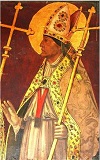
Pull over and let me drive? In 686 C.E. virulently anti-Semitic Spanish Roman Catholic #1 bishop Julian of Toledo (642-90) (of Jewish descent?) writes De Comprobatione Aetatis Sextae Contra Judaeos, expounding on the Messianic prophecies in the Bible with the intention of converting Jews while defending against Jewish arguments that Jesus is not the Messiah; it seems the Jews were converting Christians, despite the dire penalties? In 688 C.E. he writes Prognosticum Futuri Saeculi (3 vols.), a dissertation on death, the situation of souls before the final Parousia of Christ, and the resurrection of the dead, becoming a Medieval bestseller, with up to 2K mss. made by the 12th cent.
In the 8th cent. the pro-Islamic Gospel of Barnabas is written, claiming that Jesus was just a man and that it was Judas who was crucified.
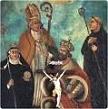
On Nov. 11, 725 C.E. English Benedictine monk (St.) Willibald (700-87) of Eichstatt in Bavaria reaches Jerusalem, becoming the first Englishman in the Holy Land, then later is arrested in Emessa as a Christian spy by the Muslims, and imprisoned in Constantinople; he visits a church in Bethsaida, which he claims "was built over the house of Peter and Andrew"; in 2017 archeologist Steven Notley discovers a real church buried there.

On Apr. 21, 1073 Pope (since Oct. 1, 1061) Alexander II dies, and on Apr. 22 his faithful midget chancellor Hildebrand of Sovana is elected Pope #156 Gregory VII (1023-85) (until May 25, 1085), going on to initiate the Gregorian Reform to stamp out sin in the Church, incl. the keeping of wives and mistresses by priests, and work to make the papacy strong, clericalize the Church, and arrogate supreme authority to the papacy over all the rising rulers and princes around him, requiring them to literally kiss his foot, causing German bishops to oppose his confirmation; as a safety move, he prohibits Bible reading as leading to pesky heresy; meanwhile he keep his own mistress, Countess Mathilda of Tuscany (Canossa) (1046-1115), whose husband Duke Godfrey IV the Hunchback (-1076) spreads stories about him being an atheist; not that he's all bad, since he gets off on scourging himself and watching others being scourged - sad reversal of the Jesus story?
Early in the 13th cent. the Pre-Alphonsine Medieval Romance Bible (Biblia Medieval Romanceada Prealfonsina) is pub., becoming the first complete Spanish Bible.
In the 13th cent. the 165-lb. 36 in. long x 9 in. thick Codex Gigas (Big Book) is supposedly created by Herman the Recluse in the Benedictine Monastery of Podlazice in Bohemia near modern-day Chrudim, Czech. in one night with the Devil's help, but really produced by a single monk over a 25-year period?; contains a large portrait of the Devil, causing it to be known as the Devil's Bible; in 1295 it is pawned to the Sedlec Monastery; in 1648 the Swedish army takes it as plunder, ending up in the Swedish Nat. Library, becoming the largest medieval ms. to survive to modern times; it took 160+ animal skins to make it; contains the Vulgate Bible, Josephus' "Antiquities of the Jews" and "De Bello Iudaico", Isidore of Seville's "Etymologiae", Cosmas of Prague's "Chronicle of Bohemia", two books by Constantine the African et al.

On Dec. 11, 1206 after Subprior Reginald spills the beans on his trip to Rome for confirmation, King John forces them to elect John de Grey as Canterbury archbishop; meanwhile Pope Innocent III has his own ideas, and invalidates both of them and selects his old Paris U. student friend Stephen Langton (1156-1228) (inventor of the chapter division of the Bible this year) to fill the vacancy, but John refuses to recognize his election, protesting that this Frenchie has no political qualifications, starting a 6-year war.

How do you approach the Word of God? You don't? Progresso, what a soup of holy words shouldn't be? In 1229 after the first hand-copied partial translations of the Bible by the pesky Albigensians begin appearing, the (non-ecumenical?) Council of Toulouse forbids lay persons from reading the Bible, to be enforced by the Papal Inquisition, run mainly by the Dominicans (is that a Bible in your pants or are you just happy to see me?); "Search the Scriptures, for in them ye think ye have eternal life, and they are they which testify of me" (John 5:39); "Use of the vernacular [would mean] demolition of a language barrier that safeguarded the clergy's exclusive dominion over religious matters" (Massimo Firpo); meanwhile the U. of Toulouse is founded in Toulouse, France, becoming the 2nd oldest univ. in France and one of the oldest Euro univs. to survive to modern times; it is later renamed in honor of 1912 Nobel Chem. Prize winner Paul Sabatier (1854-1941).
Jesus rolls over in his empty tomb? In 1231 now that Bible reading has been prohibited (1229), and pesky Bible-thumpers continue to read it and point out that the Church's doctrines contradict it, Pope (since 1227) Gregory IX (1145-1241) institutes the search-and-destroy Holy Office, AKA the Inquisition, in the hands of the Dominicans, for the apprehension, torture (begun 1252?) and trial of heretics, enacting a law for Rome that heretics condemned by an ecclesiastical court are to be delivered to the secular power to receive their "due punishment", i.e., death by fire, or life in a horrible inhumane prison; this wonderful development in Catholic theology goes on to morph into the Spanish Inquisition in 1478, and the Portuguese Inquisition in 1531, burning its first Protestants in Spain in 1543; it is finally abolished (suspended until future notice?) after 666, er, 603 fun years in 1834; one good thing: Gregory IX absolves those who violated the ban by the 1215 Fourth Lateran Council on teaching Aristotle, but renews it "provisionally, until the books of the philosopher had been examined and expurgated", appointing three Parisian masters to the job, which they give up on; another good thing: Gregory IX exempts the Jews from the jurisdiction of the Inquisition, except when they attack Christianity, attempt to Judaize Christians, or revert to Judaism after Christian conversion.
The first post-it notes are in the Bible? In 1328 English chronicler Nicholas Trivet (Nicolas Trivetus) (1257-1334) pub. the first postil (postilla) (from Lat. "post illa verba textus"), a Biblical commentary affixed to a text, later evolving into a printed homily.

The first Jehovah's Witnesses come from Oxford? In 1374 Gray-bearded Oxford U. prof. of divinity ("the Morning Star of the Reformation") John Wycliffe (OE "white cliff") (1324-84), having conquered Oxford and made it the spiritual center of England begins preaching his anti-clerical doctrines from the pulpits of London under the patronage of John of Gaunt, and is employed by the govt. to negotiate with the papacy over provisions, becoming Edward III's chaplain; as a church reformer he gets so impatient to get an English trans. of the Bible into the common man's hands that he begins translating it single-handedly, while pub. tracts decrying the secularization of the Church, and claiming that all religious doctrines should be based on the Bible, not tradition or church synods, and that people should have direct access to God and therefore don't need auricular confession, denying the core concept of the Roman Catholic Church, drawing mojo from the inability of the clergy to deal with or even explain the Black Plague except as God's judgment against them; in ? he pub. De Civili Domino (On Civil Authority or Dominion), proposing the disendowment of church property and the exclusion of the clergy from civil govt.; his itinerant proselytizing Poor Preachers, scornfully known as Lollards (Dutch "babblers") spread throughout England, at first reading portions of Wycliffe's English Bible trans. to eager crowds, then teaching people to read his Bible on their own, successfully making a large number of converts, incl. wealthy townsmen and country gentlemen, and doing so well that it is said that every 4th (3rd) (2nd) man is a Lollard. Pope Gregory XI announces that the Inquisition has the right to intervene in sorcery trials, which hitherto had been considered purely civil matters.

In 1380 Oxford U. theologian John Wycliffe (1324-84) gives a sermon in which he utters the soundbyte: "How should God approve that you rob Peter, and give this robbery to Paul in the name of Christ?"

135 years before Martin Luther of Germany, an anti-Roman Catholic Reformation is brewing in England? In 1382 John Wycliffe (1324-84) pub. English Trans. of the Latin Bible; first new trans. in a millennium, based on the Latin Vulgate Bible; actually Wycliffe doesn't merely translate but creates the New Testament, writing it originally in English and Latin, and it is actually a code history of 14th cent. Europe, incl. the Avignon papacy?; Confession Concerning the Eucharist; denies that the "substance" of bread and wine are miraculously annihilated during the Eucharist - the secrets that made it taste so good?
In 1471 the first complete Bible in Italian, by Camaldolese monk Niccolo Malerbi (Malermi) (1422-81) is printed in Venice after spending only 8 mo. doing the trans. work, becoming the first printed Bible in Italian to achieve significant circulation.
In 1488 the first trans. of the complete Bible into Czech (Bohemian) is pub. in Prague; next year an ed. with illustrations is pub. in Kutna Hora.

The infallible Word of God of Protestant Bible-thumpers gets off to a fallible start? In Oct. 1516 Dutch Roman Catholic scholar-priest-monk Desiderius Erasmus of Rotterdam (1466-1536) pub. ("rushes out rather than edits") ("praecipitatum verius quam editum") the Textus Receptus (Lat. "received text") of the New Testament (Novum Instrumentum Omne), with side-by-side Greek and Latin text, becoming the first Bible divided into verses; the first ed. uses the Latin Vulgate, which the Church considers as "their" Bible, but in later eds. he pisses-off Roman Catholics by using his own Latin trans. of the Greek in its place; he uses a small set of late medieval (12th cent.) mss. found in Basel, plus a ms. of St. John's Revelation borrowed from friend Johannes Reuchlin, which is hard to read and is missing the final six verses, causing him to fill in from the Latin Vulgate, creating a bastard Greek ms., which is later used to prepare the King James version; he pisses-off the Trinitarians by not incl. the Johannine Comma (Comma Johanneum) (Heavenly Witnesses) in 1 John 5:7-8: "There are three that bear witness in heaven: the Father, the Word, and the Spirit, and these three are one; and there are three that bear witness on Earth, the Spirit, the water, and the blood, and these three are one", because it is not found in Greek mss., only "There are three that bear witness: the Spirit, the water, and the blood, and these three are one", but later tickles the Trinitarians pink by incl. it in later eds. after they give him a fake Greek ms. in which they insert it themselves?; he goes on to pub. four more eds. by 1535, which become the "editio princeps" used by W European printers for the next three cents.; English royal physician Linacer (a Roman Catholic) gets and reads a copy, then exclaims "Either this book is not true, or we are not Christians" (a true Protestant in the making?). In Jan. 1548 Erasmus posth. pub. The First Tome or Volume of the Paraphrase of Erasmus Upon the New Testament ed. by Nicholas Udall; pub. by Edward Whitchurch; Erasmus' trans. of the New Testament interleaved with an English trans.; vol. 2 pub. in 1549; a royal injunction orders copies to be kept in every parish church in England.
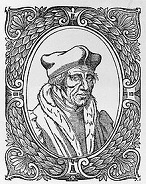
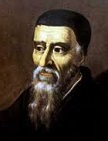
In 1521 the College of Sarbonne in Paris condemns a book by reformer (humanist) Roman Catholic theologian Jacques Lefevre d'Etaples (Jacques Lefèvre d'Étaples) (1455-1536) rejecting the view of the Three Marys of the Gospels being the same person; in 1523 he pub. a French trans. of the New Testament, followed by the whole Bible in 1530, helping launch Protestantism and making a fan of William (Guillaume) (Guilhem) Farel (1489-1565), who becomes an evangelist and founds the Reformed Church in Switzerland; in 1525 the theology faculty of the U. of Paris forbids further translations of the Bible.

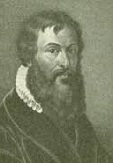
In 1525 English scholar William Tyndale (1495-1536), fulfilling his vow "If God preserves my life, I will cause a boy that driveth a plow to know more of the Scriptures than the pope", finishes his trans. of the New Testament into English from the original Greek (instead of the Latin vers. used by John Wycliffe in 1381), then has it printed in "safe" Germany by Peter Schoeffer (Schöffer) (1425-1503) (apprentice of Johannes Butenberg) in Worms before being smuggled into England; he then begins work on the Old Testament. In 1530 William Tyndale coins the word "Passover" followed next year by "Evangelical"; he also claims that "the properties of the Hebrew tongue agreeth a thousand times more with the English than with the Latin".


In 1526 English scholar Myles (Miles) Coverdale (1488-1569), who entered the Augustinian monastery of Cambridge in 1514 after Roman Catholic ordination as a priest leaves after being influenced by prior Robert Barnes (1495-1540) (who went Lutheran), and hooks up with William Tyndale (1494-1536), starting to trans. the Bible and Apocrypha into English.

In 1532 Antonio Brucioli (1497-1566) pub. Italian Trans. of the Bible in Venice; Protestant-leaning Roman Catholic humanist becomes the first to trans. the Bible from the original Hebrew-Greek texts, incl. the big buzzword "Ieova"; it becomes popular among Italian Protestants for the next cent.

In 1534 Martin Luther (1483-1546) pub. Die Bible, the complete Bible in German; like an A-bomb dropped on Germany, allowing everybody to finally read the Bible themselves and see how Roman Catholic Church teachings don't square with it?
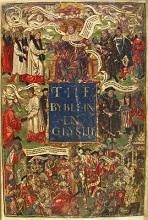

In 1535 Myles (Miles) Coverdale (1488-1569) pub. The Bible and Apocrypha in English in Antwerp, becoming the first complete English trans. in printed form, dedicated to Henry VIII but printed abroad; its distribution in England is greatly facilitated by the king after the break with the pope; his phraseology is incorporated in subsequent English Bible versions - read it from coverdale to coverdale? In fall 1539 the English govt. pub. Coverdale's The Great Bible, commissioned by Thomas Cromwell, becoming the official English version for the Anglican Church; the cover shows Henry VIII at the top, with Christ whispering into his ear as he passes on the word of God to Archbishop Cranmer and Cromwell, who passes it to the clery and laymen, who cry "Vivat Rex" (God save the king); Cromwell orders one to be housed in every church in England; "Go to now (most dear reader) and sit thee down at the Lord's feet and read his words, and, as Moses teacheth the Jews, take them into thine heart, and let thy talking and communication be of them when thou sittest in thine house, or goest by the way, when thou lyest down, and when thou riseth up. And above all things fashion thy life and conversation according to the doctrine of the holy ghost therein." (preface)

On Oct. 6, 1536 after being condemned in Brussels at the behest of Henry VIII, Lutheran sympathizer William Tyndale (b. 1494) is strangled and then burned at the stake by the Old Skool, who consider the Bible dangerous in the hands of the unlearned for making an "illegal" English trans. of the Bible; his last words: "Lord, open the king of England's eyes".
In 1539 Richard Taverner (1505-75) pub. The Taverner Bible; a revision of the Matthew Bible; doesn't make much of a splash because of tardy timing.
In 1546 Roman bishops at the Council of Trent decide that the Church "venerates equally" the Bible and written and unwritten traditions, thus beginning the Tridentine Church, the modern Roman Catholic Church; the Apocrypha are decreed to be of "equal veneration" with the other books of the Bible, and an anathema is pronounced against all who do not receive them as sacred and canonical; failing to agree whether vernacular translations of the Bible are "the mother and origin of all heresies" or that prohibition would give Protestants ammunition in claiming that the Church is attempting to hide "fraud and deceit", the Latin Vulgate trans. is sanctioned as the standard text for the Church, stifling vernacular translations by default - if it makes you happy then why the hell are you so sad?

In 1551 Paris printer Robert Estienne (Robertus Stephanus) (1503-59) (Roman Catholic-turned-Protestant) introduces the modern verse division of the Bible in his 4th ed. of the Greek New Testament; to give God his due the divisions are sometimes caused by his horse hitting a bump in the road as he works on horseback? - pesky Protestants can now cite chapter and verse in their arguments against Church authorities, who don't accept their paradigm that the Bible is all there is to God's Word?

In 1557-60 William Whittingham (1524-79), Myles (Miles) Coverdale (1488-1569) et al. pub. The Geneva Bible in London, an inexpensive portable English Bible with extensive Calvinist-slanted "annotations upon all the hard places" (marginal glosses), which piss-off Anglican prelates, who associate it with Presbyterians, who wish to abolish the Episcopalian form of govt. by bishops and replace it with govt. by lay elders; it's also furnished with instructional aids, becoming the first study Bible, and the first using verse numbering by Robert Estienne (Stephanus) of Paris; dedicated to Queen Elizabeth I, it is often used and/or quoted by John Knox, John Bunyan, John Donne, Oliver Cromwell, and Shakespeare, and later preferred by Puritans over the King James Bible, dissing the divine right of kings and always translating the word king as tyrant, causing Charles I to ban it in 1644, leading to Puritan takeover of the govt. and his beheading, even though they later realize the superiority of the 1611 KJV.
In 1559 "The Church has always fulfilled its duty to keep books under surveillance, but until the invention of printing, it did not feel the need to compile a catalog of prohibited books because those writings considered dangerous were burned" (Enciclopedia Cattolica); now that the Devil's invention of the printing press is running amok, threatening the status quo, Pope Paul IV pub. the first Index Autorum et Librorum Prohibitorum AKA the infamous Index of Forbidden Books, used to retard any and every religious, scientific, social or political advance from here on out, going through 19 eds.; Roman Catholics are forbidden to read, sell, translate, or possess them under penalty of excommunication; the reading of vernacular translations of the Bible is prohibited; "In practice, Bible reading by laymen ceased completely for centuries. The Bible became virtually an unknown book, and millions of Italians lived their lives without ever reading a page of it" (Mario Cignoni); "All prohibited books contained in the brief shall be collected. Those by heretical authors shall be burned publicly in the auto da fe; the rest shall be placed in some well-secured room of the inquisition... As far as books in the humanities are concerned, which may contain glosses, arguments, letters, or annotations by Philipp Melanchthon or other heretics, they will be returned to their owners once the heretical annotations have been removed or crossed out... A book of medicine, entitled 'Paradoxas de Fusion', printed in Venice in 1547, is said to contain suspicious things even though it is not placed in the catalogue; it must be prohibited." (Decree of the Supreme on Books, 1558)

In 1568 Archbishop Matthew Parker (1504-75) (ed.) pub. The Bishops' Bible; rev. eds. in 1572 and 1602; supersedes the Great Bible of 1539, and the Geneva Bible of 1557-60; trans. by a committee of bishops appointed by Elizabeth I to supposedly be free of political influence, producing an uneven product that satisfies nobody, spurring production of the 1611 King James Bible?; produced by the Church of England to succeed the Great Bible of 1539 and the Geneva Bible of 1557-60, with the Old Testament and Apocrypha translated from the original languages instead of the Latin Vulgate like the Geneva Bible.


In 1568 Christophe Plantin (1520-89) of Antwerp pub. The Royal Bible (Biblia Regia) (Antwerp or Plantin Polyglot Bible) (8 vols.) (1568-73) (Hebrew, Greek, Aramaic, Latin, Syriac), ed. by Spanish Roman Catholic priest Benito Arias Montano (1527-98) and sponsored by Philip II of Spain, based on the Complutensian Polyglot of 1514; 1,213 copies made at 70 guilders each; it becomes the first Bible to make the 5th cent. Syriac Peshitta vers. of the New Testament available to European scholars; the most important typographic achievement by a single printer in the 16th cent.?; used by the translators of the 1611 King James vers.; Spanish theologian Leon de Castro of the U. of Salamanca gets Montano in trouble for using Jewish rabbinical writings and for deleting pro-Trinitarian texts found in the Latin Vulgate but not in the original Hebrew text, such as 1 John 5:7 ("in heaven, the Father, the Word, and the Holy Ghost: and these three are one"), and it takes until 1580 for him to beat the charges.
In 1571 the Bible becomes available in Portuguese.
In 1579 Unity of the Brethren pub. Kralice Bible (6 vols.) (1579-83), the first complete Bible trans. in Czech from the original languages; 3rd ed. 1613; incorporates the Czech trans. of the New Testament by Jan Blahoslav (1523-71).
In 1582 the English College of Douai (founded 1561) in N France on the Scarpe River pub. The Douay (Douai) New Testament, an English Roman Catholic trans. of the 5th cent. Latin Vulgate Bible, pub. in Reims, France; the Old Testament follows in 1609-10.
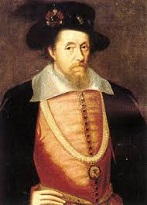
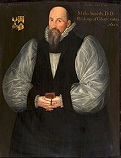
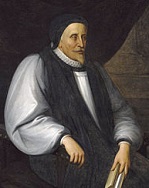
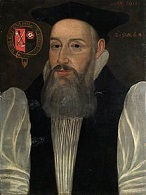
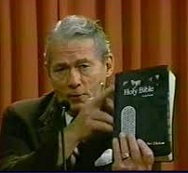
In 1611 English King (1603-25) James I (1566-1625) (ed.) pub. the King James (Authorized) Version of the Holy Bible (66 books), commissioned in 1604 (lucky that the 1605 Guy Fawkes Plot to replace the govt. with Roman Catholics didn't succeed), with the work divided between 47 translators (47 Anglicans, 0 Puritans, 0 Roman Catholics, 0 Separatists) in six committees with 15 rules to follow, using ancient mss. for reliability, and deliberately preserving ambiguities, e.g. Romans 5:12: "Wherefore, as by one man sin entered into the world, and death by sin; and so death passed upon all men, for that all have sinned" (can mean that all men die because of sin, and/or that all men sin because they are under God's judgment of death); most of the language is William Tyndale's, but without the pesky marginal notes challenging the divine right of kings; James I's planned royal authorization of the final work never happens?; the intent is to make "of many good translations one principal good one", according to translator Miles Smith (1554-1624) in Preface to the Translation; it takes its place beside the Bishops' Bible (official vers. for use in Anglican churches, original ed. 1568, revised ed. 1602) (basic source for the King James Bible?), the Geneva Bible (1575) (known for Calvinist-slanted footnotes dissing the divine right of kings, always translating the word king as tyrant), and the 1582 Rheims trans. of the 5th cent. Roman Catholic Vulgate; too bad, the King James Bible is initially universally panned, and the Puritans continue to use the Geneva Bible, causing Charles I to ban it in 1644, leading to the Puritans taking over the govt. and beheading him in 1649, later realizing the superiority of the KJV; translator Lancelot Andrewes (1555-1626), master of Pembroke College, Cambridge U. is appointed bishop of Winchester in 1619, becoming the mentor of Reformed Roman Catholicism in the post-Reformation Anglican Church, and the translator of the 23rd Psalm; Thomas Bilson (1547-1616), bishop of Winchester oversees the final edit and printing; the notes on the trans. process are stored in Whitehall, and are destroyed in the 1598 Whitehall Fire; in modern times the Ruckmanists (Ruckmanites), founded by Am. Baptist pastor Peter Sturges Ruckman (1921-2016) claim special divine inspiration for the translators, even though they were govt. employees told what to do by the hardly saintly king, and explicitly deny special inspiration; a case of disguised Am. WASP racism?; Psalm 46 features word 46 from the beginning "shake" and word 46 from the end "spear", and of course William Shakespeare (b. 1564) is 46 the first part of this year; a tribute, or did he translate it? - it's a pajama people special?
In 1639 the first trans. of the Christian Greek Scriptures into vernacular Greek is prepared by Maximus Callipolites, Greek monk of Callipolis, under the auspices of Cyril Lucaris (1572-1638), ecumenical patriarch of Constantinople.
In 1640 The Bay Psalm Book (The Whole Book of Psalmes Faithfully Translated into English Metre) is pub. by Stephen Daye in Cambridge, Mass., becoming the first book pub. in British North Am.; the preface by Richard Mather contains five Hebrew words, the first in a printed work in the New World; in Nov. 2013 one of 11 surviving copies is auctioned for $14.2M.

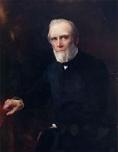
In 1650 Irish Archbishop James Ussher (Usher) (1581-1656) pub. Annals of the Old Testament, Deduced from the First Origins of the World: The Chronicle of Asiatic and Egyptian Matters Together Produced from the Beginning of Historical Time up to the Beginnings of Maccabees (Annales Veteris Testamenti, a Prima Mundi Origine Deductim, una cum rerum Asiaticarum et Aegyptiacarum chronico, a temporis historici principio usque ad Maccabaicorum initia producto), a 1.6K-page Latin tome that uses the Bible to date the creation of the world to nightfall (6:00 p.m.), Sunday, October 22, 4004 B.C., which jives with the Bible verse "One day is with the Lord as a thousand years, and a thousand years as one day" (2 Peter 3:8), meaning that Jehovah gave the Earth 6K years and it's running out fast; he dates the birth of Christ to 4 B.C.E.; it is later used in annotated eds. of the King James Bible, making it super-popular; by the late 19th cent. scientists and theologians begin to ditch it, with Am. Hebrew scholar Wiliam Henry Green (1825-1900) pub. the soundbyte in the influential article Primeval Chronology in Bibliotheca Sacra (1890): "We conclude that the Scriptures furnish no data for a chronological computation prior to the life of Abraham, and that the Mosaic records do not fix and were not intended to fix the precise date either of the Flood or of the creation of the world" - a Christian would say Sunday not Saturday or Friday?

In 1663 Widford, Hertforshire, England-born Puritan missionary John Eliot (1604-90), known as the Apostle to the Indians pub. The Holy Bible Containing the Old Testament and the New Translated into the Indian Language and Ordered to be Printed by the Commissioners of the United Colonies in New England in Cambridge, Mass., a tr. of the Geneva Bible into Algonquian (Natick), becoming the first Bible printed in North Am.

In 1669-76 English Nonconformist theologian Matthew Poole (1624-79) pub. Synopsis Criticorum (5 vols.), which summarizes the views of 150 Bible critics; he dies leaving the unfinished "English Annotations on the Holy Bible" 2 vols.) (1685).
In 1671 the first Arabic ed. of the Bible is printed in Rome.
In 1678 Dieppe-born French Roman Catholic Oratorian priest Richard Simon (1638-1712) pub. Histoire critique du Vieux Testament (3 vols.), claiming that Moses could not be the author of the Books of Moses, inaugurating the modern era of scientific Bible criticism; too bad, the French royal council orders the first printing of 1.3K destroyed; "a mass of impieties and a rampart of free-thinking (libertinage)" (Jacques Benigne Bossuet). In 1689 he pub. Histoire critique des versions du Nouveau Testament, followed by Histoire critique des principaux commentateurs du Nouveau Testament depuis le commencement du Christianisme jusques a notre tems. (1693), Nouvelles Observations sur le texte et les versions du Nouveau (1695), and his Trevoux New Testament, pissing-off the Church by casting doubt on traditional readings; in 1897 Pope Leo XIII condemns five of Simon's works.
In 1684 the Vatican removes the Apocrypha (14 books) from the Bible.
In 1707 Oxford prof. John Mill (1645-1707) pub. Novum testamentum græcum, cum lectionibus variantibus MSS. exemplarium, versionum, editionum SS. patrum et scriptorum ecclesiasticorum, et in easdem nolis (Ocford); pub. after 30 years of work, documenting over 30K discrepancies between 100 extant New Testament mss., shocking the Christian world that had relied on Erasmus' 1516 Textus Receptus; he dies of a stroke 2 weeks after pub.
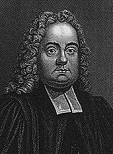
In 1708 Welsh Nonconformist minister Matthew Henry (1662-1714) pub. Exposition of the Old and New Testaments (6 vols.), which makes fans of George Whitefield, Charles Spurgeon, and John Wesley.
In 1716 the first ed. of the Kings James Bible is pub. in Ireland, becoming the Sin On Bible when the pop-up porno ad "sin on more" is printed for John 5:14 instead of "sin no more", and 8K copies are printed before the mistake is discovered.
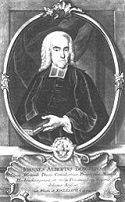
In 1734 German Lutheran pietist scholar Johann Albrecht Bengel (1687-1752) pub. a Greek New Testament, making use of his principle "Proclivi scriptioni praestat ardua" (The difficult reading is to be preferred to that which is easy), which is adopted by Bible scholars; too bad, he predicts Armageddon in 1836 despite Matt. 24:36 ("Of that day and hour no one knows").
In 1735 the Bible is trans. into Lithuanian.

In 1740 Italian historian Father Ludovico Antonio Muratori (1672-1750) pub. The Muratorian Fragment; from a ms. codex of 76 11 in. x 7. in. parchment leaves he discovered in the Ambrosian Library, produced in the Bobbio Monastery near Piacenza in N Italy in the 8th cent., then moved to the Ambrosian in the early 17th cent.; 85 lines of leaves 10-11 is the celebrated fragment, containing the oldest canon of the Christian Greek scriptures, later dated to 170-200 C.E., about the time of Rome-based Christian writer Hippolytus (170-235).

On hot-hot-hot July 8, 1741 the Great Awakening reaches a peak as Jonathan Edwards (1703-58) delivers his Sinners in the Hands of an Angry God speech in Enfield, Mass., featuring lurid word pictures of Da Judge Bible God Jehovah, who "holds you over the pit of Hell, much as one holds a spider, or some loathsome insect, over the fire, abhors you, and is dreadfully provoked... He looks upon you as worthy of nothing else, but to be cast into the fire"; the Great Awakening splits New England Puritanism into the "Old Lights" and the "New Lights", who go over to the Baptists, Presbyterians, or Methodists; the Am. colonies are prepared for rev. by the Great Awakening?
In 1743 German immigrant Christopher Saur pub. a German language Bible, becoming the first Euro language Bible printed in North Am.; in 1763 he pub. the first Bible using paper manufactured in North Am.; in 1776 he pub. the first Bible printed from type manufactured in North Am.
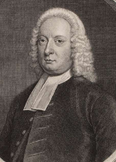
In 1746-8 English Baptist minister (Calvinist) John Gill (1697-1771) pub. An Exposition of the New Testament (3 vols.), followed by "Exposition of the Old Testament" (6 vols.) (1748-63), becoming his magnum opus, earning him an honorary doctor of divinity degree from the U. of Aberdeen in 1748, making him the first major Baptist theologian.
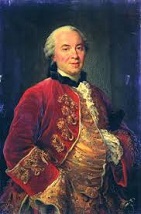

In 1749-89 French scientist ("Father of Natural History") George-Louis Leclerc, Comte de Buffon (1707-88) pub. Histoire Naturelle, générale et particulière, avec la description du Cabinet du Roy (36 vols.) (8 more vols. pub. posth.), which becomes an internat. hit, shocking Bible-thumpers with the claim that the Earth has been developing for at least 75K years via "organic particles", pointing out similarities but not the common ancestry of humans and apes while entertaining it as a hypothesis, preparing peoples' minds for the advent of Darwinism, Anthropology, etc.; too bad, he views the Caucasian race of Adam and Eve as the pinnacle, and all other races as a degenerated version caused by climate, etc. - if they only coulda seen U.S. Pres. George W. Bush?
In 1763 the Isle of Man makes urgent appeals for a Manx trans. of the Bible, since two-thirds of the inhabitants only speak that language; the first translations of different books of the Bible appear in 1748.

On Mar. 1, 1768 German Enlightenment philosopher Hermann Samuel Reimarus (1694-1768) dies in Hamburg after founding Deism, which denies the existence of the supernatural and considers God to be the Great Watchmaker of the Universe, who created it and set it in motion then left it alone; he also leaves the first critical historical analysis of Jesus Christ, arguing that he simply wanted to found a godly state, and died in despair when he failed, with the idea that he died to atone for mankind's sins attributed to St. Paul, making Jesus the teacher of a "remarkable, simple, exalted, and practical religion"; in 1774 he posth. pub. posth. pub. Criticism of the Gospels, questioning their historicity and authenticity, launching theology-and-doctrine-free Higher (Historical) Criticism; Thomas Paine takes on the job of bringing it down to the masses?

In 1769-81 Italian Biblical scholar Antonio Martini (1720-1809) pub. Italian trans. of the Vulgate Bible, becoming the first officially authorized by the Roman Catholic Church, and for the next 150 years the only version approved for Italian Catholics; in 1781 Pope Pius VI appoints him archbishop of Florence - how many years before there is an Italian democratic revolution?
In 1782 the first English language Bibles are printed in North Am. - copyright pirates?

Hey now, you're an all-star, get your game on? In 1793 Thetford, Norfolk, England-born Am. Founding Father Thomas "Tom" Paine (1737-1809) pub. The Age of Reason; Being an Investigation of True and Fabulous Theology (1794, 1795, 1807); bestseller in the U.S. written just before being thrown into prison in France, pub. with the help of his friend Joel Barlow; a rabble-rousing Rationalist Deist attacks the divine origin of the Bible, becoming the Infidel's Bible, setting the 19th cent. up for secularism and belief in scientific progress as a replacement religion for Christianity, with pithy soundbytes incl.: "Belief in a cruel God makes a cruel man"; "One good schoolmaster is of more use than a hundred priests"; "I do not believe in the creed professed... by any church that I know of. My own mind is my own church"; "The story of the whale swallowing Jonah... borders greatly on the marvelous, but it would have approached nearer to the idea of a miracle if Jonah had swallowed the whale"; "It is wrong to say that God made rich and poor; he made only male and female, and gave them the whole earth for their inheritance"; he gets widely accused of being an atheist, when actually he attacks atheism in the book and supports Deism, but the bigoted religious reaction (which incl. most of his old Am. friends, incl. Washington) causes his place in the pantheon of Am. Founding Fathers to get tainted, and later the infidels strike back by attempting to paint all the U.S. Founding Fathers (incl. Bible-thumping Washington) as Deists and overdo separation of church and state? - was Paine their "rabbit", writing what they all believed but couldn't openly express, or was he just out on a limb, too extreme but holding onto the Founding Father main trunk for support?
On Mar. 7, 1804 The British and Foreign Bible Society is founded by William Wilberforce, Thomas Charles et al., later shortening its name to Bible Society.

On Aug. 22, 1812 after learning Arabic and posing as a Muslim for safety, Swiss Orientalist and traveler Johann Ludwig (Jean Louis) Burckhardt (1784-1817) discovers the ancient Nabataean city of Petra in Jordan 50 mi. S of the Dead Sea, starting with Al-Khazneh (Arab. "The Treasury), going on to found Biblical Archeology.
In 1814 the first Hebrew Bible printed in North Am. is pub. by William Fry of Philly.

In 1833 starving but cunning English linguist George Henry Borrow (1803-81) is hired by the British and Foreign Bible Society in London to trans. the New Testament into the Manchu language, which he does this year after learning the language in 19 weeks.; too bad, the Chinese govt. prohibits its importation - hun how? In 1838 he pub. the Gospel of Luke in Gitano (Gypsy) in Spain, prompting one scared Roman Catholic bishop to remark, "He will convert all Spain by means of the gypsy language"; he also pub. the same gospel in Spanish Basque.
In 1835 the first trans. of the Bible into Tahitian is made.
In 1835 the Malagasy Bible is the first vers. pub. for an African country (Madagascar) in movable type.
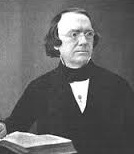
In 1841 after traveling to Palestine in 1838, Southington, Conn.-born Biblical archeologist ("Father of Biblical Geography/Archeology/Palestinology") Edward Robinson (1794-1863) pub. his magnum opus Biblical Researches in Palestine, Mount Sinai and Arabia Petraea (and the Adjacent Regions) (3 vols.), pioneering Biblical geography by identifying numerous Bible sites for the first time incl. Robinson's Arch in Jerusalem; he returns in 1852, pub. an enlarged ed. in 1856.

In 1844 German Bible scholar Lobegott Friedrich Constantin (von) Tischendorf (1815-74) journeys to the wilderness of Sinai and finds an ancient copy of the New Testament, the Epistle of Barnabus, and about half of the Greek Septuagint (incl. the complete Deuterocanonical vols.) in the wastebasket of St. Catherine's Monastery dating to 325, (the oldest yet discovered), and takes away only 43 sheets; he returns in 1853 and finds only a further fragment; it becomes known as the Codex Sinaiticus



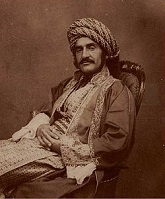
In 1845 in an effort to verify the stories in the Bible, British archeologist Sir Austen Henry Layard (1817-94) begins excavating the ruins of Nimrud (Calah) S of Mosul on the banks of the Tigris River in N Iraq, discovering the palace of Shalmaneser III (r. -859 to -824) along with the Nimrud Ivories, going on to reveal a non-Biblical civilization that existed long before the Bible was allegedly written, with the first known stories of a global flood complete with ark; in 1847 he discovers the lost ancient Assyrian capital of Nineveh N of Mosul, Iraq (destroyed in 612 B.C.E. by the Babylonians and Medes) on the Mound of Kuyunjik (ancient Mespila) (site of an Islamic shrine and cemetery), and in 1851 uncovers the lost royal Library of Assurbanipal (7th cent. B.C.E.), filled with thousands of clay tablets, incl. the Epic of Gilgamesh, sending 24K fragments to London, where they are displayed during the 1851 London Grand Exhibition and start an Assyrian fashion craze; too bad, he jumbles the tablets, making later reconstruction of their texts impossible; other discoveries made between 1842-54 by Layard and Sir Henry Creswicke Rawlinson (1810-95) of Britain, Mosul consul Paul-Emile (Paul-Émile) (Paolo Emiliano) Botta (1802-70) and Victor Place (1818-75) of France, and ethnic Assyrian Hormuzd Rassam (1826-1910) of Mosul in Nineveh, Sharrukin, and Calah slowly uncover the existence of the heretofore unknown ancient Sumerians, starting with Rawlinson independently deciphering the Behistun Stone last year; Irish clergyman Edward Hincks (1792-1866) determines that some of the Akkadian cuneiform inscriptions are in a non-Semitic language, which is later (1869) determined to be Sumerian; too bad, in 1855 Botta's successor Victor Place tries to send 235 cases of artifacts to Basra en route to Paris, but pirates ram the main barge and sink it, and only some rafts survive, the contents ending up in the Louvre and British Museum.

The Origin of Species year is also a big year for Bible believers? In 1859 Ukrainian-born Karaite scholar Abraham Firkovich (1786-1874) sells a vast collection of 2,412 items culled from the Crimean cliff dwellings of Chufut-Kale, where old Bible scrolls are never destroyed but stored in genizahs (hiding places), incl. 975 mss. and scrolls, 45 of them Bible mss. dating before the 10th cent. C.E., and especially the 916 C.E. Petersburg Codex of the Latter Prophets and the 1008 C.E. Leningrad Codex (basis for most modern critical eds. of the Hebrew Bible) to Russian tsar Alexander II for 125K rubles, and he houses them in the Imperal Library in St. Petersburg.
In Mar. 1860 English publisher John William Parker (1792-1870) (ed.) pub. Essays and Reviews, a collection of seven articles by six evolution-infected Oxford and Cambridge Anglican clergymen (Benjamin Jowett, Mark Pattison, Baden Powell, Frederick Temple, Rowland Williams, Henry Bristow Wilson) and one layman (Charles Wycliffe Goodwin) that sells 22K copies in two years (same that Darwin's book sells in 20 years) and stirs up a 5-year controversy over religious faith in Victorian society by publicizing the German Higher Criticism of the Bible incl. how Moses didn't write the Books of Moses, and David didn't write the Psalms, recommending that the Bible be read like any other book and denying the possibility of miracles and calling belief in them atheistic, and slamming the cosmogony in Genesis; appears 4 mo. after pub. of Charles Darwin's "On the Origin of Species"; Bible-thumpers incl. Oxford Bishop Samuel Wilberforce get pissed-off, calling the authors "the Seven Against Christ" and getting two of them charged with heresy, causing Darwin, geologist Charles Lyell, and mathematician William Spottiswoode to sign an open letter supporting the book as trying to "establish religious teachings on a firmer and broader foundation"; "Let E = Essays, and R = Reviews: then the locus of (E + R), referred to multilinear coordinates, will be found to be a superficies (i.e., a locus possessing length and breadth, but no depth)" (Lewis Carroll); "Outwardly, the conflict ended inconclusively, with the acquittal of Williams and Wilson by the courts and the condemnation of the volume by the clergy in Convocation. At a deeper level, it marked the exhaustion both of the Broad Church and of Anglican orthodoxy and the commencement of an era of religious doubt." (Josef L. Altholz)

The Russkies one-up the English with a better Bible? In 1862 after Tsar Alexander II patronizes a mission to Sinai, in the late 1850s German scholar Lobegott Friedrich Constantin von Tischendorf (1815-74) returns with the Codex Sinaiticus, one of the oldest Bible mss. ever discovered (4th cent. C.E.), found in St. Catherine's Monastery on Mount Sinai in 1844; it is pub. by order of the tsar to critical acclaim; "Providence has given to our age... the Sinaitic Bible, to be to us a full and clear light as to what is the real text of God's Word written, and to assist us in defending the truth by establishing its authentic form."

In 1863 Enfield, England-born lexicographer William Smith (1813-93) (ed.) pub. Smith's Bible Dictionary (A Dictionary of the Bible) (3 vols.), becoming a hit, spawning knockoffs and derivative versions; a 4-vol. ed. is pub. in 1893 under the title "A dictionary of the Bible comprising its antiquities, biography, geography, and natural history".
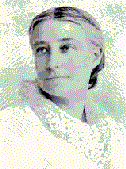
In 1868 Andover, Mass.-born corset-burning feminist-animal rights activist Elizabeth Stuart Phelps Ward (1844-1911) pub. novel #4 The Gates Ajar, a bestseller (180K copies) depicting Heaven as a domicile in the clouds where families are reunited with their pets and carry on domestic life, becoming the #2 bestselling religious novel of the 19th cent.; followed by the bestsellers "Beyond the Gates" (1883) and "The Gates Between" (1887), completing her Spiritualist Trilogy.
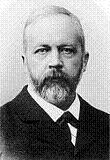
In 1878 Hamelin, Hanover-born German Bible scholar Julius Wellhausen (1844-1918) pub. Prolegomena to the History of Israel, Vol. 1 (Prolegomena zur Geschichte Israels, Bd. 1) (2nd ed. 1883) (3rd ed. 1886) (5th ed. 1899) (English trans. 1883, 1891) (2nd vol. in 1894), advancing the Graf-Wellhausen (Documentary) Hypothesis for the Torah, namely, that it is a compilation of independent works by the Jahwist (J), Elohist (E), Deuteronomist (D), and Priestly (P) sources, dating J to the Solomonic period (950 B.C.E.), E to the 9th cent. B.C.E., D just before the reign of King Josiah in the 7th-8th cent. B.C.E., and P to Ezra's day in the 5th cent. B.C.E., which becomes the std. for Bible scholars until the mid-1970s, which date J to the Baylonian captivity (597-539 B.C.E.) at the latest, and reject the E source, finding the D and P sources doubtful.


In 1881 Birmingham, England-born bishop of Durham (1890-1901) Brooke Foss Westcott (1825-1901) and Dublin, Ireland-born Fenton John Anthony "F.J.A." Hort (1828-92) pub. The New Testament in the Original Greek (2 vols.); the result of 28 years of joint labor, favoring the Vaticanus and Sinaiticus mss., and using the combination of Codex Bezae with the Old Latin and the Old Syriac as closer to the original, especially when it is shorter than other forms of the text, such as the majority of the Byzantine text; espouses Hort's doctrine of Western non-interpretations, preferring the Alexandrian text over the larger Western text and the Byzantine text, which is a combo; pioneers the principle of Lectio brevior potior (Lat. "the shorter reading is the stronger"); "Knowledge of Documents should precede Final Judgments upon Readings"; "[It is] our belief that even among the numerous unquestionably spurious readings of the New Testament there are no signs of deliberate falsification of the text for dogmatic purposes"; "Our object is to supply clergymen generally, schools, etc., with a portable Greek Testament, which shall not be disfigured with Byzantine corruptions" (Hort, Apr. 9, 1853) - it takes all this time to get Jesus' words right?
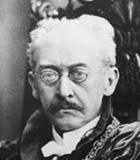
In 1886 Dorpat, Livonia (Tartu, Estonia)-born liberal German Lutheran theologian Carl Gustav Adolf von Harnack (1851-1930) begins pub. History of Dogma (Lehrbuch der Dogmengeschichte) (7 vols.) (1886-98), espousing a liberal German view of the Gospels, claiming that from the start Christian faith was intermingled with Greek philosophy, thus Protestants are bound to criticize it. In 1893 he pub. History of Early Christian Lit. down to Eusebius of Caesaria (Geschichte der altkirchlichen Literatur bis Eusebius). In 1902 he pub. The Mission and Expansion of Christianity in the First Three Centuries (Die Mission und Ausbreitung des Christentums in den ersten drei Jahrhunderten) (3 vols.). In 1906 he pub. Contributions to the Introduction to the New Testament (Beitrage zur Einleitung in das neue Testament). In 1907 he pub. Luke the Physician. In 1908 he pub. The Sayings of Jesus. He goes on to reject the Gospel of John as unhistorical, and diss Old Testament miracles while leaving a door open to New Testament healing miracles, with the soundbyte: "That the earth in its course stood still; that a she-ass spoke; that a storm was quieted by a word, we do not believe, and we shall never again believe; but that the lame walked, the blind saw, and the deaf heard will not be so summarily dismissed as an illusion." On Oct. 4, 1914 Harnack co-signs the Manifesto of the Ninety-Three (To the Civilized World), endorsing Germany's war aims incl. the Rape of Belgium, galvanizing German support for the war in schools and univs. while pissing-off foreign intellectuals incl. his student Karl Barth, causing him to reject liberal theology.

In 1890 Scottish U. of Aberdeen archeologist-scholar Sir William Mitchell Ramsay (1851-1939) pub. The Historical Geography of Asia Minor, based on his travels to Asia Minor, becoming the first to give a definite location to many of the cities mentioned in the Book of Acts, making him the #1 authority on New Testament geography. His wide travels in Asia Minor made him the recognized authority on all matters relating to the districts associated with St Paul's missionary journeys and on Christianity in the early Roman Empire. Greece and Turkey remained the focus of Ramsay's research for the remainder of his academic career. In 1883 Ramsay discovered the world's oldest complete piece of music, the Seikilos epitaph. In 1890 he discovered inscriptions in the unknown Anatolian language called Pisidian, a description of which he published in 1895. In the 1890s he he discovered two of the most important Phrygian monuments, the rock tombs "Aslantas" (Lion Stone) and "Yilantas" (Snake Stone), located close to the city center of Afyon. In 1915 he pub. The Bearing of Recent Discovery on the Trustworthiness of the New Testament (4th ed. 1920), containing the soundbytes: '"Further study... showed that the book (of Acts) could bear the most minute scrutiny as an authority for the facts of the Aegean world, and that it was written with such judgment, skill, art and perception of truth as to be a model of historical statement": "You may press the words of Luke in a degree beyond any other historian's". Starting out as a Tubingen School skeptic, he concluded that all thirteen New Testament letters ostensibly written by Paul were authentic.

On July 1, 1899 three Protestant U.S. traveling salesmen incl. Samuel E. Hill, John H. Nicholson, and William J. Knights found Gideons Internat. at the YMCA in in Janesville, Wisc. to evangelize the Gospel, placing their first free King James Bible in the Superior Hotel in Superior, Mont. in 1908, going on to expand worlwide, expanding to 300K members and placing their billionth Bible in 2001 and their 2nd billionth Bible in Apr. 2015; their logo is a 2-handed pitcher and torch as used in Gideon's V over the Midianites in Judges Ch. 7 - Millennium Fever again?

In 1899-1903 English liberal Biblical scholar-critic Thomas Kelly "T.K." Cheyne (1841-1915) and Scottish Biblical scholar Rev. John Sutherland "J.S." Black "J.S.B." (1846-1923) (eds.) pub. Encyclopedia Biblica: A Critical Dictionary of the Literary, Political and Religion History, the Archeology, Geography and Natural History of the Bible (20M words), which embodies the advanced conclusions of English Biblical criticism, becoming a std. work.; in 1912 Cheyne converts to the Baha'i Faith.
On Nov. 5-8, 1901 the 1901 Athens Student Gospel Riots in Greece begins over the pub. by the Athenian newspaper The Acropolis of a modern Greek trans. of the Gospel of Matthew by Alexandros Pallis (1851-1935), and the govt. topples under ultra-conservative Greek Orthodox Christian religious pressure, launching a long period of hostility between the Church and the demoticist movement.

In 1909 Clinton Township, Mich.-born Cyrus Ingerson Scofield (1843-1921) pub. the Scofield Reference Bible (Oxford U. Press), the first Bible ed. since the 1560 Geneva Bible with commentary alongside the text, popularizing John Nelson Darby's Dispensationalism and Futurism, with chain references; the 1917 ed. adds Archbishop James Ussher's 4004 B.C.E. Bible chronology, becoming many readers' first encounter with it; the fortunate coming of WWI boosts sales, reaching 2M by the end; makes fans of Tim LaHaye, Hal Lindsey, and Edgar C. Whisenant.
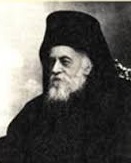
On Mar. 10, 1924 after new (since 1923) Greek Ecumenical Patriarch of Constantinople Gregory VII (1850-1924) overcomes strong religious opposition and dumps the Julian Calendar and introduces the use of the 1582 Gregorian Calendar in the Greek Orthodox Church, Mar. 9 is followed by Mar. 23; in Mar. he also assumes jurisdiction of Greek Orthodox Christians living in the Greek Diaspora (Australia, New Zealand et al.); the Greek Orthodox Church finally repeals its prohibition against using modern Greek translations of the Bible.
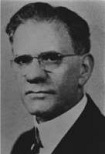
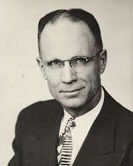
In 1930 English-born Seventh-day Adventist Benjamin George Wilkinson (1872-1968) pub. Our Authorized Bible Vindicated, criticizing the Westcott and Hort Bible trans. as corrupted by Origen's version of the Septuagint, as well as deletions and changes from the Codex Vaticanus and Codex Sinaiticus that are based on corrupted Alexandrian text, praising the King James version that is based on the Byzantine Greek Textus Receptus, causing Am. fundamentalist Baptist pastor David Otis Fuller (1903-88) to take up his cause in his 1970 book Which Bible? (5th ed. Aug. 1, 1997), launching the King James Only Movement.; Fuller also pub. True or False? The Westcott-Hort Textual Theory Examined (1973), Counterfeit or Genuine? (1978), and The Evils of Elvis Preslyism.
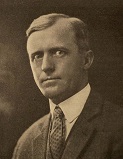
In 1935 Maud, Okla.-born atty. Charles Lee Smith (1887-1964), 1925 founder of the Am. Assoc for the Advancement of Atheism (4As) pub. the pamphlet The Bible in the Balance, dissecting the Bible and exposing its many errors, contradictions, and absurdities, becoming a bestselling pamphlet distributed by atheist rabble-rousers the same way the Gideons distribute King James Bibles; in 1928 after putting a sign on his store front window in Little Rock, Ark. reading "Evolution Is True. The Bible's a Lie. God's a Ghost" and/or "There Is No God", he becomes the last person to be convicted of blasphemy in the U.S. (until ?).


In early 1947 11 Dead Sea Scrolls are discovered by 15-y.-o. Bedouin shepherd Muhammad adh-Dhib (Arab. "the wolf") (George Herbert's Muad-dib?) in a cave above Qumran 1 mi. from the NW shore of the Dead Sea in caves 1Q and 3Q on the Qumran Waddy near ancient Khirbet, Palestine, built ca. 100 B.C.E. and destroyed by the Romans ca. 68 C.E.; the Syrian Orthodox Monastery of St. Mark in Jerusalem buys five of them in 1948, and the Hebrew U. of Jerusalem buys the other six; 972 texts are discovered by 1956; in spring 1948 Am. archeologist John C. Trever (1916-2006) of the Am. School of Oriental Research in Jerusalem examines fragments, and discovers the oldest known copy of the Book of Isaiah (100 B.C.E.) among them, 1.4K years older than the next oldest in existence (1300 C.E.), proving that the text of the Old Testament has survived virtually intact after all these cents.; Am. archeologist William Foxwell Albright (1891-1971) of Johns Hopkins U. calls it "the greatest manuscript discovery of modern times"; the Israeli govt. later launches Operation Scroll to survey all the caves in the area, discovering hundreds of parchment and papyrus scrolls and scraps, discovering a 12th cave in 2016.

On June 17, 1963 the U.S. Supreme (Warren) Court rules 8-1 in Abington School District v. Schempp to strike down rules requiring the recitation of the Lord's Prayer or reading of Biblical verses in public schools (along with similar laws in four other states, and optional Bible reading laws in 25 states; 11 states had their laws declared unconstitutional by state courts) after primary student Ellery (Ellory) Schempp (1940-) and his Unitarian Universalist father Edward Schempp (1908-2003) (Unitarian-Universalists) protested then sued the Abingdon Township School District in Penn. in 1956 to stop the obligatory reading of 10 verses of the Bible plus the Lord's Prayer on each school day; after founding American Atheists (originally Society of Separationists), Pittsburgh, Penn.-born Madalyn Murray O'Hair (1919-95) ("The most hated woman in America" - Life mag.) enters the spotlight in a parallel case, Murray v. Curlett, seeking to have obligatory Bible reading stopped in Baltimore, where her son William J. "Bill" Murray III (1946-) (who later becomes a Baptist minister) is enrolled; the two cases are combined, and Schempp's case is chosen as primary because Unitarians are a larger group than Atheists; Bible teaching is still okay as long as it is "taught objectively as part of a secular program", but fears of the ACLU plus growing illiteracy result in only 8% of U.S. public schools offering Bible courses by the end of the cent.; Charles Lee Smith, pres. of the Am. Assoc. for the Advancement of Atheism and ed. of The Truth Seeker mag. donates $5K to O'Hair, which backfires later when he dies and she tries to take it over until a judge stops her.
In 1966 the Am. Bible Society pub. the bestseller Good News for Modern Man: The New Testament in Today's English, which sells 30M copies by 1971, spawning the Jesus Freaks mass movement in the U.S. (ends mid-1970s); the Old Testament is pub. in 1976.
In 1970 the charred 1st cent. Ein Gedi Scrolls are discovered by archeologist Yosef Porath in an burned-down Essene synagogue near the Dead Sea; in 2015 the Israel Antiquities Authority's Dead Sea Scrolls Preservation Lab in Jerusalem uses 3-D X-ray computer tomography to reconstruct the text, finding it to be identical to the Book of Leviticus in use today.
In 1975 the bi-monthly mag. Biblical Archaeology Review begins pub. for gen. public by the Biblical Archaeology Society (until ?); in 1991 the society pub. a facsimile ed. of the Dead Sea Scrolls, pissing-off the small clique of specialists who thought they owned them.
In 1978 Zondervan Pub. House (Int. Bible Soc.) pub. New International Version of the Bible (revised in 2002), which becomes the Bible of choice for the evangelical crowd, and accounts for one in three of all Bible sales; too bad, the fact that Zondervan's owner Harper Collins also pub. "The Joy of Gay Sex" and "The Satanic Bible", and the fact that the trans. is Arian-leaning pisses-off some Bible-thumpers?
In 1979 Pope John Paul II decrees that the New Vulgate Bible is to be used in Roman Catholic liturgy.
On Oct. 14, 1983 the Nat. Council of Churches releases the Inclusive Language Bible, with new PC language calling God both Father and Mother, or the One, and replacing humanity with humankind, causing the Lutheran and Greek Orthodox Churches to refuse to use it; it becomes a flop.
In 1994 archeologists discover a 9th cent. B.C. stele near Tel Dan in N Israel containing a reference to the "House of David", erected to celebrate the V of an Aramean king (Hazael?) over the Israelites; in 1 Kings ch. 19 Elijah anoints Hazael as king of Aram; skeptics are forced to admit the historicity of King David.

In 2005 Lawrence, Kan.-born New Testament scholar Bart Denton Ehrman (1955-) pub. the NYT bestselling book Misquoting Jesus: The Story Behind Who Changed the Bible and Why (Whose Word Is It?), exposing the New Testament's dirty laundry of inconsistent and unsure text, making it impossible to know what it really says, even in matters of basic doctrine, pissing-off Bible-thumpers, who mainly studiously ignore him?; watch video.
On Sept. 16, 2008 Vatican spokesman Archbishop Gianfranco Ravasi announces that Darwin's Theory of Evolution is compatible with the Bible, but plans no posth. apology to Charles Darwin (1809-82), while announcing a Rome conference next Mar. for the 150th anniv. of his "Origin of Species".
On Apr. 19, 2018 the men's mag. GQ pub. the article 21 Books You Don't Have to Read (Before You Die), trashing 20 books incl. Mark Twain's "Huckleberry Finn", and the Bible, which it calls "repetitive, self-contradictory, sententious, foolish, and even at times ill-intentioned"; "The Holy Bible is rated very highly by all the people who supposedly live by it but who in actuality have not read it. Those who have read it know there are some good parts, but overall it is certainly not the finest thing that man has ever produced."
In 2018 Montclair State U. prof. Jeffrey Alan Miller discovers the earliest draft of the King James Bible, covering the apocryphal books of Esdras and Wisdom, showing that translators worked entirely on their own not as a team.